






















M’shenichnas Adar marbim b’simcha. As Adar comes in, you should increase your joy.
The joy in my house has been increasing for the past few weeks – way before Adar hit the calendars. There’s been talk of costumes and mishloach manos and shtick that needs to be bought. And the ideas have been ever-changing. One week, one kid is talking about being Amish and the next week that same child wants to be an Indian princess – yes, I know, I wasn’t even aware that India has princesses.
I get caught up in the excitement, too. There’s something fun about dreaming and imagining, wanting to become someone different for the day. Preparing for Purim is a bit like preparing for a play. There are the props and the scenery and the costume design – and don’t forget the food backstage for all the actors. See where I’m going with this?
Finally, after weeks of daydreaming about their costumes, we finally ordered them last night. We used to go to the store to check out what there was to offer. Now, I save myself the trip and order what they want online after much back-and-forth debate. My only hope is that the costumes come on time and that they’re in the right size. If not, we’ll be back at the costume de-
sign department to dream about what else they could be.
When I go into stores nowadays, I am overwhelmed by the nosh on display. The array of colors is dizzying – each package brighter and more flamboyant than the next. And when I think about all the sugar – some of these “candies” are really granules of sugar, just in brighter colors – I become dizzy as well. I almost wish we could go back to the days when the only nosh on the market was Twizzlers and shtreimel cookies. When I express my amazement to my family, my kids roll their eyes: “Mommy, we’re not going to be giving out apples to our friends on Purim!” [That was a literal quote!] Who said anything about apples? But now that they mentioned them, I wouldn’t mind if someone gave me an apple to eat on Purim instead of all the junk.
In any case, in our home, we are certainly bringing in Adar with the heightened excitement of Purim in the air, although it could be that the tasting of all their mishloach manos nosh may just be giving them all a sugar high.
Wishing you a wonderful week, Shoshana
Yitzy Halpern, PUBLISHER publisher@fivetownsjewishhome.comYosef Feinerman, MANAGING EDITOR ads@fivetownsjewishhome.com
Shoshana Soroka, EDITOR editor@fivetownsjewishhome.com
Nate Davis
Editorial Assistant
Nechama Wein
Copy Editor
Rachel Bergida
Shana Brecher
Lani White
Design & Production

Gabe Solomon
Distribution & Logistics
P.O. BOX 266
Lawrence, NY 11559
Phone | 516-734-0858
Fax | 516-734-0857
Classified Deadline: Monday 5:00PM classifieds@fivetownsjewishhome.com

text 443-929-4003
PAYMENT VIA CREDIT CARD MUST BE SUBMITTED ALONG WITH CLASSIFIED ADS
The Jewish Home is an independent weekly magazine. Opinions expressed by writers are not necessarily the opinions of the publisher or editor. The Jewish Home is not responsible for typographical errors, or for the kashrus of any product or business advertised within. The Jewish Home contains words of Torah. Please treat accordingly.
Friday, February 24
Parshas Terumah
Candle Lighting: 5:22 pm
Shabbos Ends: 6:23 pm
Rabbeinu Tam: 6:54 pm

If you want a twenty-minute talk of inspiration that discusses our spiritual purpose in life and how to achieve it, then Rabbi Yaakov Harari can provide it to you. As a sample, here are two ideas he discusses.
He notes that our soul is referred to as kavod derived from the language of the kisei hakovod. We have kavod ingrained in us. This is what pushes us to excel and achieve. But it also brings a desire for kavod, to get the attribution for our great achievements, and that is where the challenge of man lies. One must achieve and bring kavod, but its purpose is to bring kavod Shamayim.
He also notes that the proof that G-d loves us is because He created us. From that baseline, we’re here to accomplish and G-d reaps great satisfaction from our advancement. Indeed, achievement brings glee to the Creator.

These are just a sample of the simple yet revolutionary thoughts that can be found on the “Rabbi Yaakov Harari Podcast.”
Steven GenackCaroline Glick is a master at clearly spelling out an argument and pointing out how the other side can be so uninformed and deluded.
I appreciate that you’ve been publishing her articles – she is a fresh breath of air in this tumultuous time in Israel’s history, when the left is so vociferous in their arguments.
 Reuven Gordon
Reuven Gordon
Every year, I resolve to send a letter to community papers about this idea of mine, but every year, I remember too late. This year, I am right on time.
It occurs to me that Purim is about creating and cementing friendships –we give tzedakah and mishloach manos “ish l’rei’aiyu.” We spend our day running around to friends and family and rebbeim to give them elaborate mishloach manos.
But I opine that these mishloach manos are nice but there are other mishloach manos that could really be given in the true spirit of the day. And those mishloach manos are mishloach manos given to people who are not receiving mounds of goodies on Purim. These people are older, or alone, or are not necessarily part of the community. They sit at home on Purim and look out their window and see all the children dressed up and all the colorful packages being distributed, and their dining room tables are bare. They don’t have people in their lives who think about them on this day and include them in their Purim festivities.
So I am reaching out to the community to remind each person to think of those who are not necessarily remembered –the senior citizen in the apartment building on your corner, the not-yet-frum gentleman who lives around your block, the older woman across the street who doesn’t have family of her own. If you are going to give any mishloach manos this
Continued on page 10

year, these people should be the recipients of those mishloach manos.
You will make their day – and it will be a time of joy for both you and them!
In the zechus of the power of the day of Purim, may we all celebrate joyous occasions – together.
A ReaderDear Editor,
I always love your magazine and enjoy so many articles each week. This week, Faigie Horowitz’s article, “Do Call Them. They Won’t Call You,” has galvanized me to action. I come from a very large family. I am one of thirteen children, and we aren’t all especially close. There are too many of us to be close to all of my siblings. But after reading Faigie’s article I have decided that these people should be my priority. And so I am going to make it my business to call 3-4 of my siblings every week. This way, I will speak with each sibling at least once a month.

We get together on Chanukah but it’s a very large party and not a lot of schmoozing. Some of my siblings I speak with every week. But some of them I never talk to. This way, I will connect with them on a consistent basis.
I want my children to be close to each other. But I realize now that I don’t model that behavior. Hopefully, they will see what I am doing now and will reach out to their siblings as they get older.
Yitzy N.I am happy that you printed this letter in your dating column about the woman with the divorced friend. I think that this lady needs a bop on top of her head. She is looking at her divorced friend and thinking about getting divorced because her friend just did. What is this? Do you also want her osteoporosis diagnosis and her foreclosure proceedings? Why would you wish upon yourself this situation?
And another point: this woman was surprised that her friend got divorced because they looked like the perfect couple. That’s because there are many things that are private and shouldn’t be shared. It’s OK – and very praiseworthy – to not share your marriage troubles with your friends. And it’s also OK and very smart to not share all the reasons you got divorced with your friend. That may be why this woman is confused – the marriage didn’t sound all that bad and not her friend is divorced; maybe she should do it, too?
But that attitude makes me want to scream! What is it with this generation? Why can’t they put in the work and effort and time to work on their marriages? Why is the “D” word the first thought that flits into their minds?
Marriage is amazing – but it requires work on both sides. Minor arguments and disagreements do not mean you should walk away. It means you should take account and try to make your marriage even stronger.
I hope this woman takes a deep breath and realizes the good she has in her life. Unless there is something truly bad, she should work with her husband on making her marriage even better. I would suggest marriage counseling asap. Best of luck,
Y. B.
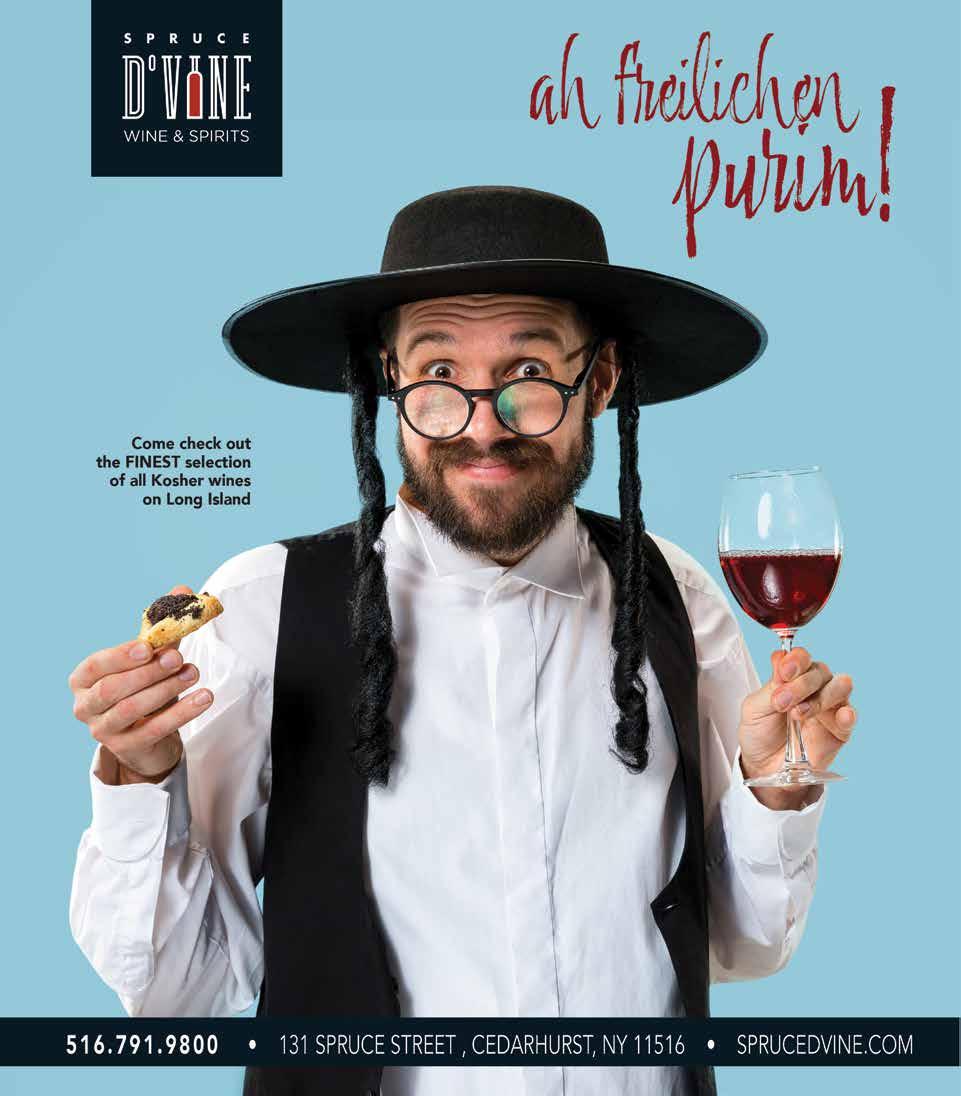


hugged when they met, and Zelenskyy said it was a “great honor” that Biden had come to visit.
In a statement issued by the White House after his arrival, Biden said the U.S. would make another delivery of critical equipment to Ukraine, including artillery ammunition, anti-armor systems and air-surveillance radars.
The new package includes $450 million for weapons, including ammunition for U.S.-provided HIMARS multiple-rocket launchers, Javelin antitank missiles and howitzers, armament that has significantly bolstered Ukraine’s firepower in recent months, and $10 million for repairing energy infrastructure, according to Secretary of State Antony J. Blinken. Air surveillance radars will also be included, he said.
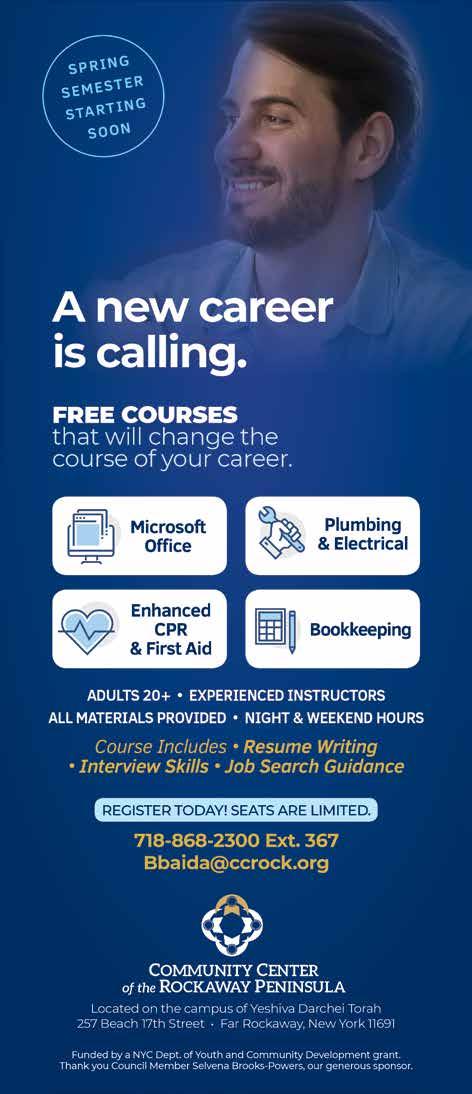
Americans were surprised to learn that their President had secretly slipped into Kyiv on Monday for a historic visit to showcase U.S. solidarity with the people of Ukraine. Of course, the visit came with a price – of half-billion dollars in military aid. During the trip, President Joe Biden declared that Russian leader Vladimir Putin was “dead wrong” in his underestimation of Western support and resolve.
It’s been almost a year since Russia invaded Ukraine – and Biden’s visit came four days before that infamous anniversary.
Although the American people were not told of Biden’s visit in advance, officials made sure to notify Russia to ensure the President’s safety. This is the first time in recent years that an American president traveled to an active war zone not controlled by the U.S. military.
Arriving in Kyiv after a 10-hour overnight train ride from Poland, Biden appeared with Ukrainian President Volodymyr Zelenskyy at the heavily fortified presidential palace. Ukraine’s resilience over the last year, Biden proclaimed, had been “astounding,” and “the whole world sees it.” The U.S., he said, would support Kyiv “as long as it takes” to repel the Russian invasion, which began February 24, 2022.

“That dark night one year ago, the world was literally bracing for the fall of Kyiv … perhaps even the end of Ukraine,” said Biden, clad in a suit with a blue and yellow tie — the colors of the Ukrainian flag. “One year later, Kyiv stands, and Ukraine stands. Democracy stands.… The world stands with you.”
Zelenskyy met with the Western leader while wearing his trademark khaki sweatshirt and pants. The two leaders
Biden arrived late Monday in Warsaw, where he will mark the anniversary of the invasion, meet with allies, and deliver a major address on continued Western efforts to help Kyiv fend off Moscow’s forces. But there had been rumors that he might make an unannounced stop in Ukraine. Biden made the final decision to visit Ukraine on Friday.
Only two reporters were allowed on the plane; they were asked to hand over their phones to maintain secrecy. After they arrived in Poland, the group boarded a six-car train to Kyiv.
The U.S. president spent roughly five hours in Kyiv, which included talks with Zelenskyy. He walked the streets of the capital and made a stop at the U.S. Embassy.
Italy needs rain. Weeks of dry winter weather have raised concerns that the country could face another drought after last summer’s emergency, with the Alps having received less than half of their normal snowfall, according to scientists and environmental groups.
Flooding is generally a concern in Venice, but not now. The city faces unusually low tides that are making it impossible for gondolas, water taxis, and ambulances to navigate some of its famous canals.


The problems in Venice are being blamed on a combination of factors: the lack of rain, a high pressure system, a full moon, and sea currents.

Italian rivers and lakes are suffering from severe lack of water, the Legambiente environmental group said on Monday, with attention focused on the north of the country.
The Po, Italy’s longest river which runs from the Alps in the northwest to the Adriatic, has 61% less water than normal at this time of year.
Last July, Italy declared a state of emergency for areas surrounding the Po, which accounts for roughly a third of the country’s agricultural production and suffered its worst drought for 70 years.
Water levels on Lake Garda in northern Italy have fallen to record lows, making it possible to reach the small island of San Biagio on the lake via an exposed pathway.
Belarusian President Alexander Lukashenko said on Monday he had ordered the formation of a new volunteer defense
league so everyone knows how to “handle weapons” and be ready to respond to an act of aggression and keep public order in peacetime.
the territorial defense force will have 100,000-150,000 volunteers, or more if needed. The paramilitary formation will be ideally in every village and town.
Aside from this new force, the country’s professional army has about 48,000 troops and some 12,000 state border troops, according to the 2022 International Institute for Strategic Studies’ Military Balance.
“These are opportunists that have obviously not thought this situation through before they acted, and have been asking for cash to be paid,” Manning said, adding that authorities are “offering the abductors a way out.”
“The situation is not easy. I have said more than once: every man – and not only a man – should be able to at least handle weapons,” Lukashenko said at the meeting of his Security Council.
“At least in order to protect his family, if needed, his home, his own piece of land and – if necessary – his country.”
Lukashenko has allowed Russia to use Belarus to send troops into Ukraine. Still, he has often said his army would fight only if Belarus was attacked. Even so, he has noted that the “experience” in Ukraine necessitates additional defense.
“In case of an act of aggression, the response will be fast, harsh and appropriate,” Lukashenko said on Monday.
Defense Minister Viktor Khrenin said
Lukashenko is not a darling of the West. As Europe’s longest-serving ruler – leading Belarus for 28 years – Lukashenko depends on Russia politically and economically, and Russian President Vladimir Putin’s support helped him survive mass pro-democracy protests in 2020.

The relationship has fanned fears in Kyiv that Putin would pressure Lukashenko to join a fresh ground offensive and open a new front in Russia’s invasion of Ukraine.
“The elements of the Cold War: arms race and nuclear blackmail by the leaders of individual Western states have returned to the contemporary international agenda,” Lukashenko asserted on Monday.
That same day, U.S. President Joe Biden made a surprise visit to Kyiv to send a message of “enduring support” for Ukraine and announce further military aid for the army of Ukrainian President Volodymyr Zelenskyy.
“They can release their captives and they will be treated fairly through the criminal justice system, but failure to comply and resisting arrest could cost these criminals their lives,” he said.
Papua New Guinea, a Pacific nation of more than 9 million people, shares an island with the restive Indonesian region of Papua.

Earlier this month, a New Zealand pilot was taken hostage by separatist fighters in Papua. Identified by local police as Philip Mehrtens, the pilot was captured after landing a commercial Susi Air charter flight at Paro Airport in the remote highlands of the Nduga regency.
The group previously demanded that all incoming flights to Paro Airport be stopped and said the pilot would not be released until the Indonesian government acknowledged Papuan independence.
Police in Papua New Guinea have launched a rescue mission after a group of foreign citizens and local guides were taken hostage by armed criminals in a remote region of the country.
Among those being held for ransom is an Australian academic.
Police said negotiations are ongoing to secure the hostages’ release and said they would use “all necessary force” to free them.
According to PNG Police Commissioner David Manning, the criminals saw the group “by chance” and took them into the bush.
International Atomic Energy Agency inspectors last week detected uranium enriched to 84% purity in Iran, just below the 90% level needed for nuclear weapons, Bloomberg reported on Sunday.

The report, citing two senior diplomats, said the UN’s nuclear watchdog was trying to clarify how Tehran accumulated the material, which is at the highest level of purity found by monitors in the country to date.
Iran previously told the IAEA that its centrifuges were configured to enrich uranium to 60% purity.
Earlier this month, the IAEA chastised the Islamic Republic for modifying the connection between the two groups of high-tech machines at its Fordow plant that enrich uranium to up to 60% purity.
The modification was discovered

during an unannounced inspection on January 21 at the Fordow Fuel Enrichment Plant (FFEP), a location built into a mountain where inspectors are beefing up checks after Iran said it would drastically increase enrichment.
In a confidential report to member states obtained by Reuters, the IAEA stated that “they were interconnected in a way that was substantially different from the mode of operation declared by
Iran.”
It was unclear exactly where the 84% enriched uranium was found.
The IAEA is currently preparing its quarterly Iran safeguards report ahead of a March 6 Board of Governors meeting in Vienna.
IAEA Director General Rafael Mariano Grossi last month called the moribund 2015 nuclear deal between Iran and world powers an “empty shell” and said Tehran has sufficient nuclear material for
several atomic bombs if it is enriched to weapons-grade levels. (JNS)
The government of Nicaragua has stripped more than 300 political opponents of their citizenship over the past week, in another sign that the country’s
authoritarian president has no intention of easing his grip at home despite a deal, completed days earlier, that freed hundreds of political prisoners and sent them to the United States.
An appeals court justice announced the latest move, to revoke the citizenship of 94 people, on Wednesday, just after the government did the same to the 222 people who were sent to the United States last week.
Although Washington had welcomed last week’s prisoner release, officials in the Biden administration condemned the Nicaraguan government’s latest moves.
Secretary of State Antony Blinken, in a statement, called the stripping of citizenship “another step backward for the Nicaraguan people and a further step toward solidifying an autocratic regime.”
“Those who bravely defend democracy in Nicaragua will always be its citizens and patriots,” he added.

For years, President Daniel Ortega has methodically crushed dissent, cracking down violently on protesters, undermining democratic institutions, and making sweeping arrests.
Stripping citizenship from hundreds of people appeared to be a new tactic of his government, experts said. The decisions were widely condemned.
“It’s a political vendetta against any opposing voices,” said Jennie Lincoln, senior adviser on Latin America for the Carter Center. “This is a cleansing of opposition voices at all levels, from the political elite to the campesino in the pueblo.”

The decision also showed Ortega’s “absolute control of the judiciary and legislature,” said Tamara Taraciuk Broner, acting director for the Americas for Human Rights Watch. “This decision has no precedent in Latin American recent history — Augusto Pinochet, Chile’s bloody dictator, did it with nine people — and should be met with a strong reaction by democratic leaders in the region.”
The justice who announced the latest decision, Ernesto Rodriguez Mejía, declared that the people whose citizenship had been revoked were “traitors to the homeland.” He said they had been found



guilty on charges of “conspiracy to undermine national integrity” and “spreading false news.” He said their property had also been ordered seized.
The list of people affected included a well-known poet, Gioconda Belli; a high-profile journalist, Carlos Fernando Chamorro; a former Sandinista leader, Luis Carrión; and a prominent human rights activist, Vilma Núñez. Most of the people affected appeared to be outside Nicaragua. Núñez, 84, is among those who remain. (© The New York Times)

with the United States.

Putin made the declaration in his much-delayed annual state of the nation address to Russia’s National Assembly on Tuesday.
The treaty puts limits on the number of deployed intercontinental-range nuclear weapons that both the U.S. and Russia can have. It was last extended in early 2021 for five years, meaning the two sides would soon need to begin negotiating on another arms control agreement.
Under the key nuclear arms control treaty, both the United States and Russia are permitted to conduct inspections of each other’s weapons sites, although inspections had been halted since 2020 due to the Covid-19 pandemic.
This announcement is nothing new. Russia is not withdrawing from the pact. And for months, U.S. officials have been frustrated over Russia’s lack of cooperation with the agreement. Still, U.S. Secretary of State Antony Blinken called Putin’s decision “deeply unfortunate and irresponsible.”
facilitate inspection activities on its territory,” a U.S. State Department spokesperson said in January.
were trapped when a building that had survived the initial quake collapsed.
Hundreds of rescuers worked into the early hours of Tuesday morning trying to reach the men, some falling asleep on rubble next to fires to stay warm, as others endured freezing conditions to shift heavy rubble.
In northwest Syria, more than 130 people were injured, the White Helmets volunteer rescue group said.
Officials have been urging the public to stay away from buildings. Turkish Vice President Fuat Oktay earlier Monday asked the public “not to enter the damaged buildings, especially to take their belongings.”
Early this week, Russian President Vladimir Putin said he is suspending his country’s participation in the New START nuclear arms reduction treaty
According to U.S. officials, Russia had already refused on numerous occasions to allow inspections of its nuclear facilities.
“Russia is not complying with its obligation under the New START Treaty to
Major aftershocks are hitting southern Turkey. On Monday, one 6.3 magnitude aftershock struck the southern Hatay province, near the Syrian border, leaving at least six people dead and hundreds more injured. These aftershocks come on the heels of the devastating earthquake on February 6 that killed more than 46,000 people.
At least 294 people were injured in Monday’s aftershocks – 18 of them “seriously,” according to SAKOM.
In the city of Antakya in the country’s southern Hatay province, three men
More than 7,000 aftershocks were recorded in Turkey after the initial earthquake two weeks ago.
Almost 900,000 people are living in tents and containers in Turkey following the disaster and subsequent tremors, according to Turkey’s President Recep Tayyip Erdogan.
Nearly 140,000 buildings collapsed, should be demolished immediately or are heavily damaged, Erdogan said, adding that 115,000 people have been injured by the earthquake.
On Sunday, Turkey’s disaster management authority said it had ended most


search and rescue operations nearly two weeks after the earthquake. Still, miraculously, on Saturday – 296 hours after the initial earthquake struck – a couple and their 12-year-old child were rescued in Hatay.
Turkey is no stranger to strong earthquakes, as it is situated along tectonic plate boundaries. Seven quakes with magnitude 7.0 or greater have struck the country in the past 25 years – but the one on February 6 was the most powerful and deadly.
European leaders. This week, the country justice minister agreed to recommend charges against Frederiksen for “divulging or passing on secrets of importance to the state.”
“The case includes highly classified information that cannot be presented openly,” prosecutor Jakob Berger Nielsen said in a statement. “Regardless of the great public interest, in the opinion of the public prosecutor’s office, there is clearly a heavier consideration to be given to the work of the intelligence service.”
Hjort Frederiksen, 75, had retired from politics in November.
In several interviews in 2020 and 2021, Hjort Frederiksen alleged that the Danish Defense Intelligence Service –which is responsible for overseas activities – had helped the NSA eavesdrop on leaders in Germany, France, Sweden and Norway, including former German chancellor Angela Merkel. He later said he faced preliminary charges for revealing the secret cable cooperation with the U.S.
jority opposed the move because it was not known what he was suspected of.
Hjort Frederiksen was defense minister from November 2016 to June 2019, and earlier held the finance and employment portfolios. For years, he was a senior member of the Liberal Party.

nounced a military draft.
“Everything is changing now, changing very fast,” Putin said Tuesday, referring to the consequences of war and of sanctions. “This is a time of not just challenges, but of opportunities.”
The rosy picture presented by Putin drew plenty of applause from the ruling elites — regional officials, lawmakers, Patriarch Kirill of the Russian Orthodox Church — gathered in a hall across Red Square from the Kremlin. It ignored Russia’s repeated setbacks at the front and its bloody, slow-moving efforts to eke out territorial gains in eastern Ukraine.
Kirill Rogov, a Russian political analyst, said on social media after Putin’s remarks, “The main point of the address, as I saw it, was normalization.”
“A normalization of war,” he wrote. “A normalization of repression.” (© The New York Times)
Claus Hjort Frederiksen, a former defense minister in Denmark, had publicly claimed that Denmark’s secret service helped U.S. intelligence spy on several
In an interview with DR in December 2021, Hjort Frederiksen said, “I must risk a prison sentence” for making the allegations.
In 2022, the government asked lawmakers to remove the parliamentary immunity of Hjort Frederiksen, but a ma-
If much of President Vladimir Putin’s 100-minute state-of-the-nation speech on Tuesday sounded familiar, that was by design: Its purpose, it appeared, was to emphasize to Russians that war is the new normal.
Putin’s only major revelation was that Russia would suspend participation in New START, its last remaining nuclear arms control treaty with the United States — and one that the State Department had already declared Russia to be not compliant with. He did not signal any major change in how he will wage the war in Ukraine: There was no official declaration of war, no announcement of a new draft, and no new threat of using nuclear weapons.
Instead, Putin’s main underlying message was that Russians, and implicitly the Western coalition that opposes him, must prepare for the war to last for years.
Noting that the invasion — which he continued to call a “special military operation” — began one year ago, Putin said in the address to governors and lawmakers gathered in Moscow: “We will solve the tasks before us step by step, carefully and consistently.” Claiming that the West was trying to “shift a local conflict into a phase of global confrontation,” he pledged that “we will respond accordingly.”

His words signaled that Russia was prepared to intensify the fighting, but they sounded far less ominous than the barely veiled threats he made several times last year about the potential use of nuclear weapons. Putin’s tone and diction, too, sounded far more measured than that of his last major speech to the nation, in September, when he an-

Amid much controversy in Israel and around the world, the Knesset passed the first reading of the first bill of the government’s proposed judicial reform by a vote of 63-47 late on Monday night.

If it passes the second and third readings, the controversial bill will alter the makeup of the Judicial Appointments Committee so that the coalition has an automatic majority. It will also bar the High Court of Justice from ruling on appeals against Basic Laws.
Knesset Constitution, Law and Justice Committee chairman MK Simcha Rothman presented the bill.
“The High Court of Justice damaged the status of the judicial system, and this is what is at the heart of the amendments that are being voted on today. The High Court damaged the process of judicial appointments and intervened in legislative processes,” Rothman said.

“The High Court critically damaged the three branches [of government], and thus harmed you, the sovereign. This is what we are coming to fix today,” Rothman asserted.
Opposition leader Yair Lapid expressed his displeasure on Twitter. “Members of the coalition – history will judge you for this night. For the damage to democracy, for the damage to the economy, for the damage to security, it is certain that you are tearing apart the people
of Israel and you simply don’t care.”
There was a lot of drama surrounding the vote. Firstly, ushers checked the bags of some opposition MKs to ensure they didn’t bring in megaphones or other items that could disrupt the proceedings. Yesh Atid MKs also draped Israeli flags around themselves as Rothman began his presentation of the law. Knesset Speaker Amir Ohana ordered the ushers to remove the MKs, saying they were “disrespecting the flag.” They were al-
lowed to return soon after.
Additionally, security guards forcibly removed protesters from the plenum observation gallery after they entered it illegally and beat against the glass walls separating them from the plenary area.
Prime Minister Benjamin Netanyahu wrote on Twitter, “The opposition has gone off its rocker. Ram Ben-Barak disgracefully and scandalously compares the Israeli government to Nazis. Protest leaders tried to jail coalition members
in their homes. Opposition members disgraced the Israeli flag in the Knesset plenum. The opposition has gone off its rocker – and we continue!”
Ben-Barak responded on Twitter:
“Netanyahu, Ben-Gvir and all other sycophants who are riding the wave – look at Wikipedia and see how the Nazi party rose to power supposedly democratically and immediately became a dictatorship. The processes that you are initiating will lead us to a dictatorship as happened in Poland, Turkey, and Hungary – we are next.”
Monday’s vote was significant, as it marked the coalition’s official rejection of President Isaac Herzog’s plan announced last week, which included a freezing of legislation before the first provisions pass their first reading on the Knesset floor.
The vote was also a vital step forward in the legislative process, as what remains will only be the preparation of the bill for its second and third reading, and then to conduct votes on both these readings in one sitting in the Knesset plenum.
It is not clear if the coalition and opposition will be willing to hold a dialogue about the reforms now that the first reading is about to be completed.

More than 15,000 Ukrainians have immigrated to Israel since the outbreak of the war in Ukraine a year ago, according to government figures released Sunday.
The immigration statistics put out by the quasi-governmental Jewish Agency for Israel and the Ministry of Aliya and Integration come five days ahead of the first anniversary of the war, which shows no signs of ending.
“This is one of the largest rescue operations in history,” said Maj. Gen. (res.) Doron Almog, chairman of the Jewish Agency. “It is the epitome of the notion of all of Israel being responsible for one another. Our sense of mutual responsibility serves as a moral compass which has guided us through history and will


continue to do so.”
The new immigrants arrived in Israel with the help of the Jewish Agency and the cooperation of the International Fellowship of Christians and Jews, which established 18 emergency aliyah centers in countries bordering Ukraine immediately after the Russian invasion.
At these centers, the refugees found safe haven. Once they arrived in the Jewish state, they were placed in hotels across the country as part of the government’s “Operation Coming Home,” which was led by the Ministry of Aliyah and Integration.
The Ukrainian immigrants include many young people who enrolled in special absorption programs, mothers with young children, and senior citizens including hundreds of Holocaust survivors.
World Jewry, led by the Jewish Federations of North America and Keren Hayesod, immediately came to the support of the Ukrainian Jewish community, along with help from Christian Friends of Israel (CFI). Tens of millions of dollars were raised in an unprecedented effort to assist the rescue and immigration process.

“When the war broke out in Ukraine, I traveled as a member of Knesset to the refugee centers in Moldova to observe
the aliyah process of those who fled the conflict zones first-hand, said lawmaker Ofir Sofer. “As the minister of aliyah and integration, I saw the importance of welcoming the olim upon their arrival in Israel and assisting in their integration into Israeli society.”
A total of 75,000 olim arrived in Israel in 2022, with the most coming from Russia followed by Ukraine. It was the largest number of new immigrants to arrive in 23 years. (JNS)
countries influenced by Iran.
“Israel looks harshly upon the incident in which the [Foreign Ministry] Deputy Director for Africa, Ambassador Sharon Bar-Li, was removed from the African Union hall despite her status as an accredited observer with entrance badges,” the ministry said in a statement.
“It is sad to see that the African Union has been taken hostage by a small number of extremist countries such as Algeria and South Africa, driven by hatred and controlled by Iran. We call on the African countries to stand against these actions that harm the organization of the African Union itself and the entire continent,” added the statement.
The Foreign Ministry said that the charge d’affaires at South Africa’s embassy in Israel would be summoned for a reprimand.
“The attempt to cancel Israel’s observer status has no basis in the organization’s laws,” said the ministry.
riss Deby Itno.
That same day, Israeli Foreign Minister Eli Cohen traveled to Khartoum, where he met with General Abdel-Fattah al-Burhan, leader of Sudan’s transitional government.
Upon Cohen’s return to Israel, he announced that the two countries would sign a peace agreement this year in Washington.
“Today’s visit to Sudan lays the foundation for a historic peace agreement with a strategic Arab and Muslim country,” said Cohen. “The peace agreement between Israel and Sudan will promote regional stability and contribute to the national security of the State of Israel.”
An Israeli delegation was ejected on Saturday from the African Union’s annual summit in Ethiopia, a move the Israeli Foreign Ministry blamed on “extremist”
Ebba Kalondo, the spokesperson for the African Union’s commission chairman, said Bar-Li had been removed because she was not the accredited Israeli ambassador to Ethiopia, the official who was expected, according to Reuters.
Israel was formally granted observer status in July 2021. Many non-African countries and groups hold the designation, “Palestine” being one of them. Israel had been trying to win back the status for 20 years, since it lost it when the Organization of African Unity was disbanded in 2002 to make way for its replacement organization, the African Union.
At its meeting last year, the 55-member African Union (A.U.) pushed off a vote over Israel’s observer status and instead set up a committee to examine the matter, whose report was due to be presented at the current summit.
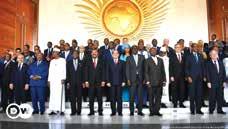
“Until the A.U. takes a decision on whether to grant Israel observer status, you cannot have the country sitting and observing,” Clayson Monyela, head of public diplomacy in South Africa’s department of international relations, told Reuters.
Palestinian Authority Prime Minister Mohammed Shtayyeh addressed last year’s summit, saying that “Israel should never be rewarded for its violation and for the apartheid regime it does impose on the Palestinian people.”
Israeli Prime Minister Benjamin Netanyahu has made enhancing Jerusalem’s relations with Africa a main foreign policy goal. In early February, the prime minister dedicated the Embassy of the Republic of Chad in Israel together with visiting president of Chad, Mahamat Id-
Khartoum first agreed to normalize relations with Israel in October 2020 under the Trump administration, in exchange for Washington removing Sudan from its list of state sponsors of terrorism. In January 2021, it became the fourth country to sign onto the Abraham Accords.
The United Arab Emirates, Bahrain, and Morocco have also joined the accords, although the current development with Sudan is being billed as a peace agreement in the vein of those forged between Israel and Egypt (1979) and Jordan (1994). (JNS)
Even though there has been inflamed tensions between the Israelis and Palestinians over the past few weeks, Prime Minister Benjamin Netanyahu had approved a secret backchannel to maintain contact with the Palestinian Authority, according to a Palestinian official who spoke with The Times of Israel on Monday.
The line of communications was set up last month between National Security Council chairman Tzachi Hanegbi and Palestine Liberation Organization Executive Committee Secretary-General Hussein al-Sheikh.
The official credited U.S. President Joe Biden’s administration with helping facilitate the creation of the backchannel;


U.S. officials passed along al-Sheikh’s request to hold talks with the Israeli premier even before Netanyahu had finalized his government.
Both Hanegbi and al-Sheikh are close confidants of their respective bosses. The two have met at least once in person and have held several phone calls over the past month and a half.
Outwardly, tensions have been simmering between the two groups. Israel has slapped a series of sanctions against the PA for its successful initiative at the UN last month directing the International Court of Justice to present a legal opinion on Israel’s conduct in the territories. Additionally, the PA last month announced a freeze on its security coordination with the IDF following a deadly military raid in the Palestinian city of Jenin.
Hanegbi said Israel has urged the PA to cease all diplomatic initiatives targeting Israel in international forums.

“There is room for dialogue with the Palestinians, and hopefully it will start very soon,” he said.
prehend a suspect. A lone gunman killed six people in a rural Mississippi town on Friday – including his former wife. The suspect was taken in by police after the spree, which began on Friday morning.
On Sunday, police found eleven people shot at two different locations in Memphis. Police were looking for three persons of interest; it is unclear if the people were shot in different areas or were moved after they were injured.
One person was killed and four others – including a four-year-old girl – were injured in a shooting Sunday night along a Mardi Gras parade route in New Orleans. One person was arrested and was charged with second degree murder.

Six people were shot on a Chicago expressway over the weekend.
And that’s just half of the reported mass shooting violence in just three days.
board reportedly put him on leave from his role as chairman amid complaints about his treatment of staff at the organization.
Project Veritas is known for using hidden cameras and hiding identities to try to ensnare journalists in embarrassing conversations and to reveal supposed liberal bias.
“So currently, I have no job at Project Veritas,” O’Keefe said in the video. “I have no position here based upon what the board has done. So I’m announcing to you all that today ,on President’s Day, I’m packing up my personal belongings.”
In a statement released later Monday, the group’s board of directors said it had uncovered “financial malfeasance” and accused O’Keefe of spending “an excessive amount of donor funds in the last three years on personal luxuries.”
There were ten mass shootings from February 17 through February 19 – the most of any weekend so far in the United States. In those shootings, 13 people were killed.
On Friday night, nine children – ages 5 to 17 – were shot and injured at a gas station in Georgia. Police have yet to ap -
The number of shootings over the weekend is unusual for mid-February in the U.S. More than that, the incidents come on the heels of several high-profile mass shootings in California last month, as well as an attack at Michigan State University last week.
Research suggests gun violence in the U.S. typically increases during the warmer months.
Mass shootings in 2022 reached their peak in mid-July, when the U.S. witnessed 15 mass shootings over a regular weekend, according to Gun Violence Archive data. Over the long July Fourth weekend (Friday through Monday), there were 20.
2023 may be even bloodier than 2022. There have been 82 mass shootings this year, compared to 59 at the same time last year.
According to the group, those included “$14,000 on a charter flight to meet someone to fix his boat under the guise of meeting with a donor”; $60,000 in losses from dance events; more than $150,000 “in Black Cars in the last 18 months”; amid other amounts.
According to a statement from the board, O’Keefe was invited to meet with the board to discuss financial issues and staff retention and morale, but he ignored those entreaties.
O’Keefe founded the nonprofit group 13 years ago, and its most recent IRS filings provided to charity regulators in Florida show it brought in more than $20 million in revenue in 2021.
James O’Keefe, founder of Project Veritas, has been booted out of the organization that he created.
In remarks that appeared to have been made at a Project Veritas’ office on Monday, O’Keefe said the board had stripped him of all decision-making. The

An explosion tore through an Ohio metals plant on Monday, scattering molten metal and debris that rained down on neighboring buildings and killed one person, Steven Mullins, 46. Thirteen others were injured, mostly with burns, officials and witnesses said.
The blast sent smoke billowing into the sky that could be seen for miles around the I. Schumann & Co. metals plant about 15 miles southeast of Cleveland.


Thirteen people were taken to hospital, many of them with burn wounds. At least one was in critical condition, and one was pulled from the debris. All of those injured were on site, the falling debris having spared those at neighboring businesses. Many of those at the plant were in shock.
For now, the cause of the explosion is unknown; the damage to the plant is significant.
“We will work alongside investigators
in their search for answers as part of our commitment to Northeast Ohio, where we have been operating for more than 100 years,” I. Schumann and Co., which produces copper, brass and bronze alloys, said in a statement.
The explosion was about 70 miles northwest of East Palestine, Ohio, where a train loaded with toxic chemicals derailed a few weeks ago, causing a fire that sent a cloud of smoke over the town and forced thousands of people to evacuate.
Last week, Democratic Sen. John Fetterman of Pennsylvania checked himself into Walter Reed National Military Medical Center “to receive treatment for clinical depression.”

“On Monday, John was evaluated by Dr. Brian P. Monahan, the Attending
Physician of the United States Congress. Yesterday, Dr. Monahan recommended inpatient care at Walter Reed. John agreed, and he is receiving treatment on a voluntary basis,” Chief of Staff Adam Jentleson said in a statement on Thursday.
Fetterman is a freshman senator and was elected in November after suffering a stroke in May of last year.
Fetterman’s wife, Gisele, said on Thursday that she is “so proud of him for asking for help.”
“After what he’s been through in the past year, there’s probably no one who wanted to talk about his own health less than John. I’m so proud of him for asking for help and getting the care he needs,” she tweeted.
She went on to say, “This is a difficult time for our family, so please respect our privacy.”
Fetterman has experienced depression “off and on” over the course of his life, although the issue “only became severe in recent weeks.”
Senate Majority Leader Chuck Schumer said he is happy to hear the senator is “getting the help he needs.”
“Millions of Americans, like John, struggle with depression each day. I am looking forward to seeing him return to the Senate soon. Sending love and support to John, Gisele, and their family,” Schumer tweeted.


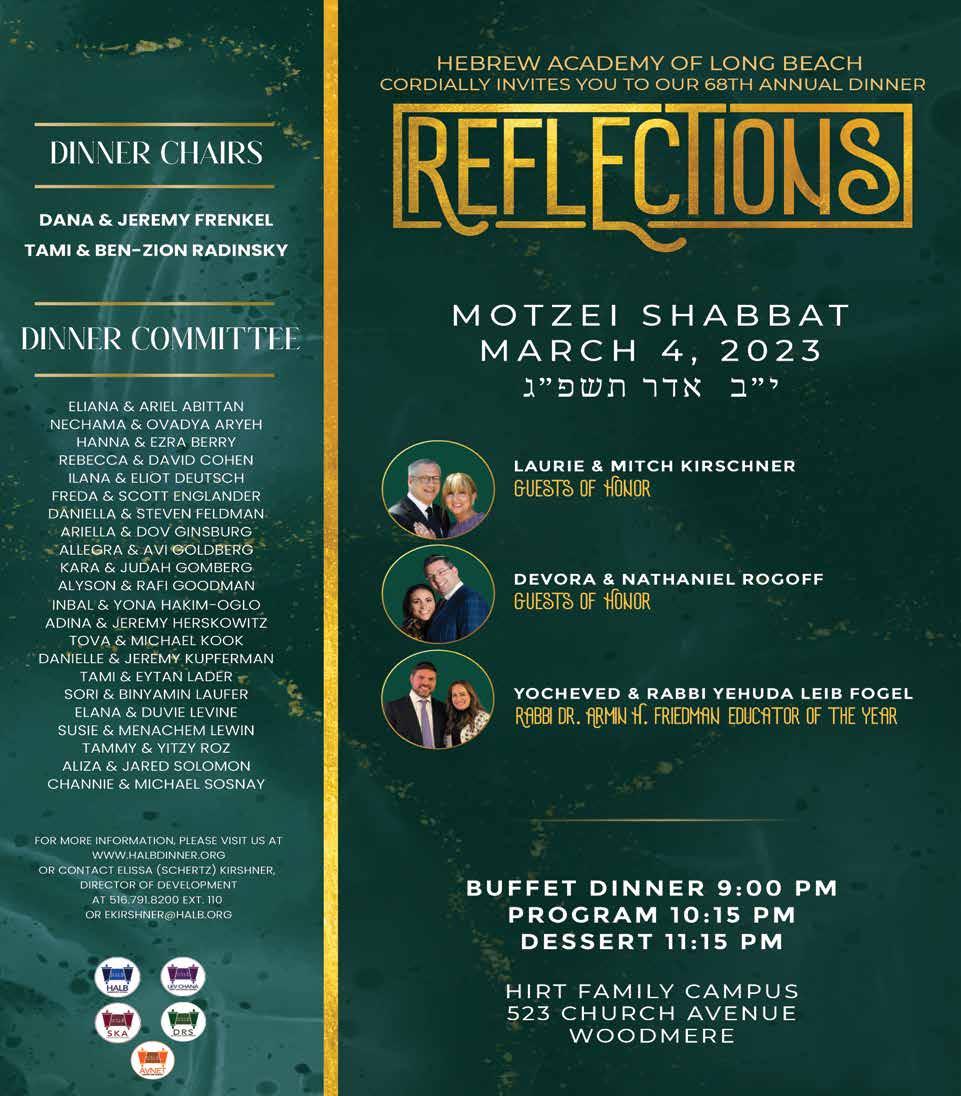


the presidency, barnstormed through three Democratic metropolises on Monday, appealing to embattled police officers and crime-concerned citizens with an address pledging more support for law enforcement and vowing to battle liberal-minded criminal justice reforms.
The Presidents Day stops in New York and the suburbs of Philadelphia and Chicago were meant to tweak Democratic politicians who run those cities, with denunciations of “woke” prosecutors and anti-police talk. Part Florida boosterism, part campaign stump speech, the three stops were also supposed to establish the Florida governor’s appeal with the kind of Republican-leaning suburban voters who fled former President Donald Trump and must be pulled back for the GOP to recapture the White House next year.

“We’re grateful to be here to deliver a very important message, a message about safe communities, the rule of law and about standing by the people that wear the uniform and put themselves at risk to protect us,” he told an audience of law enforcement officers at an Elmhurst, Illinois, Knights of Columbus hall, well outside Chicago, a city that has been demonized as lawless and ungovernable since Trump’s 2016 campaign.
He also appeared in Fort Washing-
ton, a Philadelphia suburb, and on Staten Island, the one borough that voted for Trump in 2016 and 2020.
DeSantis, 44, has captured the attention of Republican voters by presenting himself as a younger, more policy-focused heir to Trump.
DeSantis’ message resonated with New Yorkers who are frustrated about a rise in major crimes, said Joseph Borelli, the City Council’s Republican minority leader, who attended the event, at the restaurant Privé.
“His message was simple: that Florida has hit a 50-year low in crime because they haven’t enacted policies like bail reform and defund the police,” he said. “Every time you open a newspaper, they’re talking about crime in New York and other big progressive cities.”
Many New Yorkers moved to Florida during the pandemic. In 2020, New York City had a net loss of nearly 21,000 residents to Florida, according to IRS data, almost double the average annual net loss from before the pandemic. Illinois experienced a similar migration. (© The New York Times)
ers allow more flexibility as New York recovers from the pandemic. Adams has criticized remote work, saying: “You can’t stay home in your pajamas all day.”
But the mayor relented on Friday, agreeing to create a “flexible work committee” to find a way to offer some employees a remote option in a pilot program that would start by June 1.
Mayor Eric Adams announced a tentative contract agreement with New York City’s largest municipal union on Friday that includes a plan to allow some city employees to work remotely starting in June.
If approved by the union, District Council 37, the five-year deal would increase wages 3% a year in the first four years and 3.25% in the fifth. Workers would also receive a $3,000 ratification bonus and a minimum wage of $18 per hour.

Remote work was a major issue during negotiations, and Adams had insisted that city employees work in person five days a week, even as private employ-
Adams, a Democrat who is known for working long hours, acknowledged that the concept of work had changed and not everyone needed to be in person full time. He characterized himself as “a seven-day-a-week in the office person,” but allowed that was no longer “the reality of the universe we’re living in right now.”
The tentative contract, which requires ratification by District Council 37’s members, affects about 90,000 employees or roughly a quarter of the city’s unionized workforce. It is the mayor’s first major labor contract agreement and is likely to be used as a basis for negotiations with unions representing police officers and teachers.
The union’s executive director, Henry Garrido, said the new “flexible work committee” would examine ideas such as staggered shifts and a four-day workweek. Some workers’ jobs, he said, could

be done outside offices, such as processing of food stamp benefits online.
Adams’ strict requirement that municipal employees work in person has contributed to a staffing crisis in city government. Many city agencies, including the Department of Buildings and the Department of Social Services, have vacancy rates of 20% or higher, slowing critical work that New Yorkers rely on.
(©
The New York Times)by maintenance workers around 8 a.m. on Sunday morning, swimming in Prospect Park Lake.
The Parks Enforcement Patrol and the Urban Park Rangers were able to quickly rescue the animal, which they said was in “poor condition” when they found it.
After being transported to the Animal Care Center of NYC for treatment, the workers nicknamed the animal “Godzilla.” It will now reside in the Bronx Zoo for rehabilitation.
Godzilla is only four feet long, but American alligators can grow to be over 12 feet long. The cold-blooded reptiles generally reside in warm waters. Officials believe that Godzilla was an abandoned pet.
“In addition to the potential danger to park goers this could have caused, releasing non-indigenous animals or unwanted pets can lead to the elimination of native species and unhealthy water quality,” a Parks Department spokesperson said.

alligator found in the New York City metro area this year. In January, a man in Neptune, New Jersey, discovered an alligator inside a large plastic bin outside his home. The New Jersey alligator was rescued on a cold January night and brought to a new home at the Cape May Zoo.
A large, four-foot-long alligator was pulled out of a lake in a New York City park on Sunday.

The gator was discovered in Brooklyn’s Prospect Park, the city’s second-largest public park. It was spotted
“In this case, the animal was found very lethargic and possibly cold shocked since it is native to warm, tropical climates.”
Releasing animals inside a New York City park is illegal, and park rangers respond to about 500 reports of abandoned animals each year.
Godzilla is not the first abandoned
The price of phones are crazy, but not as crazy as a phone that sold this week.
A first-generation 2007 iPhone sold for more than $63,000 in an online auction on Sunday, more than 100 times its original cost. Dubbed a “first-edition” device by auctioneer LCG Auctions, the box had never been opened.
If you would have bought the phone years ago, it would have gauged a $599 hole in your pocket. Early adopters would have enjoyed a 3.5-inch screen with a 2-megapixel camera, plus 4 GB and 8 GB storage options, internet capabilities and iTunes. Still, the phone had no app store, ran on a 2G network, and was exclusive to AT&T’s network.
There were 27 bids on the talk-piece. In the end, the winner was “an individual from the U.S.”
The original owner of the vintage iPhone was Karen Green, who never opened up the gift.
Speaking at Apple’s annual Macworld expo in 2007, then-Apple boss Steve Jobs opened his presentation with: “We’re going to make some history together today.” Jobs called the new smartphone a “revolutionary mobile phone” that will feature an iPod, phone and what he called an “Internet communicator.”

“It’s bad out there today,” said Jobs of mobile Web browsers. “It’s a real revolution to bring real Web browsing to a phone.”
If only he could see the future.
A pair of British brothers-in-law each pulled a 1.65-ton van a distance of 32 miles to become co-holders of a Guinness World Records title.
James Baker, 36, and John Darwen, 32, completed their feats side-by-side at Elvington Airfield and both stopped at exactly 32 miles to become co-holders of the Guinness World Record for farthest distance pulling a vehicle in 24 hours as an individual.

Darwen’s bout with leukemia 14 years ago inspired the duo to start completing challenges each year to raise money for charity. They started out running half-marathons and marathons before deciding to take on the more demanding challenge of the van pulling world record.
And it was indeed a challenge. Baker was ahead of Darwen for most of the journey. At mile 30, Darwen’s feet were severely blistered and both his big toenails had been badly bruised, making the final miles much harder.
Darwen recalled, “James could have kept the lead and claimed the title for himself, but instead he pulled his van alongside me, and we went the final two miles together.
“I was ready for giving up at the end of mile 31 but persevered to make it 32.”
At the end of the road, they both nabbed the title together.
“James finished ahead of me,” Darwen said, “but put his harness down and walked with me to cross the final lap line together.”
Baker added, “I could’ve gone ahead and perhaps completed another four to five miles, but if I did would it have been worth it?
“What’s better, to finish first, or to finish with my brother-in-law, my best friend, and hold the record together? I was willing to sacrifice further miles to allow John to share the certificate.”
The two had previously broken the same record in 2021, when they pulled a 1.5-ton vehicle 22.1 miles in 24 hours.
Sounds like they can really pull themselves together.

standing.
Recently, a letter was delivered to its final destination on Hamlet Road in south London – more than 100 years after it was sent.
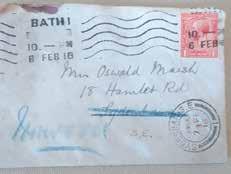
Mennel, while her family was on holiday in Bath, in western England. In the letter, Mennel writes: “I’ve been most miserable here with a very heavy cold.”
It remains a mystery as to how the letter arrived at Glen’s flat a century later.
According to the postal service, “We appreciate that people will be intrigued by the history of this letter from 1916 but have no further information on what might have happened.”
It consists of six layers of concrete and steel and is slightly detached from the surrounding buildings. An array of shock-absorbing springs was installed below it. Inside, fiberglass wedges are installed on the floor, ceiling, and walls to break up the sound waves before they have a chance to travel into the room.
Passengers on a flight from New Zealand to New York spent 16 hours in the air – and ended up going nowhere.
The Air New Zealand nonstop flight from Auckland to New York had been in the air for about 8 hours last Thursday and was about 2,000 miles from California when the airline received word that an electrical fire at New York's John F. Kennedy International Airport had led to Terminal 1 being closed.

A decision was made to turn the plane around and return to Auckland, where it landed 16 hours after departing. Talk about a nonstop flight.
“Diverting to another U.S. port would have meant the aircraft would remain on the ground for several days, impacting a number of other scheduled services and customers,” an airline spokeswoman told the New Zealand Herald.
The airline apologized to passengers and said those aboard the flight would be booked on the next available flights to New York.
What could be worse than air travel? Traveling in the air – without really traveling.
The postal service has a bad reputation, and sometimes, it really earns that
“We noticed that the year on it was ’16. So we thought it was 2016,” Finlay Glen told CNN. “Then we noticed that the stamp was a King rather than a Queen, so we felt that it couldn’t have been 2016.”
Although the letter arrived at the property a few years ago, Glen only recently took it to the local historical society, so they can research it further.
The envelope has a 1 pence stamp bearing the head of King George V. The letter was sent in the middle of World War I – more than a decade before Queen Elizabeth II was born.
“Once we realized it was very old, we felt that it was okay to open up the letter,” said Glen, 27.
“As a local historian, I was amazed and delighted to have the details of the letter passed to me,” said Stephen Oxford, editor of the Norwood Review.
The correspondence is a picture of what life was like a century ago.
The letter was addressed to “my dear Katie,” who, according to Oxford, was the wife of local stamp magnate Oswald Marsh.
It was written by Christabel Mennel, the daughter of tea merchant Henry Tuke
The check is in the mail.
Microsoft better watch out, though. Another anechoic room is hoping to become the world’s quietest room. It’s located at Orfield Laboratories in Minneapolis and was designed by scientist Steven J. Orfield, who had held the title before Microsoft nabbed it years ago.

Turns out that silence is not always golden.

Want to know what you hear when you don’t hear anything at all?

Well, you can hear your heartbeat –and even your bones creaking.
In 2015, Microsoft built a room that is now officially designated in the Guinness Book of Records as the quietest place on Earth. Dubbed the anechoic chamber, it is located at the company’s headquarters in Redmond, Washington.
But silence isn’t always a good thing. Only very few people manage to survive in this room for a long period of time – at most an hour. When things are so quiet, you begin to hear the almost imperceptible sounds of your body: your heart beating, your bones creaking, your blood flowing.
Without any sounds from the outside world to get in the way, absolute silence will gradually turn into an unbearable ringing in the ears. This will likely cause you to lose your balance due to the lack of reverberation in the room, which will impair your spatial awareness.
“When you turn your head, you can even hear that movement. You can hear yourself breathing and it sounds pretty loud,” Hondaraj Gopal, the project’s lead designer at Microsoft, said.
Creating a room completely void of sound took almost two years to design.
Did you know?
A bug that resembles the mass-murdering leader of Germany decades ago is really named Catacanthus Incarnatus but that’s not what it’s being called. The insect native to India was dubbed the “Hitler” bug back in November since it looks a bit like the dictator.
Aside from the uncanny resemblance, the insect also appropriately gives off a deeply unpleasant smell as a defense mechanism against predators.
According to the Indian Express, the bugs are notorious pests, gathering en masse to attack fruits, cotton, corn, soybean and cashew tree crops.
Researchers Sangamesh Kadagad and Manjunath Nayak told the Express, “We have been naming the bugs to help junior researchers easily identify them. We first tell them scientific names and then select names of legends. Now, students are easily remembering the names of the specimen. We have also named some bugs after famous politicians and cricketers based on their looks and morphology but are yet to finalize them.”
Sounds like a bug you’d like to squash.
It costs 2.1 cents to make a penny.



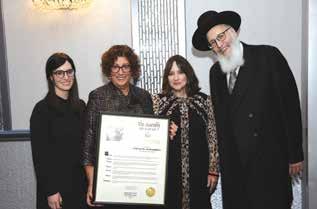


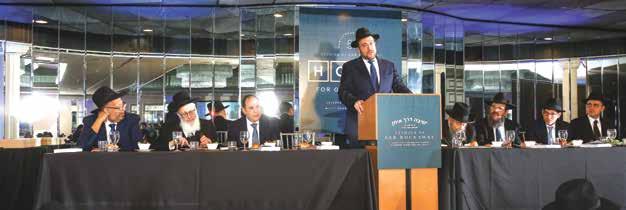








The journey of the third grade talmidim of Yeshiva Darchei Torah into the world of Torah Sheb’al Peh commenced on Sunday with a grand celebration, attended by parents, grandparents and even great-grandparents of the talmidim.
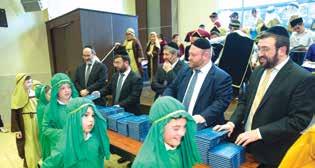
The boys, resplendent in colorful costumes that represented cases and themes of the first Mishnah in Berachos, sang beautiful songs about Rashi’s pirush on Chumash and about the Mishnayos.
An emotional highlight of the morning occurred when the Rosh HaYeshiva, Rav Yaakov Bender, interrupted his remarks to call up two great-grandmothers of talmidim in attendance, Mrs. Regina Goodman and Mrs. Judith Wohlberg, who survived
the Holocaust against all odds and expressed their elation at being zocheh to see their descendants learning Torah.

The grand finale of this winter’s weekly Dor L’dor Motzaei Shabbos learning program at Yeshiva Darchei Torah was marked with a learning seder, of course, followed by a performance by master magician Syltig.
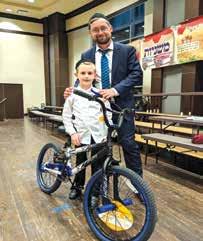





The Village of Cedarhurst proudly maintains a strong working relationship with the 4th Precinct


The word “choice” loses all meaning when one is coerced into making it.
When a woman turns to EFRAT, it’s because poverty and other circumstances have cornered her into believing that she is incapable of supporting her unborn baby. She feels trapped. EFRAT helps women to make the choice they want to make, instead of the choice they feel forced to make.
Often, it is the people closest to these women, the spouse or parent, who exert the most pressure, insisting that there is no choice but to end the pregnancy. Trag-

ically, tens of thousands of babies are lost every year due to economic distress.
“These women are in a stressful, complex situation. They feel desperate and alone,” says Ruthy Tidhar, head social worker at EFRAT.
The first thing that EFRAT’s trained volunteers do is to ensure the woman that she is not alone, she has support. The volunteer will seek to understand the woman’s distinct needs and will go on to become a steady source of comfort, strength and hope.
“We don’t only provide assistance through the immediate crisis,” adds
Ruthy. “We offer ongoing postpartum support and resources for a sustainable path forward.”
After she has her baby, each mother receives baby equipment as needed, including a crib, mattress, baby bath, and stroller—all brand new and of high quality. She also receives a kit of essential supplies including linen and blanket sets, clothing, diapers, wipes, pacifiers, pacifier clips, bottles, bibs, and more.
Additionally, for the first two years of the baby’s life, the mother receives a monthly package of basic baby products, and where required, she can also receive a monthly delivery of staple food products.
Based on the woman’s circumstances and needs, EFRAT’s volunteer coordinator and head social worker may also involve additional professionals — doctors, lawyers, psychologists, doulas, life coaches and social workers — who offer their services pro bono. Women may also receive advice, guidance and advocacy to procure the government benefits they are eligible for.
EFRAT’s newest department, Working Moms, empowers women even further, helping them to achieve financial independence through vocational testing and support, free educational opportu-
commanding officers and showed them appreciation with a luncheon on February 16.
nities, and childcare vouchers. EFRAT helps these women emerge from the cycle of poverty and reclaim a future of physical, emotional and financial security.
EFRAT staff and volunteers work tirelessly to increase public awareness of services so that women everywhere who feel forced into having an abortion will know how to access support.
Each year, over 3,000 women are empowered by EFRAT’s generous donors and volunteers to have the children they deeply desire.
At a recent event in Boca Raton, Florida, popular columnist and media personality Ben Shapiro pointed out that a person donating to EFRAT knows with absolute certainty that every dollar is helping to save a life. “Literally, that child would not be here if not for EFRAT’s assistance. I can hardly think of a better cause to give to,” Shapiro said.
With 150+ trained volunteers, EFRAT’s overhead costs remain low, so that more funds go directly to helping the women who need it. For $125 per month for one year, you can help a woman bring her precious child into the world.
For more information and to partner with EFRAT, please visit our website at www.cribefrat.org , call us at 718-6977022, or write us at info@cribefrat.org





This past week, the talmdim of Yeshiva Ateres Eitz Chaim learned and became certified in CPR and First Aid



Mrs. Rivki Morel was born with cystic fibrosis and has lived a life of struggle, hardship, transformation, and optimism all rolled into one. As a life’s mission, she has undertaken to take her message of emunah to the wider Jewish community and graciously came to Shevach High School on Monday, February 13, to speak to its students and staff as part of that mission.
Mrs. Shulamith Insel, Menaheles, opened the program with a beautiful message. She shared that in Mishlei, Shlomo Hamelech says, “Tov lev mishteh
tamid, a good-hearted person constantly feasts.” This refers to a person who has mastered emunah and bitachon, for to him no matter the circumstances, life become one long celebration, filled with happiness. He will always feel secure, recognizing that Hashem knows what is truly best for him. Mrs. Insel introduced the guest speaker as someone who personifies this ideal.
Mrs. Morel charted her experiences in terms of emotions. She described pain, disappointment, sadness, anger, fear and difficulty. But above all, she is gifted with

the ability to see beyond all that and to set a goal of living a life of positivity and joy. She lost a sister to cystic fibrosis, and she lost her husband of only several years to another fatal disease. Yet through it all, she has stood strong. She conveyed how just as Hashem gave her this challenge, Hashem has carried her through it, and continues to guide her through life.
Mrs. Morel explained that just as the heart has different chambers but beats as one, so, too, a person experiences different things in life but functions and moves forward with purpose and conviction.
“We all have the power to choose our responses,” she said. “And I have chosen the route of looking for the good and going with that from stage to stage.”
With a lung transplant, intensive physical rehab, and consistent monitoring, she lives today with an attitude that is enviable. She left the girls inspired to take a serious view of their futures and to be involved in shaping that future with the proper perspectives. Shevach students were fortunate to be offered that clarity as they move forward in their lives.
Rabbi Gardenswartz and Rabbi Heimlich’s third grade classes at YOSS have been learning Parshas Vayeishev in depth. As a culmination of their limud, the boys performed group skits depicting the narrative of Yosef Hatzaddik’s dreams and subsequent sale by the Shevatim. The talmidim put in a great deal of work preparing scripts, props, and costumes. They brought the Torah they have been learning to life! Yasher koach to all the boys (and parents who helped!). May the Torah they learn always be alive and exciting!

Last week, DRS held its Annual Nedivei Lev Service Society Induction Ceremony. This special ceremony recognizes DRS students that have shown exemplary service to their community and school through extraordinary acts of chessed and kindness. The ceremony honored members of the senior class who have served their school and the larger community with great distinction. The ceremony was attended by the entire student body, as well as faculty and parents. Rabbi Eli Brazil, Director of Student Activities, delivered some opening remarks and discussed the Nedivei Lev Service Society as well as the concept of chessed and giving to others.
The keynote speaker was Rabbi Yaakov Bender, Rosh Yeshiva of Yeshivas Darchei Torah. Aside from building a landmark institution of talmud Torah and chinuch, Rabbi Bender is best known for the incredible chessed he does with members of his yeshiva community.
What made the program truly unique was that the students were given awards by the directors and founders of many of
the organizations that were the beneficiaries of the great chessed done by DRS students. Raz Amar and Andy Mordowitz were lauded for their commitment to the children of the I-Shine program. Sammy Saperstein was recognized for his dedication in regularly visiting and caring for the elderly at the Premiere Rehab Facility. Jack Huberfeld was awarded for his consistent commitment to volunteering with Tomchei Shabbos. Daniel Lebowitz and Moti Schreck were commended for their hard work in publishing DRS’s weekly Torah publication, disseminating divrei Torah for Shabbos tables across the Five Towns, West Hempstead,
Queens and Brooklyn. Jack Radinsky and Ari Saffra were honored for their devotion to the members of Yachad. Yehuda Goller, Netanel Fruchter, Shmuel Benjamini, Shucky Shaffren, and Shlomo Cywiak were all celebrated for their work with Ohel Special Projects. The Friendship Circle of Chabad presented an award for Simcha Schachter for his years of service to the organization. Finally, Josiah Gampel was recognized for his volunteer work with Shalom Task Force. A big yasher koach to all the honorees on their chessed and to Student Activities Director Rabbi Brazil who coordinates all chessed opportunities in DRS.

This past Tu B’Shvat marked an incredible occasion to benefit the singles of Klal Yisroel, as 400 lomdim gathered for the 6th annual Shas for Shidduchim Siyum haShas. It was a truly extraordinary event of limud HaTorah, as the lomdim gathered to learn the entire Shas within a 24-hour period as a z’chus for singles to find their bashert
This monumental event also saw the return of last year’s extremely popular Shas for Shidduchim Jr. program. The lomdim of Shas were joined by over 100 children who simultaneously learned and were misayem Shisha Sidrei Mishna

The event culminated with a grand
siyum, held at Chicago’s magnificent Ateres Ayala Simcha Hall. The event was headlined by inspiring words of Torah from renowned speaker and rav, Rabbi David Ozeiry. It was a vibrant and exciting night of music and dancing led by the always-fantastic Joey Newcomb.
As Rabbi Ozeiry surveyed the massive crowd of dedicated lomdim and their families, he reflected on a quote from Tanach when Hashem told Dovid Hamelech that his “one day of limud haTorah is greater than 1,000 karbanot.”
The contributions made to Shas for Shidduchim support Chicago Chesed Fund’s year-round shidduch and new-

lywed-related services. Chicago Chesed Fund provides consistent proactive outreach to their extensive shadchanim network on behalf of singles, shidduch events and coaching for singles, as well as sheitels and wedding gowns for kallahs and their families.
These generous acts of tzedakah combined with the passionate learning of the lomdim made this a truly memorable event. The dedication these lomdim displayed was absolutely awe-inspiring, with one lomed even learning 120 blatt within the 24-hour period!
Chicago Chesed Fund thanks their dedicated lomdim and generous donors

for making the 6th annual Shas for Shidduchim initiative the most successful event to date (pun intended)!
Chicago Chesed Fund, founded by Dayan Shmuel Fuerst, is committed to helping families in crisis throughout the Chicagoland area. Its 80+ various programs provide critical assistance in the form of goods, services, and financial support in an environment that maintains the dignity and integrity of each and every recipient.

This week, there was a surprise lunch for YOSS 6th & 7th grade Tech-in-Check members. Rabbi Yitzy Haber (TiC Commissioner) made sure that after they enjoyed their General Tso and Chicken Lo-Mein – not one piece of broccoli went to waste. (In fact, the extra spears were raffled off and eagerly devoured!)

You see, at YOSS, the Tech-in-Check members really appreciate when Rabbi Haber comes, because he brings great food, prizes, and some really funny (and slightly ridiculous) entertainment! But most of all, the boys recognize that being part of Tech-in-Check gives them the power and control to navigate and manage the greatest challenge that they face: the endless pull of technology.
Tech-in-Check, a grassroots movement that began at YOSS last year, allows boys to create boundaries and take control of their technology use. They commit to three things: to not having
a smartphone or personal internet device, to not have “screen-time” on school nights, and to ensure that all devices that they can access are properly filtered and restricted. Together with their parents, they chart weekly and monthly progress and enjoy special “Family Rewards” and perks from the yeshiva.


Recently, a group of seventh graders joined Tech-in-Check, and after a couple weeks they report how glad they are that they took this amazing step. They are exploring new hobbies, enjoying time with their families, playing more sports, and even getting better grades! In fact, just last week, a seventh grader told the Menahel, Rabbi Zev Davidowitz, “I thought it would be so much harder to get off my iPad, but I now see that that real life is much more fun than swiping a screen!”


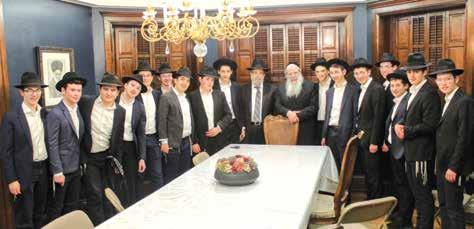
Apparently, taking control of technology helps with healthy food habits too... Just ask the boys who won the broccoli raffles!


Every living thing has DNA, even fruits and vegetables! Scientists all over the world study and apply DNA techniques in order to learn more about species of plants, genetic engineering, and mutations. Forensics club students at Abraham and Sara Silber Mechina division of YOSS, learned how to use a process to precipitate DNA from fruits. We used bananas, but we will be using other items in the coming weeks. Such an intriguing and amazing activity!
Riddle: How do you earn more money while investing your money and trimming your expenses?
Answer: Find out at Kosher Money’s first-ever event taking place in the heart of the Five Towns on Tuesday evening, February 28 at the Young Israel of Lawrence-Cedarhurst.

Rabbi Naftali Horowitz, wealth advisor to multi-millionaires, will be sharing his insights in a 30-minute keynote session followed by Q&A with the audience. His episodes on the Kosher Money Podcast have attracted well over a million views and for good reason: he’s down-toearth, brilliant, and well-spoken.
There’ll also be a panel, moderated by podcast host Eli Langer, that’ll feature an expert on budgeting (Simi Mandelbaum), an expert on negotiations (Mitchell Eisenberger), and an expert on investing (Isaac Goldsmith).
What do they see as low-hanging fruit for attendees looking to better their fi-
nancial situations? What common mistakes do most people make as it relates to their finances? How can I get that raise I deserve? How should I best educate my kids about money? So many questions to cover!
This event promises to provide you with a wealth of knowledge and tools to help you maximize your finances in 2023 and beyond. Not to mention the delicious food.
The Kosher Money Podcast, produced by Living L’chaim, has already had a significant impact on millions of people worldwide. Its 43 episodes cover various money-related topics, including budgeting, investing, and more, with a combined 6 million views across all streaming platforms.

Get your tickets at KosherMoney.org –early bird pricing is $20/individual and $30/couple. Thank us later.
It’s February. The semester has just started, the temperatures are (slowly, but surely) rising, and the days of snow and ice will soon come to an end. There’s no better time to go snow tubing.
On Tuesday, February 14, the entire Central student body took a break from regular classes to snow tube at Campgaw Mountain in Mahwah, New Jersey. After a scenic drive from school, Central students had their choice of a variety of slopes and trails and took full advantage of the provided tubes and the complimentary lift back up the incline to do it all over again. Ironically, students and faculty enjoyed a fifty-degree day for the snow tubing excursion – perfect for one last winter sporting outing.
For students, it was a chance to have some fun before the semester goes into full swing. But the trip had a higher

“Wear it pink” was the theme of the day at the Stella K. Abraham High School for Girls on Pink Day, Tuesday, February 14! Every variation of the color dominated students’ clothing together with the hallways of the school.
Sharsheret Pink Day is a worldwide initiative by students to raise awareness about breast cancer and cancer genetics. Vibrant pink sweatshirts, raffles, gift certificates to local stores and delicious cupcakes were sold throughout the school day with all proceeds going to Sharsheret.

The girls were honored to hear from a breast cancer survivor who shared her story in an open and honest account of how she dealt with her diagnosis and treatment. Everyone appreciated hearing her words as she entreated the girls to have yearly checkups. Her inspirational
purpose – it was an opportunity for different grade levels to mingle and forge new friendships, as junior Debra Burger pointed out. “It was so nice talking to girls from other grades,” she said. Even Central’s faculty got in on the fun, giving the students a run for their money. The Math Department’s own Mr. Yitzchok Borenstein said, “I went down the slope six times and had a blast! I even beat some of the students.”
The snow tubing outing kickstarts an exciting spring semester at Central that will include full-grade Shabbatons for all four classes, chesed trips, a senior trip to Washington, D.C., a junior trip to Split Rock Resort, a senior retreat to Camp Kaylie, and an entire roster of surprises and fun for the Senior Seminar, which will last the entire semester.
talk made Pink Day at SKA very meaningful.
SKA’s Pink Day highlighted the need for awareness and education, as Ashkenazic Jews are ten times more at risk for hereditary cancers than the general population. Yashar koach to SKA faculty member Mrs. Rachel Joszef and her hardworking Pink Day committee members – Chavi Farrel, Dahlia Jacobs, Ella Papilsky and Naomi Sigman – for organizing such an important event.


The family fun has been ongoing all winter long at the Young Israel of Jamaica Estates. This past motzei Shabbat, they wrapped up their winter season of parent-child learning. Parents and grandparents come with their children and study in the newly refurbished Beit Midrash. Source material for the parsha is provided for those looking for deeper meaning, while others bring this week’s assignments. YIJE Morah D’asra Rabbi Dov Lerner is on hand for anyone needing assistance or insight. The evening highlight is the pizza and raffles afterwards, where everyone is a winner!

Who can forget YIJE’s wonderful Monthly Mitzvah Morning?! Thanks to all who joined us Sunday for family mitzvah morning! Forty bracelets and gift packs were handmade and will be donated to Northwell Health Center of Hope. The Center for HOPE (Healing, Opportunity, Perseverance, Enlightenment) provides a place where children and families receive support and help through developmentally age-appropri-


Last week, HALB Middle School celebrated Pink Day to raise breast cancer awareness and support for Sharsheret. Students sold pink and white cookies with proceeds going to Sharsheret, and they learned about breast cancer prevention and what Sharsheret does. HALB eighth grader Noa Berman spoke to her fellow students about her mother’s experience as a breast cancer survivor and the important role Sharsheret played in their lives.
ate groups and short-term counseling free
Shhhh! Can you hear it? Purim is coming! Sound plays a very important role in a child’s Purim celebrations. Children need to be very quiet when the Megillah is read and very noisy when they hear Haman’s name! There is singing, dancing and lots of laughter. As they prepared for Purim, our Banot at Shulamith ECC had a wonderful time studying sound and learning so much in every important curriculum area.
Creating raashanim was an exciting culmination to the study of sound and an excellent way to learn about cause and effect. Our young scientists were intentionally provided with an assortment of clear containers and a variety of fillers. Some of the questions asked were: What would happen if you filled the container to the top? Which sound is louder: one bolt or a container filled to the top with bolts? Why? What would happen if you filled the container with pom poms? What made such a loud sound? Finding the answers to these questions was accomplished by setting up simple hands-on experiments to identify the most probable cause. These experiments enabled the children to try out suggested causes, compare results and then draw conclusions about the most likely reason for
something to happen, thereby introducing them to the scientific method.
Developing an understanding of the concept of cause and effect is not only important for STEM activities and literacy, but is also important for social relationships. A child who knocks down another child’s structure is expected to help that child rebuild, and a child who hurts another child’s feelings needs to find a way to make that child feel better. Young children can often handle cause related questions that are phrased as “What would happen if?” or “What do you think made something happen?” These questions are “sound” to use when talking to young children because they do not require children to apply or explain scientific principles that lie beyond their understanding. Instead, questions like these depend on what the children can see happening with their own eyes or what children can deduce from their own experiences.
Shulamith ECC wishes everyone a Chag Purim sameach filled with the sound of joy!




Production season has arrived in Machon Sarah High School. After four long years of waiting, our girls are finally back on stage. Months of practice will culminate in three performances this Motzei Shabbos and Sunday, February 25 and 26, in Lawrence High School. The excitement and ruach is palpable as we get closer and closer to the show. Students in grades nine through twelve come together b’achdus to participate in the biennial play. Through drama, song, and dance, our story comes to life. We follow two roommates in seminary as they go on separate journeys while simultaneously discovering their past together. The talented cast and crew have been working tirelessly to provide you a night schools.org
 By Avraham Gifter
By Avraham Gifter
Wow. We were absolutely blown away when we received over 60 participants. In addition, more than 25 of them learned an outstanding two hours. Since this was our first year, we were not expecting this big of a success. We hope all of the learning done brings all of Klal Yisroel much bracha.
Thank you to our sponsors: 718 Insurance, Double A Shots, The Jewish Home, MBA Supply Company, Future Care Consultants, Monogram Me, and to our corporate sponsor, Emerald Healthcare. We could not have done it without their help.
Now, it’s time to announce the winners. The personalized Gatorade GX bottle goes to Moshe Genuth. The Rubik’s
impossible and phantom cube bundle was won by Zevi Digdon. Our last prize from the first tier, a $25 Amazon gift card, goes to Tzvi Ishakis. Moving on to the second tier, Elisha Price won a portable grill. Next up, Elchy Zhon won a camera drone. Shalom Fruchandler won the last tier two prize, a $50 Amazon gift card. The first winner of tier three, Mordechai Werzberger, won a JBL Flip 5. The Fitbit Charge 5 goes to Meir Grossman. Last but definitely not least, Yitzy Fisher won a $100 Amazon gift card. Mazal tov to all of our winners, and see everyone next year.
To watch a recording of the drawing, please email thetorahkup@gmail.com for more information.
Week 6 of the JSL season by FM Home Loans is in the books with some amazing games and great individual performances!
The boys’ skills are greatly improving under the guidance of our amazing JSL coaches!
K/P Hockey: Akiva Schreier of ARG scored a hat trick, including a half-court goal, while Yair Kupfer made incredible saves for ARG, keeping them ahead in a 4-2 victory over Simcha Day Camp. Gourmet Glatt dominated with Shimmy Greenspan scoring four goals, leading them to an 8-4 win against Home and Stone. Hewlett Auto Body had their best team game of the season, with goals from different players, including a full-court goal by Ari Davidowitz, leading them to a 5-2 victory against Alpert Financial.
K/P Soccer: David Ghoori led ARG to a convincing 10-3 victory against Future Care Consultants, scoring a hat trick and earning the game MVP award.
1st Hockey: Charlie Rosenblatt’s double hat trick, along with Eliyahu Frisch’s two goals, led Island Roofing to a 12-5 victory against ARG, with Dovid Kriegsman’s defensive skills slowing down ARG’s offense. A full team effort led 4 Seasons AC to a 6-3 win over Built by Nate, with Yaakov Packer having a great game on offense with 2 assists and a goal and Jack Korbaz and Abie Koerner doing a great job limiting Built by Nate’s offense.
3rd/4th: Max Edery of Island Roofing performed an amazing display of offense, including an incredible “and-1,” leading his team to a 13-12 win against Built By Nate. Eli Oratz’s dominant 14 rebounds sealed a win for Town Appliance, with the final score 18-11 against Posh Home + Bath. Maidenbaum beat ARG 8-4, thanks to Ezra Rosman’s “and-1” and three-point play finish.
5th-7th Basketball: Yakov Kopelowitz’s amazing pivot step under the basket helped Extreme Vent Cleaning beat Molly’s Jewelers 24-13, while Zach Obadiah’s “and-1” helped Maidenbaum beat Wieder Orthodontics 34-14. Five Towns Orthodontics won 34-21 against Marciano Pediatric Dentistry.
HOCKEY
2nd/3rd: JNT dominated with a defensive hat trick from Yitzy Statfeld and
Shlomo Greenspan’s shutout in goal, leading them to a 6-0 victory. Elegant Lawns scored in the 3rd period to take the lead and added an insurance goal, sealing their 3-1 win against 5 Towns Central. Meat + Board jumped out to an early lead and never looked back - ultimately winning 4-1.
4th/5th Hockey: In the first game, Town Appliance started slow but quickly took control, scoring four goals in the second period and finishing with a bang to secure an 8-1 victory over Autoclick. Posh Home + Bath had to battle it out with Marciano Pediatric Dentistry in a seesaw game, but they rallied in the 3rd period with an offensive explosion to emerge victorious with a 7-3 scoreline.
In the 5 Towns Orthodontics and 925 Sterling game, both teams were neck and neck for most of the game until Sholom Diamond and Gavriel Abittan stepped up with two quick goals in the 3rd period to clinch the 4-2 win for 5 Towns Orthodon-
tics. The intensity was off the charts! 6th/8th Hockey: JNT and Wieder Orthodontics had the crowd on their feet with a thrilling back-and-forth affair. Chezkel Solomon was the star of the game, scoring all six of JNT’s goals to secure a nail-biting 6-5 victory. In a defensive battle MoldPro put up a good fight but was not able to generate enough offense to stay with Bayrock Insurance. Moldpro answered Bayrock’s first two goals but were not able to stay with them the rest of the game, eventually losing 5 to 2.
GAME MVPS: Akiva Schreiver, Shimmy Greenspan, Matis Teitelbaum, David Ghoori, Max Edery, Eli Oratz, Ezra Rosman, Eli Benedek, Yaakov Kopelowitz, Ari Pearlman, Mendel Putter, Zach Obadiah, Aryeh Singer, Binyamin Stadtmaur, Meir Greenspan, Eliyahu Frisch, Aby Koerner, Meir Simcha Fireworker, and Cheskel Solomon

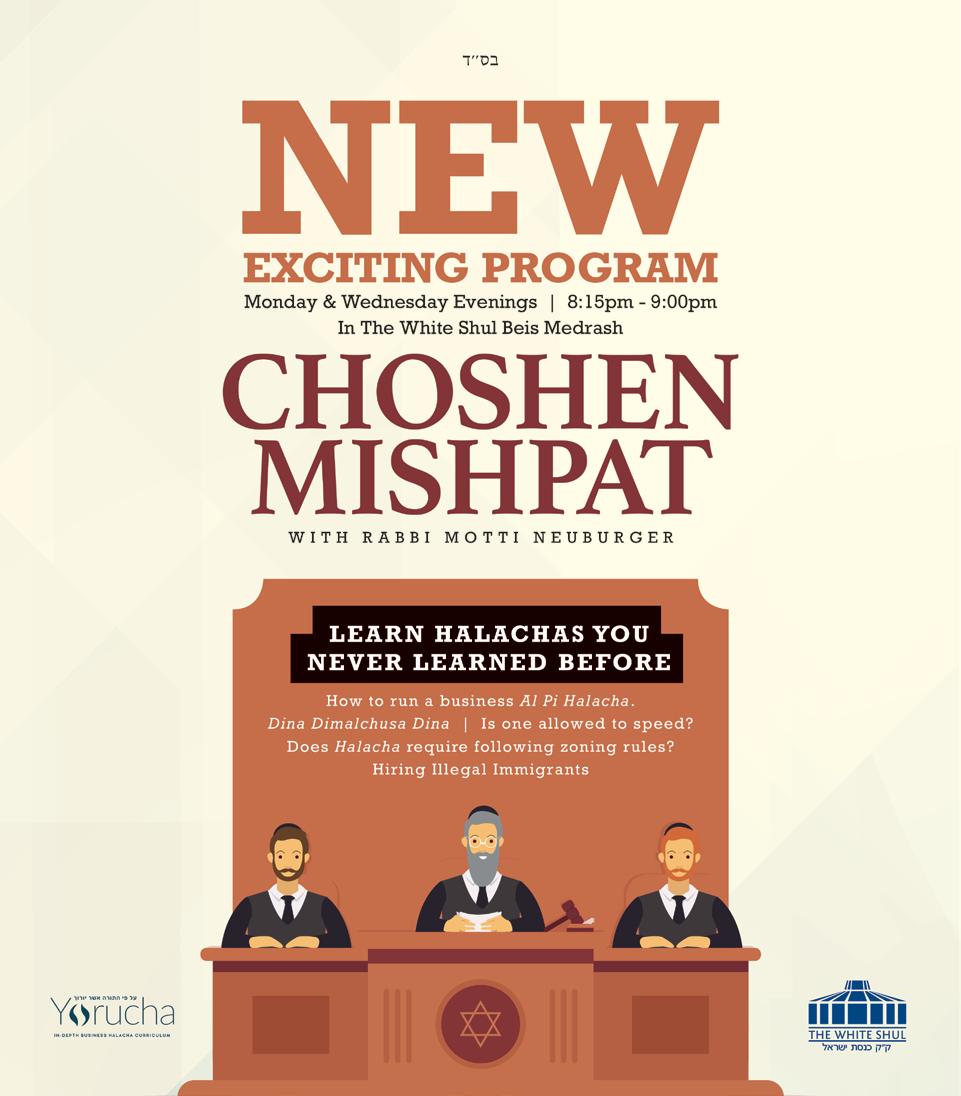
The talmidos of the Ganger Early Childhood Center at TAG, seen here wearing their special Rosh Chodesh necklaces, are so excited for Chodesh Adar and all of the fun programming that is in store for them all month!

Mercaz Academy students in grades one through six have been enjoying the opportunity to cash in on their successful learning strategies and good behavior at the Mercaz School Store, where they can trade “Mercaz Bucks” for toys they choose themselves.
Students earn Mercaz Bucks for a variety of positive behaviors, including kindness, academic achievement, showing effort, helpfulness, and participating in class. Any teacher who spots a student engaging in these behaviors can award him or her with a Mercaz Buck, which are legal tender in the School Store.

“Pedagogically speaking, we feel that a reward system like this is a very good strategy,” explained Assistant Principal Ms. Leeper. “Under a system of positive reinforcement, children understand that their good behavior results in satisfying consequences, such as recognition and rewards. This teaches them the value of personal responsibility and self-discipline.”
The School Store’s shelves are well stocked with brand new toys that have been donated by generous toy stores. In fact, just last week, the Mercaz Academy
HALB first grade teachers and learning center teachers visited Lev Chana’s kindergarten classes to learn more about what they do and how they do it. Teachers from both divisions met as a group to collaborate and discuss the best ways to set our students up for success.
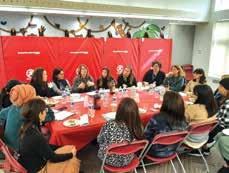
School Store was restocked with a large donation of new toys from Ian Epstein, owner of Thriftway Card and Gift in the Morton Village Shopping Center in Plainview, and we thank him for his generosity.
In addition to the joy of selecting their very own toys, Mercaz students get valuable lessons in math and economics when they shop. Some children spend their Mercaz Bucks right away for a larger number of small toys, while others save up to purchase bigger items. Best of all – in a reflection of the successful transmission of Torah values at Mercaz, as well as our students’ innate generosity – some students don’t “buy” toys for themselves at all. Instead, they use their Mercaz Bucks to buy presents for their younger siblings and friends.
Currently, there are countless Jewish children registered in public schools who are unaware that they have the opportunity to receive a Torah education. As a result, they may lose their Jewish identity forever if they continue in the public school system. It is imperative that we raise awareness and take action to rescue future generations.

Nechomas Yisroel, a non-profit organization, is taking a proactive stance to address this issue by offering financial assistance for yeshiva education. The organization’s mission is to ensure that every Jewish child has access to a genuine Torah education, regardless of financial limitations.
If you are aware of a child who fits this profile, please notify their parents about Nechomas Yisroel’s initiative. You can also contact Nechomas Yisroel directly with the information. By spreading the word, you can contribute to saving an entire generation.
The registration deadline for the new year is approaching, and the Rosh Yeshi-

va has urgently appealed to Klal Yisroel to help spread this crucial message. With your support, Nechomas Yisroel can continue to rescue Jewish children from public schools and place them in yeshivas where they can receive a quality Torah education.
Over the last 29 years, Nechomas Yisroel, led by Rabbi Asher Freidman, founder of Nechomas Yisroel, has successfully rescued nearly 30,000 children from public schools and provided them with a genuine Torah education by collaborating with 196 schools to place these children. Join the cause and help preserve the future of Jewish identity.
In this zechus of helping Hashem’s children, may you merit to see a great deal of nachas from your own children. For more information on Nechomas Yisroel, visit their website or contact them directly.
Call or text Nechomas Yisroel at 718.851.0340. www.kollect.live/nechomas-yisroel/

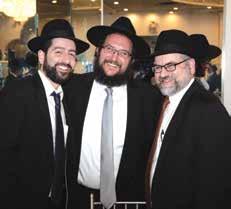


On Monday, February 13, the HANC BMP (Beit Midrash) students had the honor of meeting with Rav Yosef Tzvi Rimon. Rav Rimon serves as the rabbi of the Gush Etzion Regional Council and the rav of the synagogue of Alon Shvut Darom. He is also the Rosh Yeshiva of the Jerusalem College of Technology-Machon Lev and Har Etzion in Eretz Yisrael, and one of our generation’s leading poskim, specifically in upcoming technology and media. Rav Rimon had a packed schedule and still found time to give an enlightening, thought-provoking shiur for HANC students.
Rav Rimon spent about 45 minutes with the BMP HANC students and gave
over so much knowledge and shared crucial messages for life. In addition, three main halachic and psychological questions were posed, and Rav Rimon provided detailed and profound responses to each.



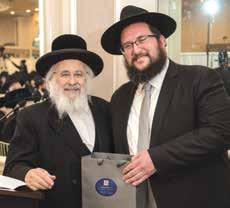
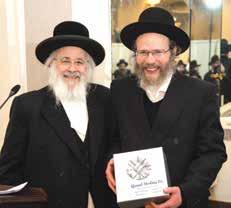


The energy Rav Rimon brought and the way he carried himself with such calmness and simcha made everyone feel comfortable in his presence and in awe of his knowledge and positive mindset. Rav Rimon concluded with a bracha to always live life with yirat Shamayim, be healthy, learn Torah, and that we should be zocheh for Moshiach to come.
It was a great kavod to host Rav Rimon, and the HANC faculty and students thank the Rav for joining us, answering our questions, and sharing his vast knowledge.



 By Naftali Weinberger
By Naftali Weinberger
Rav Chaim Kanievsky was the Sar HaTorah, master of every area of Torah knowledge and author of dozens of Torah works on topics ranging from the basic to the arcane. He was a fount of guidance, comfort, and blessing to tens of thousands. His diligence in Torah was legendary, yet he opened his home and his heart to all who sought him.
But despite all the stories we have heard, there is so much more. And Rabbi Naftali Weinberger is the perfect person to give us the rest of the story.
Rabbi Weinberger had a uniquely close relationship with Rav Chaim Kanievsky and his family for nearly thirty years — so much so that Rav Chaim authorized him to write the bestselling biography, Rebbetzin Kanievsky
His unparalleled access to Rav Chaim and his family enabled him to produce a fascinating new biography of Rav Chaim, giving us an insider’s view of the Sar HaTorah’s remarkable life and achievements, including warm and personal stories heard directly from the family and rare photographs appearing in print for the very first time.
In these pages, we will come know the Torah aristocracy that was Rav Chaim’s family — the Chazon Ish, the Steipler, Rav Elyashiv, and others — from the family’s unique perspective. We will encounter the Torah giants and “simple” Jews who were part of Rav Chaim’s life, and see how he interacted with them.
The Prince of Torah gave our People so much in his lifetime, and through this extraordinary volume his memory and example will continue to inspire us. We will aspire to emulate his diligence and love for Torah, his shalom bayis, and the chinuch he instilled in his family. We will learn to care for and welcome every Jew. And we will see how a Torah giant who valued every moment of Torah study freely gave of his time for others.
The following are some stories from the new book.
Rav Chaim Yisrael Shapira, the son of the Lederman Shul’s rav, Rav Yehudah Shapira, related his own story about Rav Chaim’s encouragement of his learning
when he was a youngster.
“In 1959, when I was twelve years old, I was Rav Chaim’s neighbor on Rechov Rashbam in Bnei Brak. Every morning, at exactly 3:30, Rav Chaim would learn his portion of the Talmud Bavli and Talmud Yerushalmi chovos with four avreichim in the Lederman Shul. I was intrigued by the rapid pace of the learning as well as the yedios haTorah I would be able to obtain from such a seder and decided to try to join them.
“Alarm clocks were a rare commodity, and we didn’t have one in our house. I mentioned to Rav Chaim that I would not be able to wake up so early on my own; he said he would wake me if I wanted. When it came to Torah, nothing was beneath his dignity!
“Rav Chaim came up with an interesting method. I slept on the mirpesset (porch) of our home, which was near the ground floor. Rav Chaim gave me a long, thin rope. He instructed me to wrap one end around my hand and let the other dangle down to the ground floor. Every morning, at 3:15 sharp, Rav Chaim would tug on the rope once or twice, and I would wake up. He did this for me—a youngster of twelve!—for more than a year!
“After waking me, Rav Chaim would head around the corner to the Volozhin Yeshivah on Rechov Nechemiah to wake another participant, his sixteen-year-old cousin Baruch Greineman, who had also worried that he wouldn’t be able to wake up on his own.
“About a year before I joined this study group as an active participant, the group learned with Rav Chaim some mornings in his house, rather than in the Lederman Shul. When we arrived, Rav Chaim would pick up his little daughter Leah [Koledetski], who slept in the hallway of the house, and carry her to his bed, where she would continue sleeping and we would learn in the hallway.”
Ariel Rosenstein* had unfortunately left the path of Torah and Yiddishkeit and moved out of his parents’ home. Five long years passed, and the Rosensteins came to Rav Chaim with a she’eilah.
“When our son moved out, he left his tefillin behind. They have not been used for five years. Should we donate them to
a gemach which lends tefillin to people who need them? If Ariel ever comes back and requests his tefillin, we’ll be able to get them back from the gemach.”
Rav Chaim was not comfortable with this idea.
“It is important for your son to know that his tefillin are waiting for him at home,” he replied. “He should never get the feeling that his parents gave up on him. If someone wants to borrow the tefillin for an hour or so because for whatever reason he does not have a pair available that day, that is acceptable. But it is very important that the tefillin remain in your home and not at the gemach. That way, your son will know that when he decides to return to the path of Torah, his tefillin will be there, waiting for him.”
Rav Chaim then gave the Rosensteins a heartfelt bracha that their son merit returning with teshuvah sheleimah
Rebbi for a Day
Rav Chaim never took a job as a rebbi in a yeshivah or as a rosh yeshivah. The closest he came to teaching a classroom of youngsters was when he was studying in the Lomza Yeshivah.
One day, a chavrusa of Rav Chaim, who taught in a local cheder in Petach Tikva, asked if he could substitute for a day. Rav Chaim agreed to help his friend and showed up to teach the class of fourth graders.
After Rav Chaim taught the boys a single Mishnah in Maseches Bava Metzia, a student raised his hand. Rav Chaim anticipated a question on the Mishnah.
“May I go to the bathroom?” the boy asked.
“Of course!” Rav Chaim enthusiastically responded, sensing a teaching moment. “When someone feels a need to go to the bathroom, there is an obligation to go right away because of the verse (Vayikra 11:43), “You shall not make yourselves abominable.’”
A wave of understanding swept through the classroom as the other boys immediately sensed Rav Chaim’s inexperience. One by one they raised their hands.
“May I leave the room?”
“I need the bathroom!”
“May I be excused?”
Soon only one student remained in
the room.
“Don’t you also need the bathroom?” Rav Chaim asked.
“Actually, I do,” the boy replied, “but I don’t want to leave the rebbi alone with no students.”
“I think you should go to the bathroom immediately,” Rav Chaim suggested. “Then we can both leave the classroom, and I can go back to the Lomza Yeshivah to continue my learning there!”
And that is exactly what he did!
His grandson, Rav Avraham Yeshayah Shteinman, who heard this anecdote from Rav Chaim several times, added, “Even though Sabba jokingly repeated this story, he always added that controlling a classroom is a skill he felt he did not possess; he was not a mechanech.”
Shabbos Meals
Every Shabbos morning for a period of more than twenty years, many people would follow Rav Chaim from the Lederman Shul upstairs to his apartment, bombarding him along the way with a barrage of questions, from personal she’eilos, to random questions in learning, to what can only be termed silly questions.
“When he got home,” related R’ Shayah Cohen, “he verified that Savta was ready for Kiddush. As he began pouring the wine into his kos, he was asked questions. On the way to wash his hands for HaMotzi, he was asked questions. Throughout the meal, he was asked questions. Sabba did not have a second for himself!
“This happened every Shabbos and
Yom Tov. I don’t recall him saying even once, ‘Can I please get a break from this? I’ve been up since midnight, learning, and I’m very tired. Perhaps come back later after I eat my meal or rest a bit.’ No. He viewed all the questioners as presenting an opportunity to do chesed and help disseminate Torah. Sabba completely put aside his own comfort to benefit others.”
There were always many people who desired to eat the Shabbos meals with Rav Chaim. As a result, until the passing of the Rebbetzin, dozens of guests—most of whom were not invited—would join them for the day meal. Although Rav Chaim said privately that he was embarrassed to eat with so many people watching him, nevertheless, he allowed them to come and did not say anything.
“Abba never ran out of patience,” said R’ Shlomo, “and he answered every individual. It was truly incredible, reminiscent of the stories Chazal tell about Hillel.”
A Bracha from the Rosh Yeshivah
A few months before he became a chassan , Rav Chaim made use of a segulah that many other bachurim had used with much success. During his Purim seudah , Rav Reuven HaKohen Katz, 1 rosh yeshivah of the Lomza Yeshivah, would confer heartfelt brachos on talmidim as well as others who lined up outside his home.
As instructed by his father, the Steipler, Rav Chaim (who was twentythree at the time) and his chavrusa , Rav Dov Weintraub, both Lomza talmidim , went on Purim afternoon to receive a bracha from Rav Katz for each to soon find his zivug. That year, ten of the older bachurim became engaged after receiving a bracha from Rav Reuven. 2 Rav Chaim and Rav Dov were among this group.
Often, parents who have several children simultaneously seeking zivugim would go to Rav Chaim to pour out their hearts. Rav Chaim would tell them what his father, the Steipler Gaon, used to say about the Dan 54 bus from Bnei Brak to Tel Aviv.
Riders of the Dan 54 bus would complain that due to delays, they often waited impatiently for up to fifty minutes—and then four buses would pull up simultaneously! “This is why it’s called the ‘54’ bus,” they would joke. “After 50 minutes of waiting, four buses arrive!”
The Steipler would tell those impatient parents, “True, you are waiting a long time for yeshuos, but it may be that when the right time arrives, four ‘buses’ will arrive simultaneously and all your children will become engaged in quick succession.” 3
The Least Likely of All
This story, which the author heard directly from Rav Chaim, who heard it from his father, shows that Hashem can turn anyone’s situation around for the better, and therefore, no one should ever give up.
When the Steipler was a talmid at the Novardok Yeshivah in Europe, there was another talmid there named Aryeh, who came from a poor home and was very overweight due to a medical condition. Aryeh’s unwanted weight led to other medical issues, and he was bedridden for much of the day. His condition necessitated numerous doctor visits, and since his parents were impoverished, his fellow talmidim solicited funds for his needs. Even the Steipler, when was in Pinsk one Purim , spent several hours collecting for Aryeh.
During World War II, an overwhelming majority of Novardok talmidim were murdered by the Nazis. The Steipler, who had immigrated to Eretz Yisrael years before the war, assumed that Aryeh was among the kedoshim .
One day, following Minchah at the Lomza Yeshivah in Petach Tikva, Rav Chaim was conversing with a stranger. When Rav Chaim mentioned that he was Rav Yaakov Yisrael Kanievsky’s son, the stranger responded that he knew his father well from Novardok. The stranger was none other than Aryeh! During the war, he had been sent by the Russians to Siberia. Afterwards, he made his way to Eretz
Yisrael, married, had several children, and was running a successful business.
Aryeh visited the Steipler Gaon a few weeks later. After he left, the Steipler told Rav Chaim, “Had you asked me who among the talmidei hayeshivah was likely to survive the war, Aryeh would have been the last name on my list. His survival is proof that the workings of Hashem’s hashgachah are beyond our understanding. His ultimate success also shows that just because someone is not successful early in life does not mean he cannot succeed later.”
A young boy was davening Shemoneh Esreh next to Rav Chaim. As he prayed, he shook his head from side to side rather than back and forth.
Rav Chaim noticed this and called the boy over. “You know,” he said, “if you shake your head back and forth, it’s like saying ‘yes’ to Hashem. But if you shake your head from side to side, it’s like saying ‘no’ to Hashem.”
Rav Chaim’s son, Rav Yitzchak Shaul, was present during this encounter. “Why didn’t you tell the boy that the Mishnah Berurah (Orach Chaim 48:5) writes that one should not shake his head from side to side, as it is a haughty way to pray to Hashem?”
Rav Chaim replied that one must talk to children at their level of understanding. He felt the answer he gave would be more easily understood by the child than quoting the Mishnah Berurah .
The beloved Novardoker Maggid, Rav Yaakov Galinsky, 4 once joked that he was greater than Rav Chaim.
“Last year,” he said, “the rav made his Erev Pesach siyum on kol haTorah kulah , and I was there. I wished him that he should merit finishing it again, and he wished me the same. And look whose bracha was fulfilled! Mine came true, as the rav finished Shas again, while the rav ’s bracha remains unrealized, as I did not complete Shas !”
become a talmid chacham from brachos . You become a talmid chacham from learning with hasmadah .”
Reuven* was in the United States, collecting money to marry off his daughter. He went to the home of a philanthropist who gave him a generous check. Before he left, the philanthropist told him that he was learning a difficult Tosafos in Zevachim on which he had several questions.
“I’ll give you $10,000 on the spot if you can answer my questions and explain the Tosafos to me,” offered the philanthropist. Reuven spent a while trying to answer the questions, but to no avail.
As he headed back to his lodgings, he met his friend Shimon,* who was also marrying off a child. Reuven told Shimon what had transpired at the philanthropist’s home and the questions he had on the Tosafos .
Shimon reviewed the Tosafos and spent several hours on the phone with his chavrusa in Israel until they had a clear understanding of it. He then went to the philanthropist’s home, and the scenario that had unfolded with Reuven repeated itself. When the philanthropist offered Shimon $10,000 to answer the same questions he had previously asked Reuven, the well-prepared Shimon explained the Tosafos flawlessly. The philanthropist promptly handed him a check for $10,000.
After Shimon returned to Israel, his conscience began to gnaw at him. Could it be that he had fooled the philanthropist? He visited Rav Chaim and told him the entire story. Rav Chaim assured him that he could cash the check and keep the money.
“Why would the man give you $10,000? Because you made a nice impression? He lacked understanding of the Tosafos and paid to understand it. In my opinion, the philanthropist got a bargain. To understand a Tosafos is worth much more than $10,000!”
Rav Chaim appreciated the joke and smiled broadly. “But you know, Rav Yaakov,” he quipped, “you don’t
1 1880–1963. He was the author of the multi-volume Degel Reuven and Duda’ei Reuven
2 See also Kol Mishalosecha by R’ Eliyahu Mann, p. 626.
3 Heard from his grandson, R’ Aryeh Koledetski.
4 1920–2014. R’ Galinsky knew the Steipler from Novardok. After surviving the Holocaust in Siberian exile, he moved to Israel and was close to the Chazon Ish. He was one of the most popular maggidim who traveled around Israel, uplifting and strengthening many, especially immigrants of Sephardic backgrounds.
What did one balloon in an Arizona desert say to another balloon?

Answer: Be careful with the cactussssssssssssss
A man flying in a hot air balloon realizes he’s lost. He lowers the balloon, spots a man down below and shouts, “Can you help me? I promised a friend I’d meet him half an hour ago, but I don’t know where I am.”
What do aliens like to eat?
Answer: Unidentified frying objects
What do you call an alien with three eyes?
Answer: An aliiien
The man below says, “Yes. You’re in a hot air balloon hovering 30 feet above this field, which is at 42 degrees N. latitude and 60 degrees W. longitude.”

“You must be an engineer,” says the balloonist.
“I am,” replies the man. “How did you know?”
“Well,” says the balloonist, “everything you have told me is technically correct, but your information is useless and the fact is I am still lost.”
The man below says, “You must be a manager.”
“I am,” replies the balloonist, “but how did you know?”
“Well,” says the man below, “you don’t know where you are or where you’re going. You made a promise which you have no idea how to keep and you expect me to solve your problem. And the fact is you are in exactly the same position you were in before we met but now it’s somehow my fault.”

In the year 220 AD, the ancient Chinese made balloon lanterns so that they could send messages during military operations. Hello, U.S. military— this is literally the oldest trick in the book!
Nearly a billion latex balloons are made every year. “It’s okay cutie, don’t cry that your balloon popped. There are another 999,999,999 million out there!” Nope, didn’t work.
The first hot air balloons were launched in 1783. The first three passengers were a sheep, a duck, and a rooster! The balloon crashed after about 15 minutes. Baa, should have said Tefillas Haderech.
In 1808, two Frenchmen had a duel in hot air balloons. They rose ½ mile into the air and were 80 yards from each other. They waited
for a signal from the ground before shooting at each other’s balloon. As people watched from the ground, one of the balloons torpedoed to the ground killing the dueler and his very loyal co-pilot. When a regular duel gets boring…
Helium-filled balloons float because helium is lighter than nitrogen and oxygen, the two components of air. If you don’t understand this, stop sucking on a helium balloon for a minute and read again.

Before toy balloons were invented, people inflated pig bladders and animal intestines. The good ol’ days of animal intestine water fights!
Balloons have been used in war to transport messages in the war field. Isn’t that what fortune cookies are for?

The parsha of Terumah follows those of Mishpatim and Yisro. In Parshat Yisro, we experienced the moment of the revelation at Mount Sinai and the granting of the Torah to the Jewish people. In Parshat Mishpatim, the Torah began to fill in the details of Jewish law and life, especially as they relate

to human and societal behavior, and the standards of such behavior that the Torah wishes us to uphold.
In this week’s parsha of Terumah, the Torah presents another challenge to human behavior – wealth, money, charity and the ability to give away what one may deem to be his or hers. The Torah
demands from us the ability to donate to others, to give to great causes, to the public welfare and to be able to share with others our material possessions.

The rabbis of the Talmud stated that this is one of the major identity tests of life. Miserliness, a bad eye, and an unwillingness to be able to contribute to others in need are held to be violations of Torah principles and morals. The Torah at Sinai instructed us not to steal, not to take from others what belongs to them without their explicit consent. Now the Torah raises the bar and asks us to be able to give away
newspaper – how to filter out the golden nuggets of life and morality from the overwhelming amount of dross that fills the pages of all of our newspapers. There was an item in the newspaper last week about a baseball pitcher who gave up a guaranteed salary of twelve million dollars for 2011 and retired from the game because he felt in all honesty that he could no longer pitch effectively and did not wish to be paid for essentially doing nothing. This naturally goes against the grain of the vast majority of professional athletes whose greed and avarice is so
what we deem to be ours to others less fortunate than us or to national and religious causes that benefit us all.
All of this is implied in the request for donations to help build the holy Mishkan/ Tabernacle. The L-rd could have provided us with a ready-built, spanking-new Mishkan/Tabernacle on His own. Instead, He challenged us then and in every continuing generation of Jewish life to build a Mishkan/Tabernacle on our own and from our own resources. And that requires a proper view of our own wealth and what we do with it.
My beloved Talmud rebbe taught me over sixty years ago how to read the daily
well known. That is why it made news – it was a man bites dog story. But it indicated to me that the lesson of Parshat Terumah still lives in the human heart.
To be able to walk away from money not honestly earned is a Torah value. And to share and give of our wealth to others and to the building of society, to Torah education and a national home for Jews, is also a supreme Torah value.

We have to build our own Mishkan constantly in every generation. The Torah’s attitude towards the sharing of our wealth is the key to such a form of Mishkan building.
Shabbat shalom.
The Torah’s attitude towards the sharing of our wealth is the key to such a form of Mishkan building.

 By Rav Moshe Weinberger
By Rav Moshe Weinberger

Adapted for publication by Binyomin Wolf
According to the Sefer Hayetzira, each month of the year is associated with a letter of the Alef Beis. It says about the month of Adar, “He crowned the letter Kuf with laughter.” He made the letter Kuf the “king” of the month of Adar with laughter because “when Adar enters, we increase joy” (Taanis 29a). But what does it mean that the letter Kuf is king of the month of Adar? And how is Kuf associated with joy or laughter?
We know that each letter of the Alef Beis comes from an underlying concept based on the root meaning of that letter’s name. For example, the letter Alef is associated with the acquisition of wisdom, as the pasuk (Iyov 33:33) says, “And I will teach you wisdom.” The letter Beis means house. The letter Gimel means to give, gomel. And the letter Dalet means a poor person , dal. But what could the letter Kuf, which means “monkey,” signify?
Reb Tzadok Hakohein of Lublin, zy”a, explains the significance of the letter Kuf in this context in a number of places in his sefer Machshevos Charutz and other seforim. He teaches us that the concept of a monkey, like almost everything in the world, has a holy side and an unholy side. The relevant characteristic of a monkey for our purposes is its tendency to imitate. “Monkey see monkey do.” This can be a very holy trait.
The eighth positive mitzvah in the Torah according to the Rambam (Sefer Hamitzos, Positive Mitzva 8), based on the pasuk (Devarim 29:9), “And you shall walk in His ways,” is to “imitate” G-d. Just as He is merciful, so, too, we must be merciful. That is what it means to be a “holy monkey.” Man is created
in the image of G-d and has unlimited potential to be G-d-like by means of this imitation of G-d’s ways.
But there is also an unholy concept of a monkey. This refers to one who mistakes this “resemblance” to G-d and actually forgets that he is not G-d. His delusions of grandeur are so prominent in his mind that he thinks he is in control of himself and his destiny, that he is a god. This is the attitude of Amalek, which becomes so large in its own mind that there is no place left for the Divine.
But what does it mean to actualize our holy potential to make ourselves more G-d-like? The Gemara (Yerushalmi, Shekalim 1:2) explains that the beginning of this week’s parsha uses the word “gift” three times. It says that each use of the word refers to a different type of gift. The half-shekel coins that every Jew was commanded to give were used to fund two parts of the Mishkan: (i) the 100 “holy sockets” (Shmos 38:27) which formed the foundation of the Mishkan’s structure; and (ii) the communal offer -
ings. Every Jew gave the same amount for these two aspects of the Mishkan – a half-shekel. The third type of gift was the donations of all types of materials which were used to build the Mishkan. For these donations, each person gave something different, each person according to his ability to the extent his heart moved him to do so (ibid. 35:2).
What is the significance of the fact that every Jew gave a half-shekel to supply the sockets which supported the Mishkan? According to the Tikunei Zohar (131b), the 100 sockets correspond to the 100 brachos a Jew must say every day. But what is the connection between these two things?
The Gemara (Megillah 13b) teaches us, “It is revealed and known…that Haman would in the future weigh shekalim… Therefore, He preempted their [the Jewish people’s] shekalim to his [Haman’s] shekalim….” Haman offered to pay Achashveirosh 10,000 “loaves” of shekalim for the right to destroy the Jewish people (Esther 3:9). How can it
be that each Jew’s seemingly insignificant half-shekel is powerful enough to counteract Haman’s million shekalim?
The secret of the half-shekel is that it expresses how a Jew values even the tiny things that he does for G-d or another person. The quality of Haman and Amalek is only to value things that are massive; a million shekalim. Similarly, the voice of Amalek within each of us tempts us to look dismissively and derisively at the little things, the small mitzvos and acts of kindness a person may want to do. Haman exhibited this quality when, after recounting his tremendous wealth, power, prestige, and honor to his family, how it all meant nothing to him as long as Mordechai was alive and free (Esther 5:13). Unless he had everything, even a lot meant nothing.
But a Jew values every single “crumb” of holiness. That is the message of Purim, which is related to the word pirurim, crumbs. The evil inclination tells us: “If you resolve to finish Shas, the entire Talmud, that is an accomplishment. But if all you intend to accomplish today is to understand the Tosafos in front of you… meh .” Such a meager “crumb of holiness” is not worthy of G-d’s “twin.”
This is also reflected in the fact that the word shekel is an acronym for the words “shichvicha, kumecha, lechtecha, your lying down, your getting up, your walking.” A Jew’s contribution to making this world a more Divine place is not usually expressed by the major, worldwide projects he is involved in. Rather, he draws G-dliness into the world through the way he gets up every morning on time to learn and daven, in the way he makes a personal inventory and says krias Shma before he goes to bed,
and in the way he conducts himself honestly and with davening and Torah study while traveling from place to place.
That is why the Sefer Hayetzira says Hashem crowns the letter Kuf, which hints at the holy quality of imitation, during the month of Adar. We imitate G-d best by living a life of holiness through the little details of our daily routines. And the numerical value of the letter Kuf is 100, which hints to the 100 sockets of the Mishkan which were funded by the half-shekel of each and every little Jew. It also hints at the 100 brachos a Jew says every day. Those 100 brachos express our gratitude for every little detail of life. We become more G-d-like by not only appreciating the big things Hashem gives us, but also by not taking the minutiae for granted. And those little half-shekels of life create vessels for G-d’s holiness to be revealed in the world. That is why the half-shekel was used to make the sockets, which formed the foundation of the Mishkan, the physical dwelling-place for Hashem’s presence in the world.
There is a form of social media today called WhatsApp, which allows people to create groups to communicate and share ideas with one another. I was in the car
with my wife recently, and her phone began beeping repeatedly. I asked her what was happening, and she explained that one of the women in shul had established a WhatsApp group for women who wanted to be involved in preparing meals or bringing gifts to families who are new to the neighborhood or the shul,
can deliver cookies to?” I was incredibly inspired. Each of those little acts of kindness and friendship may seem insignificant, but such acts of love and companionship are the foundation of G-d’s presence in the world.
I had a conversation with a member of the shul who had lost his mother. This
tears and began lamenting how he would no longer have the privilege of taking out his mother’s garbage. His words have stayed with me throughout the week.
Those little things are the focus of life. That is what it means to be a Jew. Some people think that being a good son means throwing his parents a gala 50th anniversary wedding party at the Marina Del Ray wedding hall. The same person may find that it is not worth his while to set aside five minutes to call his mother and ask how she is doing. That is the delusion brought on by the quality of Amalek within.
to make sure they felt welcome. She read me the messages as they arrived on her phone. Every notification represented a new offer, “Do you need me to bring a welcome basket to this family?” “I can invite that family over for Shabbos,” “Do you know of anyone who has moved into the neighborhood recently who we

woman survived the Holocaust. At the end of the War, she was only nine years old and found herself all alone, without a single family member to take care of her. This man was incredibly devoted to his mother and drove to visit her in Brooklyn virtually every day. As we were talking at the funeral, he broke down in
We began the month of Adar in exile. But with Hashem’s help, may we internalize and appreciate the value of the little things we do for G-d and for other people. And in that merit, may we see the conclusion of this month of Adar in Yerushalayim with the rebuilding of the Beis Hamikdash and the arrival of the complete redemption.
Rav Moshe Weinberger, shlita, is the founding Morah d’Asrah of Congregation Aish Kodesh in Woodmere, NY, and serves as leader of the new mechina Emek HaMelech.
The voice of Amalek within each of us tempts us to look dismissively and derisively at the little things, the small mitzvos and acts of kindness a person may want to do.


Yom Kippur and Purim may seem like two very different holidays, but there is actually a deep connection between them. Yom Kippur, the Day of Atonement, is a solemn occasion on which we fast and seek forgiveness for our sins. At the same time, Purim is a joyous holiday celebrating the salvation of the Jewish people from a genocidal plot. Despite their differences, both Yom Kippur and Purim are rooted in the same fundamental principle of teshuva, or repentance.
The link between these two holidays begins with the story of Purim itself. Villainous Haman of the Purim story, a high-ranking advisor to the Persian king, plotted to exterminate the Jewish people. Haman’s plot was officially authorized when Achashveirosh removed his signet ring and handed it to Haman. What followed was a wholesale teshuva movement by the Bnei Yisrael. The Jewish nation knew what the proper response was, they repented in response to the decree. The Gemara says in Megilla 14a, “Greater (i.e., more poignant) was the removal of the ring (from Achashveirosh to Haman) than (all of the pleading and prodding of) 48 prophets and 7 prophetesses, for all of the prophets and prophetesses could not awaken the Jews to repent but the removal of the ring (jolted them to) return to the proper path.”
Indeed, we hope that on Yom Kippur we can attain the same level of teshuva as the nation did during the Purim story. That is one reason offered that Yom Kippur is referred to as Yom HaKippurim, the plural construct. The hint is that we hope that our teshuva on Yom Kippur will be as meaningful as it was back then. Then the day will be Yom KiPurim, meaning a day like Purim. (It was the Arizal who first suggested that Yom HaKippurim is a reference to Purim.)
However, there are other reasons offered why the plural construct is used
for name of Yom Kippur. In Nazir, the Gemara offers various scenarios where the term of a Nazir may be truncated. One common issue discussed numerous times is what to do with the Nazir’s sacrifices that he was supposed to offer. It is relevant when the Nazir set aside specific
which is usually brought for atonement, may not be offered. Stated succinctly, there is no atonement after death. However, the Rema cautions us to not take this dictum too literally. The dictum is only true in the context of sacrifices. There really can be atonement even after
on Yom HaKippurim. The Mishna Berura (18) comments that this is the reason that Yom HaKippurim is referred to using the plural construct. This is to signify the two categories of people who achieve atonement on Yom HaKippurim: those who are living and those who are not.
Since Yizkor and the accompanying tzedaka vow are so important, they may even be recited at home without a minyan. However, Rav Shlomo Zalman, zt”l, cautions that one should not be lenient if one can come to shul for Yizkor. It is already an established custom to recite Yizkor in shul with a minyan.
It must be noted that is very important to make sure one actually fulfills his vow to give charity. If one does not fulfill his vow, then that could be a source of detriment for the neshama. (Kav V’Yashar). The Terumas HaDeshen would not eat anything on the day following Yom Kippur until he fulfilled his charity pledge. The Darchei Chaim V’Shalom (506) writes that one should fulfill his tzedaka pledge immediately on Motzei Shabbos.
While being menachem aveil in Far Rockway, a person present recited, “You don’t have to be Rabbi Paysach Krohn to have amazing stories. My daughter called me recently and asked if I fulfilled my tzedaka pledge. I answered that actually I did not and asked her how she knew. My daughter said that she keeps dreaming about her grandmother who asks her about the fulfillment of tzedakah pledges!”
funds or actual animals in anticipation of the conclusion of his nezirus term. The most serious issue is what to do with the animal or funds set aside for the korban chattas. It may not be offered or exchanged. The Gemara likens it to a person who set aside a korban chattas and then passed away. His korban chattas,
someone has left this world. The Shulchan Aruch writes (OC 621:6) that on Yom HaKippurim, it has become customary to make vows to give charity in memory of the dearly departed. Whereupon the Rema comments: We also recite Yizkor, because even after someone passed away, one can achieve atonement

We hope that our teshuva on Yom Kippur will be as meaningful as it was back then.

Maseches Taanis states, “Rav Yehudah, the son of Rav Shmuel bar Shilas, said in the name of Rav: ‘Just as when the month of Av begins we curtail our rejoicing, so, too, when the month of Adar begins we increase our simcha.’”
There has been much focus placed on the actual memra, the content, of which was said regarding increasing our simcha. Our attention here, however, is drawn to the first part of the Gemara. Of what significance is it that this statement was made by Rav Yehudah, the son of Rav Shmuel bar Shilas, said in the name of Rav?
Who was Rav Yehudah? Who was Shilas? What is the connotation of this somewhat unusual name — Shilas? Furthermore, why is this memra related in the name of Rav?
What happened before this statement was made? Didn’t people rejoice in the month of Adar? Was this an original idea that had never been acted upon previously? Historically, did none of the previous Tannaim — such as Rabban Gamliel, R’ Akiva, or R’ Tarfon — increase their simcha in Adar? Was this concept first introduced by Rav, hundreds of years after the events of Purim actually transpired?
The Megillah itself, when relating the mitzvos of Purim, does not mention increasing the degree of simcha in the month of Adar. In the times of the Neviim and the early Tannaim, there was no stipulation to increase simcha in Adar. Why did Rav Yehudah, the son of Rav Shmuel bar Shilas, introduce this idea so many years later?
There is precedent for asking why a specific individual is credited with making a certain statement.
Maseches Megillah quotes Rava as having proclaimed, “A person is obligated to become intoxicated [with wine] on Purim until he does not know how to distinguish between ‘cursed is Haman’ and ‘blessed is Mordechai.’”
Rava was one of the last of the Amoraim. Was he the very first to introduce this mitzvah?
There is no Mishnah, Midrash, Sifri, Sifra, or Mechilta that records the obligation to drink on Purim. It must have existed since the inception of Purim as a festival. And yet, it is not until the time of Rava, when Purim had already been celebrated for many years, that Rava proclaims that one is obligated to imbibe on Purim?

The mekubal Rav Avraham Chizkuni draws our attention to another statement that Rava makes with regard to wine. Maseches Pesachim teaches that Rava would drink wine on Erev Pesach. Doing so would serve to whet his appetite so that he would be able to eat the matzah at the Seder with more relish.
Thus, we see that two statements in Shas about drinking wine are attributed to Rava.
Rav Avraham Chizkuni reveals that for a fuller perspective, we must go back to the mystical origins of Rava. Incredibly, the Arizal teaches us that Lot was rescued from captivity and then spared from the devastation of Sodom in the merit of the holy Amora Rava.
The neshama of Rava was contained in Lot. This is alluded to in the pasuk, “And they captured Lot and his possessions — Avram’s nephew — and they left; for he was residing in Sodom (Bereishis 14:12). The roshei teivos of the words “rechusho ben achi ” spell Rava. Since Rava attributed his very existence to Lot having become inebriated with wine, he sought to identify ways in which wine could be used appropriately. He wanted to be mesaken, repair, the somewhat inappropriate use of wine by his forebear, Lot. He therefore publicized the halacha to drink wine on Purim, and he drank wine on Erev Pesach to enable him to better fulfill the mitzvah of achilas matzah
When Klal Yisrael fought Amalek in the Midbar, the Jews emerged victorious, and Hashem instructed that any vestige of Amalek must be eradicated completely. Hashem then swore eternal animosity to Amalek. The Torah states:
Hashem said to Moshe, “Write this as a remembrance in the Book and recite it in the ears of Yehoshua, that I shall surely erase the memory of Amalek from under the heavens!” Moshe built an altar and called its name “Hashem Is My Miracle”; and he said, “For the hand is on the Throne of Hashem: Hashem maintains a war against Amalek, from generation to generation” (Shemos 17: 14–16).
There are several questions to be raised regarding these pesukim.

“Write this as a remembrance in the Book and recite it in the ears of Yehoshua.” There are two components to the message Moshe was instructed to fulfill. He was commanded to write it in the Torah and also to say it orally to Yehoshua. Why did Moshe have to do both?
“That I shall surely erase the memory of Amalek from under the heavens!” Hashem states that He will erase all trace of Amalek from the face of the earth. However, in Parashas Ki Seitzei , we are instructed, “You [Klal Yisrael] shall wipe out the memory of Amalek from under the heaven” (Devarim 25:19). It is our responsibility to eradicate Amalek, not Hashem’s. This seems to be contradictory to what Hashem told Moshe when He said, “I shall surely erase…”
“For the hand is on the Throne of Hashem.” The word “kes, throne,” should be spelled “kisey,” but the aleph is missing. Also absent in this phrase are two letters of the name of Hashem – the vav and the hey.
Rashi explains that the hand of HaKadosh Baruch Hu is raised to swear by His Throne that He will wage an eternal battle against Amalek. The word kisey is missing a letter and the name of Hashem is missing two letters because Hashem declares that His name and His Throne will remain incomplete until Amalek is destroyed.
Let us try to understand this teaching of Chazal. There were seven nations living in Eretz Yisrael prior to Klal Yisrael entering the land. Initially, we were to make overtures for peace. However, if these overtures were rejected, we were instructed to destroy them, “You shall not allow any person to live” (Devarim 20:16). However, it was not prohibited to make use of and benefit from their animals. Gid never swore that He has personal animosity toward these seven nations for all eternity, nor does He declare that His name is deficient because of them.
Amalek, however, not only was to be destroyed, their animals were to be killed as well (see I Shmuel 15:3). Amalek had to be so thoroughly eradicated that their memory could not even be recollected through a surviving animal.
Rav Elchanan Wasserman wonders why, unlike any of the other nations that Klal Yisrael was instructed to destroy, Amalek had to be eliminated to such an extent. The seven nations who lived in Eretz Yisrael committed egregious sins, yet there was nothing required other than killing them. There was no need to eradicate every zecher, remembrance, of their having ever existed. That decree is reserved only for Amalek. f urthermore,
how does Amalek have the power to diminish the name of Hashem? In what way does Amalek affect Hashem’s Throne more than any other wicked nation?
The Malbim explains that Amalek’s war has two dimensions to it. While Amalek has made it its life mission to destroy Klal Yisrael, it also seeks to wage war against the Ribbono shel Olam Himself.
Rav Elchanan points out that, in general, when a country wages a war, its goal is self-preservation, as its inhabitants feel threatened; or perhaps it may be protecting its resources from being stolen; or it may be attempting to expand its boundaries or influence.
As Klal Yisrael was traveling through the Midbar, they did not instigate an attack against Amalek, nor did they not take or threaten resources. They were not a neighboring nation into which Amalek could hope to expand. none of the usual precipitants for war were present. There was no provocation at all on the part of Klal Yisrael.
Amalek’s attack on the Jewish nation was not their end-game. It was the first step in their plan to wage war against Hashem. Amalek wanted to destroy Klal Yisrael as part of its plan to attack G-d Himself. This is what the Torah means when it states, “Hashem maintains a war against Amalek.” Absent a method with which to physically attack G-d, they attacked Hashem’s children, who were on their way to receive the Torah and accept the yoke of the Kingdom of Heaven. They fought Klal Yisrael to anger Hashem and diminish kevod Shamayim.
The seven nations in Canaan, however, had no interest in fighting with Hashem or infringing on His kavod They may have committed a multitude of sins but that was merely to satisfy their desires. They were not seeking to anger Hashem, and there was no command to destroy them to the same degree as Amalek.
This, the Malbim (ibid.) explains, is also alluded to in the change of wording used in the two parshiyos that discuss the command to erase Amalek’s memory.
In the eyes of an onlooker, it appears that Amalek merely seeks to destroy Klal Yisrael. But that is not so. The Jewish people are the am Hashem, the nation of G-d, and thereby the conscience of the world. Amalek cannot allow the Jew to exist, since the very presence of the Jew makes Amalek uncomfortably aware of morality and ethics. Therefore, the Jews must counter the efforts of Amalek and were given the mandate to erase
their memory. That is why, in Parashas Ki Seitzei, the Torah instructs Klal Yisrael that they, Bnei Yisrael, are to eradicate any memory of Amalek. “ Timcheh ,” the Torah tells us, “you , as a nation, shall wipe out” any remembrance of Amalek.
However, Hashem knows the inner thoughts and desires of Amalek, and He understands that it is not only the eradication of the Jewish people that Amalek is after. Amalek’s objective is to destroy Hashem, chalilah. What drives them is their burning desire to rid the world of HaKadosh Baruch Hu.
Thus, in Parashas Ki Seitzei, the Torah tells us that we ourselves must fight Amalek. The revealed and open mission of Amalek, that of wiping out Klal Yisrael, must be countered by the Jewish people personally. The Torah SheBichsav dictates that the onus of ridding the world of Amalek rests in the hands of Klal Yisrael.
However, in Parashas Beshalach, the Ribbono shel Olam adds that the Torah SheB’al peh, the words you should whisper in the ear of Yehoshua, is that I, Hashem, will eradicate Amalek from the face of the earth. Macho emcheh, I will erase him.
There are two components to mechiyas Amalek , wiping out Amalek. We are obligated to destroy Amalek because of what we see it trying to openly accomplish: destroying the Jewish people. Hashem will eradicate Amalek because of what it is planning in secret: waging war against Hashem.
More than merely the sworn enemies of Klal Yisrael, Amalek represents the opposition to the name of Hashem.

The Ben Ish Chai poses the following riddle: What prompted Haman to fight against the Jewish people? He mysteriously answers, “Haman stated that his ancestors took away three, and four remained. He measured himself and found himself to be equal. So he decided to fight against Klal Yisrael.” What does this cryptic statement mean?
The Ben Ish Chai explains: Haman’s ancestors removed three letters: the aleph from kisey and the vav and hey from the name of Hashem. They reduced kisey to keis and the name of Hashem, Yud Kei Vav Kei, to Yud Kei. Thus, they removed three, and four remained.
The pasuk states, “For Hashem has chosen Zion; He has desired it for His habitation” (Tehillim 132:13). The Rokeach and the Maharsha explain this pasuk b’derech remez. When Hashem chooses Zion at the time of the
Amalek wanted to destroy Klal Yisrael as part of its plan to attack G-d Himself.


Geulah, Amalek will be defeated and the three letters will be returned to Him. The aleph will return to the keis and the kisey will be complete, while the vav and hey will return to the yud and hey and make Hashem’s name whole.
In the interim, without these three letters, we are left with four letters: the chaf and samech of keis and the yud and hey of Kah. The numerical value of keis is eighty, and that of Kah is fifteen. Together, they total ninety-five.
The gematria of Haman is likewise ninety-five. Haman stated that since his name is numerically equivalent to the four remaining letters, he is ideally suited to destroy Klal Yisrael.
The Rokeach draws our attention to several astounding allusions contained in the Megillah that demonstrate how Haman, the force attempting to counteract the name of Hashem, is precisely opposed by Mordechai and Esther, who are fighting to strengthen the manifestation of the name of Hashem.
Haman’s name appears in the Megillah fifty-four times. He is also referred to once by the name Memuchan.
Esther’s name is also mentioned in the Megillah precisely fifty-four times, and once she is referred to as Hadassah.
Zeresh, Haman’s wife, is mentioned four times. Taken together with the name of her husband, Haman, we arrive at a sum of fifty-eight. This is the number of times that Mordechai is mentioned in the Megillah. Aside from the fifty-four times Haman’s name is mentioned in the Megillah, this is also the precise number of letters contained in the list of Haman’s ten sons.
The word “emcheh,” has a gematria of fifty-four. Hashem declares, “Ki macho emcheh, I shall surely erase”; I am going to eradicate Haman, who is mentioned fifty-four times in the Megillah. I will erase the ten sons of Haman, whose letters tally fifty-four. This will be accomplished through the efforts of Esther, whose name is also mentioned fifty-four times.
The Megaleh Amukos brings from the Arizal another instance where the number fifty-four is significant. The first parsha of Krias Shema, in which we are mekabel ol malchus Shamayim, contains fifty-four words. Amalek seeks to destroy Achdus Hashem, the unity of Hashem’s name that is attested to in the first parsha of Shema.
The Vilna Gaon writes that the authentic text of the tefillah we add to Shemoneh Esrei and Bircas HaMazon on Purim, “In the days of Mordechai and Esther,” contains
fifty-four words as well, representative of the number of times Haman is mentioned in the Megillah.
The mitzvah of erasing Amalek is mentioned twice in the Torah, once in Parashas Beshalach and once in Parashas Ki Seitzei. There are 119 words contained in the pesukim of “Vayavo Amalek, And Amalek came … (Shemos 17:8-16) in Beshalach. In Ki Seitzei, “Remember what Amalek did to you” (Devarim 25:17), there are 47 words. The sum of words in both parshiyos that discuss destroying Amalek is 166. Amazingly, this is precisely the number of pesukim contained in Megillas Esther! Amalek seeks to erase the name of Hashem; Mordechai and Esther in the Megillah counter Haman and glorify Hashem’s name.
The Kav HaYashar (Rav Tzvi Hirsch Koidanover, 1648–1712) cites the Arizal, who teaches that there are twelve permutations to the letters of the name of Hashem Yud Kei Vav Kei. Every month corresponds to one of these variations.
The month of nissan corresponds to Yud Kei Vav Kei as it is correctly spelled. Adar corresponds to Kei Vav Kei Yud — the name of Hashem reversed. This is exactly why Haman decided to choose to carry out his plans in the month of Adar.
Haman, a descendent of Amalek, sought to continue the family’s mission of challenging and fighting Hashem and diminishing His name by destroying the Jewish people. Adar, the month in which Hashem’s name is reversed, is the optimal time on the calendar in which to seek to harm Klal Yisrael.
nissan is the month in which the Jewish people experienced revealed miracles — nissim geluyim — because this is the month in which Hashem’s name is spelled in order. In Adar, on the other hand, Hashem’s Presence is hidden as His name is spelled in reverse, and this is precisely why Haman thought he could succeed in Adar.
Haman alluded to this when he stated, “V’chol zeh einenu shoveh li,” (Esther 5:13). The final letters of this phrase spell Hashem’s name in reverse.
Esther sought to counteract Haman’s plan when she stated, “Yavo Ha’Melech v’Haman ha’yom” (ibid. 5:4). The first letters of each word spell Hashem’s name in the correct order.
Besides the order in which the name of Hashem is alluded to, there is another factor in which Hashem’s name may be invoked. It can be alluded to in the roshei teivos, as Esther did, or it can be alluded to in the sofei teivos, as
Haman did. Alluding to Hashem’s name as roshei teivos accesses the Middas HaRachamim; alluding to Hashem’s name as sofei teivos arouses the Middas HaDin
The ideal way to ensure that Hashem’s rachamim is activated is to invoke His name in the correct order, as roshei teivos. Amalek, who seeks to arouse Middas HaDin, would naturally opt for reverse-order sofei teivos, as Haman did.
When Esther invited Achashveirosh and Haman to join her for a mishteh, a feast, she fully intended to use the party as a way to completely destroy Haman and his aspirations. However, when she invoked the verse, “Yavo Ha’Melech v’Haman ha’yom,” that alluded to the name of Hashem as roshei teivos, spelled correctly, she activated rachamim gemurim, complete mercy, from the Ribbono shel Olam. This supreme level of mercy might have partially thwarted her intended outcome, since Haman, too, would likely be the beneficiary of some of the mercy she was activating.
Thus, Esther also needed to petition for some level of din, judgment, which would be unleashed against Haman and ensure his downfall. Therefore, the pasuk states, “For he saw that evil had been determined against him by the king” (Esther 7:7). This phrase does contain the Shem Hashem in the correct order, as it is spelled, but the letters appear at the end of the words, as the sofei teivos. This arrangement of the letters invoked an element of Middas HaDin, exacting some Divine retribution to be directed against Haman and exclude him from the Heavenly mercy that Esther had been able to activate and access for Klal Yisrael.
Maseches Sanhedrin relates that Haman’s descendants studied Torah in Bnei Brak. The Gemara does not provide the name of the grandson of Haman who was learning Torah. However, the Ein Yaakov has an alternative version of the Gemara, which does, in fact, inform us of the name of Haman’s grandson who was a great talmid chacham and a recognized Amora: Rav Shmuel bar Shilas!
What do we know about Rav Shmuel bar Shilas? Maseches Bava Basra tells us that Rav Shmuel bar Shilas was a melamed tinokos, one who taught children Torah, and therefore merited the exalted status of being one of the matzdikei harabbim
Rav relates that he once chanced upon Rav Shmuel bar Shilas enjoying his garden. When he asked him why
Rav Shmuel bar Shilas, a descendant of Haman, a great-grandson of Eisav, made it his life’s work to incapacitate the efforts of his great-grandfather’s evil hands.

he was neglecting his students by spending time in his garden, Rav Shmuel bar Shilas answered that this was the first time in thirteen years that he had ventured into his garden, and even now, as he strolled through the greenery, he was thinking about his talmidim.
It is of note that out of all the professions he could have chosen, Rav Shmuel bar Shilas chose to teach Torah to children, and it was Rav who testified about his dedication as a melamed to his talmidim.
The Antidote to Eisav

Yitzchak Avinu told Yaakov, “The voice is Yaakov’s voice, but the hands are the Eisav’s hands” (Bereishis 27:22). The Midrash teaches us that there is an antidote to “v’ha’yadim yedai Eisav.” There is a tool available to Klal Yisrael that can effectively prevent the hands of Eisav from doing evil.
When Jewish children are engaged in the study of Torah, Eisav has no power over Klal Yisrael. When the voice of Yaakov can be heard in the form of children studying Torah, the hands of Eisav cannot exert any power. If, Heaven forbid, the children are not studying Torah, then Eisav will be capable of harming Bnei Yisrael.
When Yaakov Avinu davened to be saved from his brother, he said, “Rescue me, please, from the hand of my brother, from the hand of Eisav” (ibid. 32:12). The Baal HaTurim points out that an anagram of the roshei teivos of the first words of Yaakov’s prayer, “hatzileini nah m’yad” are Haman! He was praying not only for salvation from Eisav, but he also prayed that his descendants be spared from Haman. He davened to be saved “m’yad,” which the Arizal points out is numerically equal to fifty-four — yet another allusion to Haman, whose name appears fifty-four times in the Megillah.
Rav Shmuel bar Shilas, a descendant of Haman, a great-grandson of Eisav, made it his life’s work to incapacitate the efforts of his great-grandfather’s evil hands. He strove to rectify and be mesaken the hands of Eisav and Haman, which sought to destroy Klal Yisrael. By teaching Torah to children, Rav Shmuel bar Shilas’s
efforts directly thwarted those of Eisav. His efforts were able to ensure that the hands of Eisav would not be capable of inflicting any pain on Klal Yisrael.
Shilas, Rav Shmuel’s father, is also a descendant of Haman. His name, Shilas, is significant. The Rema Mifano uncovers the mystical allusion contained in this unusual name. The letters of the name are the roshei teivos of the pasuk, “Shivisi Hashem l’negdi samid,” (Tehillim 16:8). As the Mishnah Berurah writes, this is an instruction to always visualize the name of Hashem before our eyes. We should picture the Yud Kei Vav Kei as if it were right in front of us at all times.
Amalek, Eisav, and Haman all sought to destroy the name of Hashem, to diminish the Yud Kei Vav Kei. Their descendant’s name is an acronym to always keep Hashem before us. Shilas was named thus to counter the mission of Amalek. As a tikkun for his ancestor’s actions and life mission, he was so named in order to always remember to envision the complete and whole name of Hashem. Shivisi Hashem l’negdi samid: The full Yud Kei Vav Kei is always placed before me.
The month of Adar was transformed from one of fear and trepidation to a month of orah v’simcha. It is a time to rejoice and increase happiness. There is no one more fitting to advise us of this than the person who testified to the complete and total transformation of those who sought to destroy us. The descendant of Haman was not only no longer seeking to eradicate the Shem Hashem but was using his position as a melamed tinokos to completely undermine the efforts of Haman and Amalek.
It must be told to us by Rav, who personally witnessed Rav Shmuel bar Shilas’s efforts to be mesaken the actions of his ancestor, and whose father represented the antithesis of Amalek’s desire to diminish the name of Hashem. Rav was the originator of this memra, mishenichnas Adar marbin b’simchah, since he was able to testify about the actions of Rav Shmuel bar Shilas. It was then further publicized and disseminated by the very descendants of Amalek who were making a concerted effort to undermine the actions and desires of their ancestors.
The Kisei HaKavod, Hashem’s Throne, has four legs. Avraham, Yitzchak, and Yaakov, our forefathers, are three of the legs that support the Kisei HaKavod. This threelegged Throne was not stable, teetering without a fourth supporting leg, until Yehudah was born.
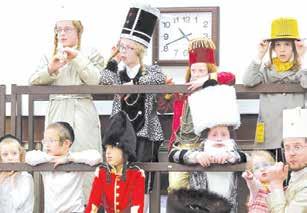
When Yehudah was born, the Torah tells us, “Va’ta’amod m’ledes” (Bereishis 29:35), which can be interpreted as “this birth brought amidah, stability.” The Kisei was finally stable and fully supported. Yehudah was the progenitor of David HaMelech, who provided the fourth leg of the Throne.
The Shelah HaKadosh writes that David HaMelech, through his descendant Mashiach, will provide the fulfillment of the pasuk, “Ba’yom ha’hu yehiyeh Hashem echad u’shmo echad” (Zechariah 14:9). This is alluded to by the sofei teivos of the final three words, “echad u’shmo echad,” which spell David.
The Shelah HaKadosh then directs us to analyze the name Yehudah, and we will discover wonders. The name Yehudah contains the name of Hashem — Yud Kei Vav Kei — plus the letter daled, representing David, the fourth regel of the Kisei HaKavod. David made the Kisei HaKavod complete.
The name Yehudah thus is the total antithesis of Amalek. It contains both the complete name of Hashem, and the completion of the Kisei HaKavod. The name Yehudah is testament to the fact that it is no longer “Ki yad al keis Kah.” Both the name and the Throne are complete.
Rav Shmuel bar Shilas made it his life’s mission to counteract the life mission of Amalek and Haman by teaching Torah to children. He worked to perfect the message inherent in his father’s name, Shivisi Hashem l’negdi samid. He constantly pictured the name of Hashem in front of him.
When his son was born, what better name to choose than Yehudah? He named his son Yehudah, symbolic of the full name of Hashem and of the completed Throne, both of which Amalek and Haman had sought to undermine.
In perfect symmetry, the memra had to be presented in this manner and by these very individuals.
When Jewish children are engaged in the study of Torah, Eisav has no power over Klal Yisrael.

The travel time from Quebec City to Fredericton is relatively long. We decided to make this six-hour drive without any major stops so that we would have four full days to explore two of Canada’s maritime provinces, New Brunswick and Prince Edward Island.

Sunday was a beautiful day, but the drive along the Quebec portion of the highway was completely non-scenic, even though we were traveling along the St. Lawrence River. The scenery immediately improved as we entered New Brunswick. For starters, there were hills and valleys flushed in greenery alongside the road. The short stop we made at scenic Grand Falls also broke the monotony of highway driving. After checking into our motel, we walked around the historic section of Fredericton and took a thirty-minute walk over the old rail bridge spanning the Saint John River. After eating our microwaved dinners, we retired for the evening. Tomorrow, we would have more vigor to explore our surroundings.
On Monday morning, we took a guid-

 By Hershel Lieber
By Hershel Lieber
ed tour of the very same historic section that we saw the day before. The difference was that we had a guide who gave us a meaningful appreciation of New Brunswick’s capital. We had ample time to take
tractions. Nevertheless, the rural beauty was a treat that we could not deny. In addition, we entered a pottery shop where the proprietor was eager to show us her creations. She gave us a step-by-step
stopped, although the sun did not appear. We visited the Resurgo Museum but did not find it too interesting. It was geared more for schoolchildren. Then we went to see Magnetic Hill, which is an optical illusion that seems to cause a car to roll backwards up a hill. We put our car gear into neutral, and we seemingly rolled up a steep hill. It was an odd experience which really is just a false impression.
photos and ask questions, which enriched our awareness of this unique province where both English and French are its official languages and both cultures are celebrated in harmony. We then went to the Beaverbrook Art Museum and arrived in time for their morning tour. After lunch, we drove out to Gagetown – about an hour’s distance away. The brochures definitely overrated the town’s meager at-
demonstration of how she designs and crafts her earthenware objects d’art, and we bought a lovely serving bowl in blueish and greenish hues. We had a lovely relaxing day, exactly what we envisioned when we planned this itinerary.
Wednesday’s drive to Moncton was only two hours, but it was pouring almost the entire time and at times very heavily.
Lo and behold, when we arrived, the rain
Our next stop was the highlight of the day. Hopewell Rocks on the Bay of Mundy is a truly magnificent sight. It is the location of some of the world’s highest tides. The unique natural experience can be appreciated both during high and low tide. During low tide, these massive rock formations present awe-inspiring nature that the Ribbono Shel Olam privileged us to behold. During high tide, they are completely covered by the ocean. We arrived there during low tide and were able to walk between these enormous rocks on the sandy beach, which only hours earlier was completely submerged under fifty feet of water.
We put our car gear into neutral, and we seemingly rolled up a steep hill.
Wednesday, bright and early, we left Moncton towards Prince Edward Island. I read about the village of Le Pays de la Sagouine, which is located in the town of Bouctouche, and about its Acadian past. To travel there required an hour’s detour from our intended destination. Nevertheless, we decided that it was worthwhile to have some knowledge about the origins of the French-Canadian settlers and the indigenous Algonquian people with whom they shared the territory. That history was brought to life when we visited the recreated village, its homes, and its work-
shops. The guides detailed all aspects of Acadian culture and family life as we wandered between the colorful buildings. We were treated to a musical concert consisting of the music and songs of that era. We also started to appreciate the struggle of the original French pioneers against the English invaders and the continuous efforts to maintain their culture, religion, and language.
Our drive to Charlottetown, Prince Edward Island, took us past some of the most pastoral scenery that we enjoyed thus far. We headed straight to




the Confederation Court Mall where we ate our prepared lunches and then took a self-guided two-hour walk around the historic center. The quaint houses, the picturesque park, and the interesting shops captured our attention. Prince Edward Island’s main claim to fame is that it is home to the story of “Anne of Green Gables.” Many attractions developed from this theme including a musical presentation of the famed novel. We stayed in the city for a quite a long time in order to get the most of our limited stay and did not return to Moncton before midnight.
The final leg of our Canadian stay was in Saint John, where we spent Thursday. We took a two-hour bus tour which gave us a detailed history of all the sights that were seeing. We also made a stop at an indoor market which was both colorful and had an array of diverse merchandise on display. Our fellow passengers were mainly from the cruise ships that make a stop in Canada’s oldest city. We befriended a couple from Tacoma, Washington, and shared some conversations with them. The guided tour also took us to the Reversing Rapids, where, twice daily, the

mighty waters of the Bay of Fundy cause the Saint John River to flow backwards. We were able to view this unusual phenomenon.

We did not have the time to experience Jewish life in New Brunswick, although there is an Orthodox synagogue in Moncton with a Shabbos minyan as well as a mikvah. Saint John and Fredericton have non-Orthodox congregations with occasional prayer services. These shuls’ beginnings were originally Orthodox, but as the younger generations became less affiliated in general and less observant in particular the shuls made changes to their own traditions. All three cities maintain
Jewish museums that tell the story of Jews in these maritime communities.
On Friday we had a dilemma as to what to do on our way back to the States. On the one hand, there was a possibility to go on a boat for a whale watching cruise. The sky was threatening with rain, and the two-hour sail on the Bay of Bundy would end at one in the afternoon. We would still have a three-hour drive to Bangor, Maine, our Shabbos destination. We decided not to take the chance, and hopefully we will one day witness the great sea mammal at a more opportune time. Instead, we made a stop at St. Andrew’s Kingsbrae Gardens, a few kilometers before the border
crossing. We were truly gratified that we made this choice. For one, it was raining the whole time during our one-hour drive and yet the sun came out in its glory as we arrived. The Botanical Gardens with its themed gardens, ponds, streams, and sculptures is a horticulture masterpiece! There was a barnyard with a collection of sheep, goats and llamas, while peacocks strutted about on the grounds. In addition, we were also only a two hours’ drive from our hotel in Maine.
After checking in to our room at the posh Hollywood Casino Hotel in Bangor, we went to meet Rabbi Chaim Wilensky, the rav of Beth Avraham and Bangor’s Chabad shliach. Rav Chaim helped me arrange Shabbos seudos that would be delivered to my room together with a hot plate by the shul’s sisterhood. The Wilenskys lived too far away so they could not invite us for Shabbos meals. It was hard to book any room during this weekend, which coincided with a major music festival, so we were fortunate that we were able to reserve the room we had. On the other hand, we were happy to relax alone after a whirlwind week of traveling and touring. Although there was no minyan Friday night, on Shabbos day we had a fair showing. I davened Hallel and Mussaf as it was Rosh Chodesh Elul and gave the dvar Torah at the kiddush. On Motzei Shabbos, we went to the Wilenskys for a lovely Melave Malka. Rav Chaim told us about his upbringing in Portland, Maine, where his father is the Chabad shliach.

On Sunday, we began the final legs of our return trip to Lakewood. We stopped in Augusta to view the State Capital Build-
ing. We then headed to Portland, where we visited the Victorian Mansion and The Portland Museum of Art. We also took an hour-long trolley tour that highlighted Portland’s history and landmarks. We then made our way to Boston where we had dinner in Brookline and then stayed overnight in Springfield, Massachusetts.
The next day, we made two stops. First, we visited Hadassah Wiener and her newborn son Henry in New Haven, Connecticut. We know each other from our years at the Lauder Retreat in Poland where we forged a strong relationship. We also spent some quality time with our dear friends David and Susy Avigdor at their beach home in nearby Woodmont. We enjoy their company and are always eager to get together.
It was hard to believe that in just two weeks we traversed six states and three provinces of the American continent. Most of the places we visited and many of the people we met left an enduring mark in our memories. We are getting older. but our passion for traveling has not waned!
Hershel Lieber has been involved in kiruv activities for over 30 years. As a founding member of the Vaad L’Hatzolas Nidchei Yisroel he has traveled with his wife, Pesi, to the Soviet Union during the harsh years of the Communist regimes to advance Yiddishkeit. He has spearheaded a yeshiva in the city of Kishinev that had 12 successful years with many students making Torah their way of life. In Poland, he lectured in the summers at the Ronald S. Lauder Foundation camp for nearly 30 years. He still travels to Warsaw every year – since 1979 – to be the chazzan for Rosh Hashana and Yom Kippur for the Jews there. Together with Pesi, he organized and led trips to Europe on behalf of Gateways and Aish Hatorah for college students finding their paths to Jewish identity. His passion for travel has taken them to many interesting places and afforded them unique experiences. Their open home gave them opportunities to meet and develop relationships with a variety of people. Hershel’s column will appear in The Jewish Home on a bi-weekly basis.

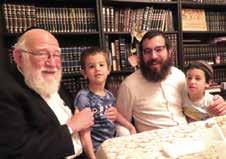


Even before we were married, I had heard about my wife Keren’s greataunt Belle Kirschenbaum. At the time,she was almost 80 years old, living on Rehov Alozorov in Rehavia, Yerushalayim. She was an institution to her family and friends – a fiery, opinionated woman, who carried her strong New York accent like a badge of honor. She’d been coming back and forth to Israel since 1948 and eventually moved here after she retired.
Belle had a coterie of close friends and scores of acquaintances with whom she kept in contact. She had an antiquated olive-green rotary phone that sat on her hallway desk in stark contrast to the soft colors of her apartment. The phone, however, wasn’t her choice of contact. Instead, Belle loved writing long, handwritten letters. She kept a record of her correspondence in two large tote bags that she’d shlep with her everywhere.
When staying with us over Shabbat, I’d pick her up early on a Friday morning. Upon arriving at our apartment, she’d set herself up at the dining room table which soon became strewn with letters and envelopes. She’d spend hours on her correspondence before she had to vacate the table for the Shabbat tablecloth.
She had a knack of identifying lonely people and befriending them. Some were her age, but many were youngsters. There were occasions – too many to count – when she’d introduce us to someone, who in turn mistook us for one of the befriended. During one visit, we were introduced to Ruth, just Ruth, one of Golda Meir’s close friends.
Our children quickly learned to adjust to her appearance; her choice of attire was anchored in post-war America. She was never into style, even if she always sport-
ed large, black sunglasses that eventually spooked our youngest daughter.
She worked in the same bank in New York City for years. She never married. She had a reputation for being different. Family folklore has it that the numerous trips she made to Israel post-War of Independence were a ruse to smuggle documents into and out of the country. Even if it had been true, she wouldn’t have told us.
Belle was instrumental in funding the Braille siddur.
With no one else to look after her, she arranged her affairs meticulously. During
we have to travel from the north. The excuses I make cannot detract from the frustration at always going through the same ritual at the Eretz HaChaim Cemetery just outside of Beit Shemesh.
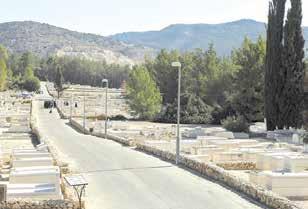
We drive through the gates, and, car still running, I visit the gravesites of my late Rav, Harav Ze’ev Chaim Lifshitz and his family. Then it’s back into the car and down the road where we park at the long tap on the right side of the road. We then walk up our steps to the left and start looking. Ironically, every time we do find her grave, it seems to be in a slightly different
Rabbi Freilech has been working in Eretz HaChaim since 1980. Soft spoken and mild of manner he carries about him an air of comfort that must certainly be a blessing for families who are looking for support in their hour of need.

“Whose grave are you looking for?” he asked.
“Belle Kirschenbaum.” Rabbi Freilech looked up and shook his head.
“Not Belle,” he said. “You mean Bluma.” Belle had died twenty-eight years earlier. How could Rabbi Freilech be so sure? He continued, “AACI (The Association of Americans and Canadians in Israel) block 7, plot 5, third row.” He raised a thick booklet from his desk. “Just let me check. Kirschenbaum, aha, yes, here she is. Yes, just as I told you.”
the late 1980s, she took my late motherin-law on a trip to show her the tombstone she had designed for herself. She’d joke that the only thing missing was the date of her death.
When she did succumb to old age and ill health in November 1995, we soon discovered she had not only taken care of her tombstone and burial plot but her estate as well. As her closest relatives living in Israel, there was no tidying up to do.

Since her passing, Keren and I have visited her gravesite on numerous occasions. Unfortunately, we always seem to have a problem locating the grave. Perhaps it’s the irregularity of our visits due to the distance
location. As ridiculous as that may seem, when after searching, Keren and I do eventually find the spot, we are always left unsure about the distance between the grave and the road.
In January, we traveled south for a few days and went to visit Belle. This time, we had no luck finding her. It was as if she was hiding from us. Back and forth and up and down the roads we traipsed until we had to give up and continue on our way to Yerushalayim.
A few days later, we decided to try again. This time, I walked into the office where I met Rabbi Freilech, whom I recognized from previous visits to the cemetery.
I walked back to the car where Keren was waiting for me. I told her that either Rabbi Freilech was a savant, or he had an amazing memory. We followed his instructions, and within minutes, we were standing at Auntie Belle’s grave. I insisted that it looked to me that she was closer to the road than on our previous visits. That was just my fancy, however.
A few days later, I called Rabbi Freilech to once again thank him for his help. I told how amazed I was that he had been able to remember the exact position.
“Does the Rav remember every grave in the cemetery?” I asked him.
“No, I don’t. But Mrs. Kirschenbaum’s I recall. She stood out.”
“She was a very special lady,” I said.
“Yes, she was,” said Rabbi Freilech. “Very special.”
Family folklore has it that the numerous trips she made to Israel post-War of Independence were a ruse to smuggle documents into and out of the country.My mother-in-law, Evelyn Grossman, left, with Belle Kirschenbaum at our wedding in 1985 Eretz HaChaim Cemetery just outside Beit Shemesh

“Money isn’t everything,” they say. But money isn’t nothing, either. Any way you look at it, money is a critical component of life – not something we can afford to ignore. As one wisecrack goes: “All the happiness in the world can’t buy you money.” But that is universal. What is unique about the Orthodox Jewish world with regards to the topic of money? And why is it important to talk about it? And last, but certainly not least, is there a spiritual side to earning money?
Around two years ago, Yaakov Langer founded a podcast network, which he named “Living LChaim.” The podcast rapidly gained traction on the Jewish scene and is constantly expanding. Originally, Yaakov focused his interviews on inspiring figures in the Orthodox Jewish world and what they can offer the community in terms of wisdom, encouragement, and, well, inspiration. At one point in his work, delving into public issues and discussion, he became aware of a void in the community. And that was the topic of money.
Yaakov noticed two paradoxical phenomena. On the one hand, many in the frum community were struggling with finances. And a big part of the struggle was simply not knowing where to turn, what to do, and where to go. There was a lack of knowledge of how to navigate the realm of making and keeping a living.
On the other hand, there was a certain stigma of talking about the topic openly. Yes, people can go on and on about their business, their endeavors, and sometimes their lavish lifestyles, but often, the heart of the subject is deliberately avoided. People hesitate to discuss their struggles and their doubts and are slow to ask for help. Worse yet, we often tend to paint a false picture of our financial situa tion, presenting an image of being well-to-do, while borrowing money we have no idea how we will repay. As one of the guests on “Kosher Money,”
Naftali Horowitz relates, he once saw a young man parking a luxurious Range Rover and then the owner admitted to him that he barely could af ford to fill its tank up with gas!

Making a living was never a simple endeavor, but there is something uniquely challenging about the modern-day busi ness world. The hyper-fast pace of the digital, super-connect ed world, the crowded field of competitors that connectivity has created, the unprecedented level of sophistication in almost every field, and the turnover rate for new tech nology, processes, and even society’s mindsets is a never-ending, and often ultra-stressful, rat race.
To top it off, an Orthodox Jewish life is by and large way more expensive than a secular one. From tuition to weddings, from kosher food to clothing, and often multiplied by a much larger family than
the typical, secular, Western size, there is almost no comparison. (Sorry, I didn’t mean to scare you. We’ll talk about bitachon soon.)
On the bright side, as Orthodox Jews, we are there for each other. Many busy and successful people are glad to give of their time and money to help and guide beginners or otherwise struggling families and individuals – from gemachim to help start businesses, to mentorship organizations such as The Jewish Entrepreneur (JTE), which help aspiring entrepreneurs and guide them in the right direction, to Achiezer and the OU’s Living Smarter Jewish, helping with budgeting and smart spending, as well as many individuals helping individuals outside the context of an organized “organization.” But awareness is key. In order to take advantage of these resources, you have to know they exist and how to find them.
And so, Yaakov turned to his brother Eli and invited him to come board the podcast train and branch off into a podcast focused on helping and mentoring young Jewish adults with income-related topics. Eli had a background in finances – between his bachelor’s degree in the field and his experience in real life. And so, Yaakov, Eli, and Zevy Wolman over at the Orthodox Union helped create a new show named “Kosher Money.” Kosher Money proved to be wildly popular, with a few episodes (“Wanna Build Wealth? Avoid These Money Mistakes, Feat. Naftali Horowitz” and “The Secret to Becoming Truly Rich, Feat. Rabbi Manis Friedman”) each garnering over a million hits on YouTube alone. And their list of viewers is not limited to Jews. Despite the fact that they are primarily geared for our audience, ultimately, their message is human-to-human, and anyone can relate to it. In fact, Kosher Money has already collected 117,000 subscribers (!), many of whom are non-Jews.

Kosher Money is the big brother, the personal mentor many of us never had. The show brings on guests who have been there done that and are solid – solid in their knowledge and wisdom and solid in their intentions.
Eli and Yaakov are very careful in screening their potential guests. They want to ensure they bring to the table someone who is genuinely looking to help the community, not to promote
themselves or their businesses. In fact, a red flag for them is when someone recommends himself or herself to appear on the show. And Eli keeps his ear to the ground. His podcast is very interactive, and he gets constant feedback and suggestions from listeners. He then chooses guests and focuses his questions based on the interest of the listeners.
Some of the guests featured include investing guru Eli Fried; author of the best-selling book Thou Shall Prosper Rabbi Daniel Lapin (a friend of popular show host Dave Ramsey, as well as a show host in his own right); and Naftali Horowitz of JP Morgan Wealth Management, among other prominent figures on the Orthodox Jewish financial scene.
The podcast guides, educates, and encourages newbies to pros on many fundamentals of parnassa topics. If you want a job, there is an episode where Eli discusses with business consultant Ned Schoenfeld what are the available high-paying jobs and how to find them. In another episode, Andrew Singer, VP of a Fortune 100 company, shares advice on how to handle job interviews and what are the no-nos you should avoid. He also gives a crash course on sales skills and techniques. Yet another episode was done with Eli’s close friend Mitchell Eisenberger, in which he shares tips for working your way up the career ladder in the workplace. Although Mitchell is not a high-powered executive, he has much in the way of personal experience, having gone through many ups and downs himself, and he has a lot of simple, practical advice, which is implementable and relatable, and listeners loved it. For example, he explains how you can keep track of your “wins” at work and then come to the boss at the end of the year or contract term with clear evidence showing your value to the company. After that show, Mitchell nearly 1,000 follow-up calls and emails, and he happily assisted whomever he could, free of charge. He also received thank you messages, in which listeners related they had followed his advice and walked away with significant raises, helping themselves and their families.
Thinking of going the entrepreneur route? Noam Wasserman has wisdom to share on this topic, so that you don’t jump in blindly.
Tzvi Pirutinski from PCS of Lakewood discusses transitioning into the workforce, how kollel families get by, and other related topics.
calls from people who want help in the areas they had discussed, be it budgeting, starting a business, home buying, or investing. One guest, Stacey Zrihen from the Achiezer team, had discussed the crucial issue of budgeting on the show along with other practical issues regarding running a family’s finances. For the next two weeks, she received nonstop calls and messages asking for help, which she responded to graciously, devoting her time free of charge, to help the community. Naftali Horowitz fields thousands of emails from people looking for advice, and he doesn’t charge them a penny. In fact, for those who want to hear more from Naftali, he is going to be the keynote speaker at Kosher Money’s first-event live event in the Five Towns, which will be taking place on Tuesday, February 28.
Listeners also learned that ensuring your money is transferred to your inheritors after “one hundred and twenty” is not always as simple as you might think. If not set up right while the parent is alive, children or other inheritors can face an uphill battle to prevent a lot of the money being lost to the government. An episode on life insurance was also extremely popular, with many people realizing their coverage left a lot to be desired. Health insurance also had some surprises for some people, who were not aware they were paying for coverage they did not need.
There’s even an episode with Rabbi Binyamin Babad from Relief Resources, on the intersection of money and mental and emotional health.
Visiting Kosher Money, you suddenly discover subjects you never realized were a “thing,” analyzed by experts, with many important points brought up, pointed out, and explained.

Feedback from listeners and viewers is tremendous. Eli gets many messages from people who were directly helped from the show. And that is so valuable to him. Many of his guests receive hundreds of follow-up
Even guests who make a living from the advice and coaching they offer, such as estate planners, are happy to answer short basic questions free of charge.
Speaking of money, what do the founders of Kosher Money get out of their show money-wise? Guests who appear on Kosher Money do not charge for their time, nor are they charged for being part of the podcast. As for Yaakov and Eli themselves, Kosher Money runs a few ads on their show, which, in addition to the revenue they get from YouTube, helps cover their operating expenses. Whatever profit is left over is largely put back into the pot, to help them expand even further.
Eli and Yaakov are careful even with their advertisers and avoid running ads for shady ventures, like get-rich-quick and the like. Though it’s “just an ad,” they like to take responsibility for all material that goes out to the public through them.
As believing Jews, we know that money has a spiritual dimension, too, which is its true intended purpose. Our objective is to use and pursue money wisely and not fall into the trap of its uglier side.
Indeed, a significant part of the podcast is devoted to this angle.
By helping others, and by recognizing that parnassa comes from Hashem, we transform the gritty and sometimes dark pursuit of making a living into a holy endeavor.Kosher Money’s Eli Langer and Zevy Wolman interviewing personal finance guru Dave Ramsey at Ramsey Solutions HQ in Franklin, Tennessee for a special episode
On one episode, Eli brought on super-popular YouTube Rabbi Manis Friedman (brother to superstar singer Avraham Fried, a.k.a Avreimel, a.k.a Avraham Friedman) in an episode devoted to the deeper and more spiritual side of money (and life in general), which turned out to be its most popular episode to date with over 1.2 million views and streams.
Eli also discusses practical halacha issues involving money and the modern business world with Rabbi Yosef Kushner, a leading authority on this topic. And he delves into hashkafic topics with OU’s Rabbi Moshe Hauer, such as how to balance bitachon with hishtadlus, women in the workplace, and tuition, as well as the topic of giving maaser from earnings.



Eli Langer grew up in Brooklyn, NY, and attended Yeshivas Chaim Berlin. (Fun fact: in addition to his brother Yaakov, he has two other brothers: Avraham and Yitzchok. So his family covers all the Avos, although we’re not sure where “Eli” fits in there.) He received a BA in finance at Touro College, which, as mentioned, gives him a background in discussing money-related topics. He then got a job at CNBC at the sports desk. The focus of the show was the intersection of sports and money. Eli’s job was helping reporters leverage their social media accounts. At that time, social media was still a new concept, and journalists needed training to maximize its power. Eli was the only Orthodox Jewish man in the office, and he became known as the “guy with the yarmulka.”
Eli’s work was mainly behind the scenes, and so he was rarely “on TV,” but on occasion, he did appear partially, among the staff, in the wide shot before the commercial would begin.
Eventually, though, Eli’s family grew, and his expenses grew along with it. He joined up with Aron’s Kissena Farms, becoming their social media account manager, and eventually Eli founded Harvesting Media, along with the owner of Aron’s, which Eli now heads. His work at Kosher Money is not a source of income for him; at least, not for now. His “payment” is the rewarding feeling he gets from knowing he has changed lives for the better and going to sleep knowing he made a real difference in other families’ financial stability.
For now, Eli looks forward to expanding his reach even more and stimulating more conversation around the topic of money in the Orthodox Jewish world. As he says, breaking the stigma, the taboo status of the topic of money, is liberating. And learning not to fear being honest about it and open to seeking help is refreshing.
As a fellow interviewer, I have become aware that interviewing is not always as simple as it may seem. To the untrained eye, it can seem like the interviewee is doing everything, and the interviewer is simply ask-

ing questions. Can’t we all ask questions? What skill does the job require? But, in fact, interviews don’t always succeed on their own. Some people are more inhibited; others can focus on the wrong things. It’s up to the interviewer to find the desired “juice” within their subject, guide, and help him or her bring it to the fore.
I asked Eli how indeed he gets his subjects to give such quality interviews. He explains that it’s all about listening skills. Sometimes you feel like you just want to stick in your two cents, or interrupt with another question, but that usually just shuts down the interviewee. And listening means active listening, taking an interest, and interacting with the flow of conversation which the interviewee is leading.
Eli comes prepared with a list of questions he would like to focus on, based on his own judgement, as well as the input of his listeners/participants. When needed, he can gently steer the interviewee back to the topics and questions his listeners want answered. But he lets the interviewee go off in their own direction, too, up to a point. If the interviewee rambles, and spends too much time on a topic or segment Eli feels is not so relevant, he can simply edit it out later, as the show is not live. In reality, though, that rarely happens.
I asked Eli if he has had any disaster interviews or segments of interviews. He says that thanks to the rigorous screening and his preparation ahead of time, that has never happened so far. Before the show, he checks to make sure the guest has good “flow” and advice to share. He is also in touch with the guest to discuss what the main focus will be. Sometimes, the guest will send a list of questions they want to address, but Eli will cut a considerable amount out, in accordance with the feedback of his listeners.
Interestingly, the most popular episodes have not so much been the ones with clear-cut practical advice but rather the ones which are more spiritual or conceptual and those which are story-based. For example, the episode with Rabbi Lapin, although low on actionable instruction, provides a spiritual angle to the quest for parnassa, explains why historically Jews tend to out-perform their non-Jewish counterparts in attaining prosperity (25% of the Forbes 100 List are Jews), and describes what Rabbi Lapin feels is the Jewish perspective on attaining wealth. That episode was a particularly big hit.
“Give a man a fish and you feed him for a day. Teach him to fish, and you feed him for a lifetime.” As Jews, the idea of being there for each other is ingrained in us. Often, you will find Jews helping their competitors establish themselves in business and sending them customers. By helping others, and by recognizing that parnassa comes from Hashem, we transform the gritty and sometimes dark pursuit of making a living into a holy endeavor. Ultimately, in the context of a Jewish approach, “money” can indeed be “kosher” – and that is what Eli, Yaakov, and their guests are doing.
And that is what the viewers and listeners will be inspired to do as well.


Hi. My name is Sara,* and I’m currently in 8th grade and the school I go to is co-ed. The middle school I go to has a high school attached to it that mostly everyone in my grade is going to continue on to. After a really inspiring summer in camp, I decided that I don’t want to be in the co-ed environment anymore. Also, a few of my older siblings have gotten more religious. But I’m really stuck and conflicted.

Teen Talk, a new column in TJH, is geared towards the teens in our community. Answered by a rotating roster of teachers, rebbeim, clinicians, and peers (!), teens will be hearing answers to many questions they had percolating in their minds and wished they had the answers for.

My question is how do I know if I’m making the right decision? A few people have told me that I’m going through a phase that I want to be all religious, but when I start ninth grade in a completely new school with no one I know and an all-girls class I’ll regret my decision and wish I had just stayed in my middle school with all my friends.

I really think that this is what I want but I don’t know for sure, and I don’t know how I’m going to know if I’m making the right choice. It makes me really anxious to think about it. I really need help because I don’t know how to make the right decision.
-Sara*Hi Sara,
I am so glad you wrote to me. I assume that the schools you are considering are just now sending out acceptance letters, so I hope my response catches you at a good time. It sounds like you are trying to think for yourself, even if it might mean choosing a different path than those around you. That is a brave (and hard) thing to do, especially at your age when peer pressure is so strong. Beyond that, you are trying to think for yourself regarding a decision that is of real relevance. This is not just an I’m-going-to-wear-this-brand-even-though-myfriends-think-it’s-dorky kind of thinking for yourself. Or an I’m-going-to-eat-beetsin-school-even-though-my-friends-thinkit’s-gross kind of thinking of yourself. This
is bigger. Choosing a high school is a significant decision. I would guess that, for many, it feels like (at least one of) the biggest decision(s) they have ever had to make.
Before going further, I want to share that one of the reasons big decisions feel so big is that we think our job is to figure out which choice is the right one . There are so many decisions that I have lost sleep over and just wished I could google the right answer! But pay attention: as much as our brains tell us there is one right choice and one wrong choice (and that we have to figure out which one it is), it is almost always not the case.
When we think this way – and actually some people tend to think like this quite often – it is our brain engaging in a type of thinking error (basically an inaccurate and unhelpful way to think). Some people call it black-and-white thinking, because it is the tendency to view things in extremes – for example, to see things as either totally good or totally bad (just like only seeing things as black or white) – instead of seeing that things are more complicated (and that sometimes a color can be grey). Instead of trying to figure out which school is the “right” one, it is much more accurate and helpful to think of it in terms of which one might be a better choice.
Of course, when we want to make a big decision, an important first step is to gather information: I am sure you have done much of this already. We gather information by reading and by listening and by talking to people. We also gather information through experience, such as during the interview. Beyond that, many schools offer the opportunity to spend time in their school, even if they don’t publicly offer the option. These are all valuable ways to understand your options more.
Two words of caution: First, be wary when talking to people, as some “information” that you receive is subjective; it is someone’s personal opinion, not fact. Which means the next person you speak
If you have a question or problem you’d like our columnists to address, email your question or insight to editor@fivetownsjewishhome.com , subject line: Teen Talk.


may be helpful to analyze your concerns and considerations just a bit just so you can cut down the list to factors that are actually relevant to you. Are you concerned that this may be “just a phase”? Are you worried about being overwhelmed in a different environment? Are you thinking you may regret this decision? Or are some of these other people’s worries?

My feeling is that it is hard to predict whether something is ever a phase or a real change. I think that is partly determined by what you want and what you do with it. If someone is inspired to do something they think is good for them, they can let an opportunity for growth slip by or they
some curiosity and even excitement.
Keep in mind that whatever decision you make, you are not absolutely stuck. Although there is a level of commitment when you decide to go to a school, if it is not working out, there are opportunities to switch to a school that is a better fit. Thinking this way also takes off the pressure and allows you to think more freely.
(I will share a side point with you… Part of you may be fearing that you would be entering into a foreign country if you go to an all-girls school. You may be feeling that it is so extremely different than your current school and your current social environment. I want to share that girls-only schools are not all the same, and some of them have such a wide variety of girls of different religious levels…many of whom, just like you, were choosing between co-ed and single gender options.)
with might have a very different view to share. Second, be wary that some of us can get stuck in information-gathering mode; at some point, you will have enough information and trying to gather more can not only be unhelpful but can actually leave you more confused.
After you gather your information, the big job is to try to make sense of all of it. What is important to me. What isn’t? What are my priorities (no school is perfect)? Where will I grow? In terms of this specific decision, it sounds like you are having a hard time discerning your own concerns and other people’s voices in your head. It
can grab it and do what they can to make something of it.
High school is an adjustment for everyone. Even if you were to stay in your current school, it would most definitely not feel like you “just stayed in middle school.” Graduating and moving on to high school is an inevitable, unavoidable change for everyone, and no matter where you end up going, the beginning can be tough. It is a new environment with new expectations, and, even if someone starts high school with a big social group, it is a time of shifting friendships. This can be seen as a source of apprehension, but it can also be approached with
It seems that a big part of your decision is whether you play it safe (stay) or step out of your comfort zone (go.) Growing can most definitely be uncomfortable, but stepping out of our comfort zone is how we grow! In terms of regrets, those are unavoidable. Even if you decide to stay with your friends, you may regret that decision, too. At the same time, know that whichever environment you find yourself in, now and in the future, you can always work hard to seek the growth opportunities around you.
I will leave you with a strong suggestion that you daven for clarity and siyata d’shmaya regarding your decision – this is one of the best pieces of advice I can give you.
Wishing you so much hatzlacha!
-Estee
Growing can most definitely be uncomfortable, but stepping out of our comfort zone is how we grow!
My husband and I sometimes invite his still-single friends over for meals on Shabbos. Recently, my husband asked me why I don’t try to help set up one of his friends, whom I’ll call Shlomo.
Shlomo is a put-together, successful man in his late-thirties. He seems to have everything going for him. But I noticed that he could be very self-centered and very stuck in his ways when it comes to certain things.

Here are my three questions for you:
1. Should I not set him up because I see these two issues and those issues could get in the way with someone being a good spouse?
2. Is it possible that Shlomo is self-centered and stuck in his ways because he is single now but will not be like that when he is married and needs to focus on someone else?
3. How much thought should a shadchan put into making a shidduch? Should the shadchan have to make sure that the people they are setting up have only good middos? Or should they rely on people doing their due diligence when checking out a potential spouse?
Thank you, Adina*

Adina, glad you are airing your questions. You want to be helpful as well as fair to Shlomo and potential daters.

In general, I think that if you have a relationship with someone for a long time, i.e., Shlomo, who is a regular guest and friend of your husband’s AND has been dating for years, it’s fine to carefully suggest using a dating coach. You could say, “Have you ever considered talking to a dating coach about your dating life or a specific young woman?”
Self-awareness is crucial to growth and communication both in and out of a marital relationship.
Wait until the subject comes up, of course. Think it through beforehand
how you will introduce the suggestion. This way, you will be comfortable setting him up as well as helping him out in general.
Adina, do not delude yourself. Marriage doesn’t fix character flaws. As Dr. Abraham J. Twerski used to say so vividly, “Marriage is not a hospital.”
In answer to your third question, I strongly believe that it’s important to do some homework before making shidduch suggestions, especially for people who are dating for a while. It can be very hurtful to people to be set up with people from left field. Fixing up people without hearing from them what they are looking for may not always come across as respectful to their needs and respectful of their time. Nonetheless, do continue to suggest matches, but do some due diligence. It’s only right and fair from a “bein adom l’chavairo” perspective.
Adina, you have some very good questions, and I venture to say the answers will help both you and our readership.
Making shidduchim is SO HARD, both on an emotional level (riding the roller coaster helping the couple navigate their relationship), physical level (the long days and nights of always being on call, dealing with many difficult characters) , and even a spiritual level (davening for your couples and constantly feeling the urge to allow Hakadosh Baruch Hu to bring about bracha through your efforts). It is intuitive and socially appropriate people who make shidduchim that make singles feel heard and cared for. It sounds like you are one of those people, so I would like to applaud your efforts.
In terms of your husband’s self-centered friend, if something seems “off” about his behavior, if he comes across narcissistic and self-centered, the best thing you could do is stay away from setting him up. When I was young and naïve, I used to hear the term, “every lid has it’s pot” and truly believed it. Now, however, I believe every lid still has its pot, but not every lid has been fully manufactured in a way not to explode while on the stove. Your hishtadlus is to set up people who seem like stable, healthy people. That is not to say they won’t have issues or things to figure out. But, if you would not set your own daughter up with this boy (knowing what you know), wait until he works on himself before you set him up.
A shadchan must put a lot of thought into a shidduch, and not just haphazardly make matches. That being said, it is up to the singles themselves to do their due diligence finding out about the middos and personalities of their prospects. A shadchan will make a recommendation to a single based on her personal impressions, and it is not the shadchan’s job to call references.
Keep doing your amazing work, hatzlacha!
It’s so refreshing to see someone take extra sensitivity while trying to make a shidduch. I’ll answer your question very simply.
Making a “successful shidduch” doesn’t mean that both parties agreed to a date or even got married. Making a “successful shidduch” means that both parties walked away from the experience feeling dignified and with a positive experience (especially from the shadchan and hopefully from the date). Knowing this information, it’s important to do YOUR part in the most dignified and respected way possible. The only thing in your control is your efforts; the outcome is up to G-d.
If you have concerns, I wouldn’t embellish the idea but rather use your judgment. For example, “I don’t know if it’s a good idea, but my husband keeps bringing it up and I wanted to share it with you in case you’re interested in giving it a try.”
Everyone has flaws. But you need to use your judgement to determine if they’re severe enough to compromise an entire idea.
When I first read your questions, I considered consulting with, and getting advice from, a successful matchmaker who asks singles to fill out a nine-
As Dr. Abraham J. Twerski used to say so vividly, “Marriage is not a hospital.”
page online questionnaire and then uses a sophisticated computer algorithm to determine which singles might be compatible.
But, then I remembered the folk tale about a centipede who had no trouble walking, until asked how he managed all those legs. He started thinking about the process and immediately became frozen in place and unable to do it anymore. In psychology, the effect is known as “hyper-reflection.”
The point of the story is that overthinking and overanalyzing something isn’t always a good idea. It can lead to analysis paralysis, and nothing ever gets done.
Of course, if you do want to set someone up, you must do it intelligently. You cannot simply say, “Let’s see. He’s Jewish. She’s Jewish. They’re both single. Sounds per -
fect!” Use common sense. For example: Do not set up a very religious yeshiva boy with a girl who likes to wear sleeveless shirts and miniskirts. The boy might get a heart attack on their first date.
Do not set up a very cheap, stingy guy with a girl who likes to be wined and dined. If he takes her to a nice restaurant and then asks her to pay for her half of the bill, she might lean across the table and pummel him with her steak knife and salad fork.
Do not set up a man who feels strongly that a woman’s place is in the kitchen with a highly successful, fulltime, university professor. She is likely to give him (and you) a failing grade.
Do not set up a young man who feels that paying taxes is for suckers, and makes his living via undeclared income,
The Navidaters
Dear Adina, Kudos to you and your husband for inviting his single friends over for Shabbos meals. I guess the very first thing I’m wondering about is if your husband knows how you feel about this. If he does, then it is now also on him to decide how he feels about setting Shlomo up with your friends. You are not in this alone. So, how does your husband feel about it?
Have you asked your intuition what it knows to be true? What do you think is the right thing to do? Trust your gut. I can share with you what my in-
stinct is, but it is only my instinct. My instinct is the following:
If Shlomo is some - one that you and your husband care about, and genuinely want to see him married, then depending on the relationship(s), your husband, or you, or you and your husband can invite Shlomo to a conversation in which you share your conflict with him. You know that we really care for you. We really want to set you up. We have noticed that you can be a bit set in your ways. Is this something that
with a young woman who works as the compliance officer at the Internal Revenue Service. Trying to send your date to jail, after a very first date, is not a good way to start a long-term relationship. Do not…well, you get the idea.
But, Adina, back to your questions. I did ask a very successful, local shadchan if she had any advice. She remarked:
“I can certainly see how the character flaws that you are describing, although not dangerous, may be undesirable. Being put-together and successful may sometimes come with being a bit self-centered and inflexible. You should simply tell a prospective date that your husband has a very good friend, who is successful and very self-assured.
“If he goes on a date that you recommend, listen carefully to the woman’s feedback afterwards. If she reports that the guy is much too stubborn and too full of himself, then you will understand that Shlomo may be a nice
Shabbos guest, but you may not wish to be involved in setting him up.”
In any event, Adina, please don’t be like that centipede; follow your natural instincts, take that decisive first step, and good luck!
has come up for you in dating and relationships? I realize that this is very direct, and you may lose your relationship with Shlomo because of this. You can also choose to not get involved at all. And not set him up and ignore it entirely. Personally, I feel that if you have known him over time, and you see a set pattern of behavior and difficulty in his personality that you believe in your heart of hearts has the potential to hurt someone else, I can’t imagine setting him up. This is not an easy situation to be in. Don’t forget that you can completely put this one in your husband’s court after telling him the truth of how you feel. You absolutely do not have to get involved.
With regard to your second question,
should you or your husband decide to be honest with Shlomo about your concerns about setting him up, that is something you can ask Shlomo himself. If you do decide to take the direct and honest route, and Shlomo is angry with you or you lose the friendship over this, then how in the world is he going to be in a relationship with a woman, which requires constant self-awareness, self-honesty, and feedback from his wife... which you’d be trying to make happen for him?
I will leave question three for Michelle Mond, shadchan extraordinaire.
All the best, Jennifer
Do not set up a man who feels strongly that a woman’s place is in the kitchen with a highly successful, fulltime, university professor.
 By Etti Siegel
By Etti Siegel
Q:Dear Etti,
I do not approve of my daughter’s friendship with a certain girl, let’s call her Malky. The teacher refuses to help me separate them. She said it is counterproductive. I feel that every moment that my daughter is friends with this girl, she is learning bad middos and terrible behaviors. We are a more refined family. We speak and act in a more cultured way. Malky is coarse, loud, and has terrible manners. Actuall,y she has no manners.
I see you often say that you don’t know the whole picture, so let me make sure you do. My daughter is in junior high school. She has always been popular. She has a lot of friends. Lately, she has been with Malky, a girl in her class, more often than anyone else.
I’m worried.
-A Concerned MotherYour daughter is lucky to have a mother as caring as you. You are concerned that your daughter is making bad friendship choices and is now with Malky, a girl who does not act the way your family strives to behave.
Before I offer any advice, I want to share something interesting about this age. Before junior high and high school, you, and all parents, have a lot of influence on who your daughter plays with and spends time with. But as they become teenagers, they start to grow up, and sometimes that means that they grow away from the tight reins we might have had on their friendship circle.
Now is the time to show our trust in them that they absorbed our values and give over messages in a different and more subtle way. We need to be there for them as they stumble though these tumultuous times. Shifting friendships is really difficult, and a common occurrence among teenagers, especially girls. One day they are friends with a girl, and the next day that girl seems more friendly with someone else. Our teenagers don’t always see themselves as we see them. You say your daughter has a lot of friends. Perhaps she does not see it that way (even if it is true).
At the same time, perhaps what you are seeing is not a clear picture as well. Perhaps your daughter is being a good influence on Malky. Malky is lucky to be hanging around a girl as put-together as your daughter! Or perhaps Malky is sticking to your daughter, and she is conflicted about what to do. She knows being mean
is not a value she was taught, and perhaps she does not know how to extricate herself from the situation.
The first thing to do is make sure you have an open line of communication with your daughter. Talking is best when you are not sitting face to face. From all my years as a teacher and parent, the word is that the deepest mother-daughter conversations seem to happen when Mommy is somewhat occupied, allowing the daughter to feel less scrutinized as she talks out her feelings. Have your daughter dry dishes as you wash them, or keep you company as you prepare the salad, or chat on a drive home together; these are times you can encourage your daughter to talk.
You must be non-judgmental. Once you get the conversation going, your job is to repeat what you are hearing or make listening sounds. Judgmental comments will shut the conversation down.
Opening conversations can be as simple as, “I am so glad we have this time together! I feel like we haven’t touched base in a while. How’s school going?” or “Did I ever tell you about the time I got in trouble at school? It was so embarrassing.” Your daughter might or might not tell you what you want to hear, but she will pick up a very important message. You like her and enjoy spending time with her.
Get to know her friends. Encourage your daughter to invite Malky over and be friendly and open. Invite them to have snack in the kitchen while you prepare
supper and listen to their conversation. Collect tidbits to compliment your daughter on later (“I was so impressed with how you were taking care of your friend’s needs” and “You really are a good listener”). You might be less concerned after spending quality time with your daughter and her friend. You might try to find out what attracts your daughter to this friend. Maybe there is social clout to be had. Maybe she is doing a chessed, and it took over. Knowing why can help you support her and be there for her as she begins to find you a safe person to share her thoughts with. You are not a safe person to talk to if she is worried about disappointing you. Her love for you will cause her to keep things from you unless she is sure of your non-judgmental support.
Above all, be patient. Share stories, schedule time, and trust that all the values you have been inculcating until now are there for her to remember.
And get used to biting your lip. Your daughter is going to need to make mistakes. That is how people learn. If we stay supportive, then we are there for them when they need us. If we lecture or get upset, we are the last person they turn to in times of need.
They say raising teenagers is hard. I agree. The hardest part is watching from afar, and hoping they make the right choices.
Hatzlacha!
-Etti
From all my years as a teacher and parent, the word is that the deepest mother-daughter conversations seem to happen when Mommy is somewhat occupied.Mrs. Etti Siegel holds an MS in Teaching and Learning/Educational Leadership and brings sound teaching advice to her audiences culled from her over 35 years of teaching and administrative experience. She is an Adjunct at the College of Mount Saint Vincent/Sara Shenirer. She is a coach and educational consultant for Catapult Learning, is a sought-after mentor and workshop presenter around the country, and a popular presenter for Sayan (a teacher-mentoring program), Hidden Sparks, and the Consortium of Jewish Day Schools. She is a frequent contributor to Hamechanech Magazine and The Journal for Jewish Day School leaders. She will be answering your education-based questions and writing articles weekly for The Jewish Home. Mrs. Siegel can be reached at ettisiegel@gmail.com.

My young son came off the bus upset over an incident in school – another boy had done something to him. I knew the other boy’s family well but was unsure of the correct approach. The mama bear in me started to growl, but the introvert in me didn’t want to make waves. I called my mother, an experienced teacher, who calmed me down and guided me as to what to do next.
Last week, we discussed increasing confidence in children as a means to improve their safety. Part of advocating for themselves involves encouraging our children to reach out to us, the adults in their lives. Realistically, children can’t do it alone nor should they be expected to.
We often hear about the extremes of parental responses. Some parents leave their child to fend for themselves, regardless of the circumstances. Others hover over their child and intervene at the slightest provocation. As in most situations, neither extreme is beneficial.
Striking that perfect balance can be complicated and will differ based on the child’s needs and circumstances. Whether or not we assist our children should never be determined by our needs or personal
comfort level. As parents, we often need to go beyond our personal comfort, and this can feel unpleasant or complicated.
We hear about those helicopter parents, always hovering over their child ensuring that not a toe is stubbed nor a harsh word recited before those sensitive little ears.
The older generation reminisces about being let out to play in the morning, biking off into the distance, and returning as the sun began to set. In contrast, some members of today’s younger generation have a GPS hidden on them so their parents can secretly locate them at all times. Some teachers have been forbidden from uttering the word “no” lest the child feel limited or upset.
Children need to experience the world and that includes a range of emotions. They are allowed to feel sadness and frustration. They are permitted to make mistakes. We are not doing them any favors if we cushion every fall and block every negative.

Growth comes with minor discomfort, and that’s important for children to expe -
rience, too. Learning to ride a bike comes with a few scraped knees. Not studying for a test yields a poor grade. Eating both school snacks in the morning means you don’t have a second one in the afternoon.
Experiencing these more minor disappointments and difficulties prepares them for the greater challenges that come as they mature. They’re building themselves up and becoming stronger people. As parents, we want to protect them, but there are times it’s to their advantage to experience the less pleasant parts of existence.
While it’s a crucial part of development to grow through challenges, it’s also important that we protect our precious charges from situations that are too much for them or beyond their coping ability. There is a difference between the natural discomforts of childhood as opposed to pain or trauma. For example, we don’t want to jump in every time another child looks at ours the wrong way, but we certainly don’t want to ignore bullying.
Using the examples above, it’s normal to acquire a few cuts and bruises while
learning to ride a bike, but we make sure they wear a helmet so it’s nothing more serious. If they choose to not study, they won’t do well, but if we see they’re struggling academically, we want to speak to their teacher. We want to ensure we pack an extra snack for a child experiencing a growth spurt as the standard fare may be temporarily insufficient.
Children need adults in their lives. This isn’t just because they can’t afford their own rent; it’s also because they are too immature to be capable of understanding and maneuvering their way through all the intricate situations they will encounter. It’s our job to support and guide them as they go and cushion the road ahead of them, as needed.
The key is to establish balance –knowing our child, their needs, and current stage of development. We have to decide if our child is ready and able to rise to the challenge in front of them.
We need to carefully hear what our child is saying to us and watch their behavior. This will give us a good indication of which path they need us to take. Some
issues our child can – and should – deal with on their own, and we can provide the appropriate behind-the-scenes support. Other situations will require our direct assistance. Body language is another helpful indicator to whether or not a child is feeling overwhelmed.
It’s important that we listen without interrupting and hear what they’re really saying without adding in our own assumptions. We can say back what we heard to confirm we understood properly, but we need to avoid pushing our own interpretation of the child’s words. Believe your child and don’t put down what they are feeling. Even if it seems minor to you, it can still be major to them.
There is one main person we need to take into account in this scenario: our child. Too often, we do or don’t get involved based on our own feelings. We are human and this is only natural, but ideally, we want to go out of our comfort level and rise to the challenge when our children need us to.
Parents may feel pain seeing their child’s discomfort and will therefore try to smooth every rough experience. The child needs to have the independence to
be a child and that can come with some bumps along the way. We would never want to stifle our child’s development to prevent our own discomfort. Remembering that this is ultimately for their own benefit can help us show restraint when we wish to inappropriately get involved.
Some parents may not intervene when their child is struggling. At times, this oc-
for our child and advocate for their needs. We may get pushed aside or ignored, but we can’t back down when our child needs us to fight for them. We shouldn’t feel ashamed to do the right thing, particularly when our beloved children are so vulnerable.
When we appropriately advocate for our children, it shows them we love them.
will make the conversation more productive. We can be firm, but we don’t need to shout or be rude.
Obviously, if someone is a danger to a child, then politeness can go out the window and the appropriate authority can be called in. The feelings of another need not take priority over the emotions and safety of a vulnerable child.
In any situation, we want to put aside our own considerations to make an unbiased judgment of what is in our child’s best interests – to intervene or to hold back. Once we have our answer, we can take the necessary steps.
curs because the parent is uncomfortable addressing the issue. Perhaps they don’t want to “make waves” or they may be nervous speaking to the teacher or principal.
When raising our children, we are also raising ourselves. We grow as they grow, and we, too, become stronger individuals. Just as our children need to develop confidence in themselves, we need to build our confidence and be willing to stand up
Additionally, we are setting an example and being a model for how they can advocate for themselves. When we respectfully and politely but clearly advocate on their behalf, they learn from our example.

Especially when speaking to school staff, we shouldn’t think that speaking up for our child will necessitate bad middos on our part. Clearly stating our child’s needs but maintaining a respectful tone
Parenting comes with many paradoxes. Balancing our parenting to best meet the needs of our youth is a continuous challenge. We can daven for siyata dishmaya as we work to put our child’s needs first and rise to the challenge of being the parent they need.
Sara Rayvych, MSEd, has her master’s in general and special education. She has been homeschooling for over 10 years in Far Rockaway. She can be contacted at Rayvych Homeschool@gmail.com.

As parents, we want to protect them, but there are times it’s to their advantage to experience the less pleasant parts of existence.
Vitamins and minerals are essential to supporting our health and ensuring we remain well-nourished in order to survive. The body processes and uses vitamins and minerals differently, and therefore, they each differ in their requirements. While fat soluble vitamins (A, D, E, K) may be stored, water soluble vitamins are excreted in urine and therefore must be consumed daily. They can also be destroyed during cooking processes or when exposed to air, and so it’s important to be mindful about food storage and while cooking in order to properly utilize them.
Minerals are also required to enable us to remain healthy. Minerals are used to ensure the health of your bones, muscles, and heart, as well as to promote optimal brain functioning. Multiple factors impact our individual requirements for vitamins and minerals – age, gender, pregnancy, illness, diet, surgery, weather, and wounds. Understanding your own needs and the food sources or supplements you need to consume is critical to adequately nourish your body. While certain vitamins and minerals may be found readily in the diet, others are not and may need to be supplemented. Additionally, as we
age or experience different ailments, we may need supplements to ensure we are meeting our needs.

Fat Soluble Vitamins: A, D, E, K
Fat soluble vitamins are soluble in fat and may be stored in the body for long periods of time in your fat and liver. Because the body is able to store them, they may pose a greater risk for toxicity if consumed in excess. Each of the fat soluble vitamins have different functions which help to support your health.
Vitamin A is required for vision, is an important antioxidant, and helps to promote healthy skin. Adult men require 900 mcg RAE, while females require 700 mcg RAE. Beta-carotene, which originates in red, orange, and yellow fruits and vegetables, is converted in the body to the active form of vitamin A. Vitamin A may also be found in dark leafy greens. Examples of foods rich in vitamin A include cantaloupe melon, carrots, sweet potato, apricots, and spinach, as well as fish, liver, and fortified skim milk. Vitamin A is routinely added to food such as milk,
margarine, and ready-to-eat cereals. A vitamin A deficiency may result in nyctalopia (night blindness) or xerophthalmia (corneal damage with Bitot’s spot). While nyctalopia is reversible with vitamin A, xerophthalmia is not and causes irreversible damage. Hyperkeratosis, or dry scaly skin, may also occur in a vitamin A deficiency. After being converted into its active form in the intestines, vitamin A may be stored in the liver. A vitamin A deficiency in the U.S. is rare as it may be found in multiple food sources; however, because it is stored in the body, excess levels may accumulate.
Vitamin D is required for calcium and phosphate metabolism, which help to support strong bones. Vitamin D is also anti-inflammatory and helps to support immune health, muscle function, and brain cell activity. The sun is the major source of vitamin D. The body produces vitamin D when the sunlight converts a chemical in your skin into the active form, calciferol. The amount of vitamin D produced depends on factors such as the time of day, season, latitude, and skin pigmentation. Food sources of vitamin D
include salmon and other fatty fish, egg yolk, mushrooms, and fortified milk. Adults up to the age of 70 require 600 IU per day and 800 IU for the geriatric population. A deficiency may result in rickets or osteomalacia, which is the softening of bones. Individuals particularly at risk include the elderly, those living in northern climates, and those suffering from kidney or liver disease.
It is recommended to supplement the active form of vitamin D, and these come in two forms: vitamin D2 (ergocalciferol) found in plants or vitamin D3 (cholecalciferol) found in animals. Both vitamin D2 and D3 are converted in the liver and kidneys into the active form of vitamin D. The tolerable upper intake level for healthy adults is 4000 IU, and individuals should not exceed this as it may result in kidney injury, reduced taste, muscle weakness, and numbness or tingling in the hands and feet.
Vitamin E plays an important role in red blood cell formation and is also an antioxidant. Sources include vegetable oils, whole-grains, green vegetables, sweet potatoes, and almonds. Individuals

require 15 mg of vitamin E. A deficiency may result in hemolytic anemia, which is the premature destruction of vitamin E. Most individuals get enough vitamin E through consuming a balanced diet and therefore supplements are not typically required.
Vitamin K forms prothrombin, which is a protein formed in the liver that helps to regulate blood clotting. It is also required for bone health as the body requires vitamin K to use calcium.
There are two forms of vitamin K. Vitamin K1 (phylloquinone) is the most common and is found in plant foods, especially leafy green vegetables such as spinach and kale. Vitamin K2 (menaquinone) is found in some animal and fermented foods. A small amount is also produced by human gut bacteria.
Men require 120 micrograms and women 90 micrograms daily. A vitamin K deficiency may result in a hemorrhage. Our vitamin K status is impacted by certain medications such as anticoagulant blood thinners. Vitamin K deficiencies are uncommon, however, certain diseases of the digestive tract such as Crohn’s disease or celiac disease may affect its absorption.
Vitamin C , B vitamins (Thiamin (B1), Riboflavin (B2), Niacin (B3), Vitamin B6, Vitamin 12) Folic acid, Pantothenic acid
Unlike fat soluble vitamins, water soluble vitamins are not stored in the body. The body absorbs what it needs, and then excess levels are excreted in the urine. Because they are not stored, your body requires a continuous supply through a steady dietary intake. A combination of food and supplements may be required to enable you to meet your requirements. Water soluble vitamins are typically found in meat, fruits/vegetables, and grains. Unlike fat-soluble vitamins, they may be destroyed by heat or through exposure to air and may be lost in the water used for cooking, such as boiling vegetables. Grilling or steaming are cooking methods which help to keep water soluble vitamins intact.
Vitamin C (Ascorbic Acid)
Vitamin C is required for wound healing and is important for the formation of blood vessels, cartilage, muscles, and collagen in the bones. It is also an antioxidant that helps protect your cells against free radicals. Sources include citrus fruit,
potatoes, papaya, dark green and yellow vegetables. Individuals require 75-90 mg daily.
A vitamin C deficiency may result in poor wound healing, bleeding gums, petechia (round spots that appear on the skin) and scurvy, which is characterized by general weakness, anemia, and gum disease. Vitamin C may be destroyed in cooking by heat, an alkaline pH and oxidation.
Pantothenic Acid (B5)
The main function of B5 is to help metabolize food into energy. The main sources are animal foods, grains, and
Riboflavin (B2)
Riboflavin is needed for the formation of red blood cells, as well as for energy release from protein and is an antioxidant. Vitamin B2 is found in high protein foods such as liver, kidney, meats, and milk. Men should aim for 1.3mg and women 1.1mg daily. A deficiency may result in growth failure, cracked lips, and a magenta tongue.
Niacin (B3)
Niacin is required for the metabolism of carbohydrates, protein, and fat. It is essential for all cells for energy and metabolism. Sources of niacin are high
aim for 2.4mg, and supplements may be required for those at risk of a deficiency. A deficiency may result in megaloblastic anemia (abnormally large red blood cells) or pernicious anemia, which may occur after surgery due to a lack of intrinsic factor, which is required for vitamin B12 to be absorbed by the gut.
Calcium, Magnesium, Phosphate, Potassium, Iron, Zinc, Iodine, Fluoride, Copper, Chromium, Cobalt, Selenium, Choline, Manganese, Sodium
Minerals have many important functions in the body including regulating metabolism, ensuring proper hydration, and building strong bones and teeth.
Copper
legumes. Adults typically require 5mg, and a deficiency is rare but may result in paresthesia (pins and needles) in the feet.
Folic Acid (B9)
Folic acid is a synthetic form of folate, which is needed for DNA synthesis, red blood cell formation in the bone marrow and for the prevention of neural tube defects. Adults require 4000 mcg daily, and these needs increase during pregnancy. Sources of folate include fortified dry cereal, liver, kidney, green leafy vegetables, citrus fruits, lentils, and beans. A folate deficiency can result in megaloblastic anemia (abnormally large red blood cells), diarrhea, irritability, fatigue, and dyspnea.
Thiamin (B1)
Thiamin is required for carbohydrate metabolism and is found in grains, seeds and liver. Men require 1.2mg and females 1.3mg daily. A deficiency may result in muscle weakness, memory loss, tachycardia, elevated levels of pyruvate, and Wernicke-Korsakoff syndrome. Wernicke’s encephalopathy, which results in peripheral neuropathy, is reversible with thiamine repletion, however, Korsakoff syndrome is not and causes permanent brain damage. Ensuring the thiamin levels remain adequate are essential. A deficiency may occur in individuals with high alcohol consumption, high doses of diuretics, impaired absorption, Bariatric surgery, and certain medications.
protein foods (meat, fish, nuts, milk) as well as leafy greens, rice, and yeast. Men should aim for 16mg and women 14 mg daily. A niacin deficiency may cause diarrhea, dermatitis, dementia, a bright beefy tongue, and a pigmented rash in the sun.
Pyridoxine (Vitamin B6)
Pyridoxine is a coenzyme in protein metabolism. Sources include fish, meat, wheat, corn, yeast, liver, ready-to-eat cereal, avocados, and carrots. Men should aim for 1.2-1.7mg and females 1.3-1.5mg. A deficiency may cause seizures, anemia, dermatitis, glossitis, or peripheral neuropathy. The tuberculosis medication Isoniazid is a vitamin B6 antagonist, and individuals consuming this drug should be cautious with monitoring their vitamin B6 levels.
Biotin is required for fatty acid and carbohydrate metabolism. It is primarily found in liver, kidney, egg yolk, yeast, swiss chard, carrots, and nuts. The daily requirements for biotin are 30 mcg. A deficiency may result in muscle pain, thinning hair, and a red scaly rash around the eyes, nose, mouth.
Vitamin B12 is required for protein synthesis and in the formation of red blood cells. Sources include meat, milk, eggs, and fish. Individuals following a plant-based or vegan diet may be at risk for a vitamin B12 deficiency. You should
This is a trace mineral that plays an important role in hemoglobin synthesis, which is required to transport oxygen around the body, and it helps to aid in iron absorption. The main sources of copper are fish and meat, nuts, seeds, and dark chocolate. It may also be found in certain whole-grains, potatoes, chickpeas, avocado, and tofu. Individuals require 900 micrograms. A copper deficiency is rare as the body only requires a limited amount. It may cause microcytic anemia (abnormally small red blood cells), or Wilson’s disease, a rare inherited disorder that causes the accumulation of copper to accumulate in the liver, brain, or other vital organs.
Selenium is an antioxidant that is also important for tissue respiration. Adults should aim for around 55 micrograms per day. Sources include nuts, fish, beef, poultry, and grains. A deficiency may result in cardiac myopathy and muscle pain.
This is a trace mineral which plays an important role in the functioning of the nervous system. Sources of manganese include whole-grains, legumes, and nuts. Men should aim for 2.3 mg and women 1.8 mg/day. A manganese deficiency is unlikely to occur.
Chromium aids in the action of insulin in glucose metabolism. It is found in yeast, oysters, potatoes, and liver. Adults should aim for 23-35 mg per day. Chromium absorption may be enhanced by vitamin C and niacin. A deficiency may result in insulin resistance.
Vitamins and minerals play important roles in the body and have different functions.
Smoothies
Smoothies are a great way to include additional vitamins and minerals in your diet
Strawberry banana:
• 1 frozen banana (potassium, vitamin C, vitamin B6, magnesium)
• 1 cup frozen strawberries (vitamin C, phosphorus, folate, vitamin A, potassium)
• ½ cup unsweetened Greek yogurt (calcium, protein, vitamin B6, cobalamin, magnesium)
• ½ cup frozen zucchini (vitamin C, folate, vit K, vit B6, vit A, riboflavin, copper, phosphorus)
• 1 cup unsweetened milk (calcium, protein, vitamin B6, vitamin D, iron)
tropical Smoothie:
• ½ frozen banana (potassium, vitamin C, vitamin B6, magnesium)
• ½ cup pineapple (vitamin B6, magnesium, vitamin C, calcium, cobalamin)
• ½ cup frozen mango (vitamin C, iron, vitamin B6, magnesium, calcium, cobalamin, potassium)
• ½ orange, peeled (vitamin C, vitamin B6, magnesium, cobalamin, calcium)
• ½ cup unsweetened Greek yogurt (calcium, protein, vitamin B6, cobalamin, magnesium)
• ½ cup frozen cauliflower (vitamin C, vitamin K, folate)
• 1 cup unsweetened milk (calcium, protein, vitamin B6, vitamin D, iron)
The nutritional value of the ingredients will differ according to the brand/type of product you purchase and include!
Overall, vitamins and minerals play important roles in the body and have different functions. Monitoring your vitamin and mineral levels is crucial to prevent deficiencies. While dietary sources are often preferable as they contain multiple nutrients, supplements may also be used when deficiencies occur. Be cautious with supplements as they may contain other additives and may cause individuals to overdose. Additionally, certain vitamins and minerals may interact with one another, and so excessive consumption of one may cause the deletion of another. Always discuss potentially incorporating supplements into your diet with your primary care physician first.
Cobalt
Cobalt is important for the maturation of red blood cells. A cobalt deficiency may be related to a vitamin B12 deficiency as it exists with vitamin B12 and is stored in the liver. Sources of cobalt include fish, nuts, leafy greens, and cereals such as oats.
Sulfur
Sulfur is a component of organic molecules and is an important component of certain amino acids, which are the building blocks of protein. Food sources include meat, fish, eggs, and poultry. Adults should aim for 425-550 mg daily. A deficiency is uncommon since it is required in small amounts.
Choline
Choline plays a role in the transport of lipids. It is found in fat in eggs, milk, liver, and soybeans. A deficiency is uncommon as it is required in small amounts.
Fluoride
This is a trace mineral required for strong bone and teeth formation. It is found in soil, water, and some toothpastes. Men require 4 mg and women 3 mg. A deficiency may result in dental concerns.
Iodine
Iodine is an essential component of thyroid hormones, thyroxine and triiodothyronine, which help to regulate metabolic rate, body temperature, growth, reproduction, blood cell production, muscle formation, nerve function and gene expression. It also plays a role in the immune response. Sources include iodized
salt and seafood as well as iodized milk. A deficiency can result in developmental and cognitive delay, hypothyroidism, goiter and other growth/developmental abnormalities. Diets that exclude iodized salt and fish may result in a deficiency. Goitrogens are substances that interfere with iodine use or thyroid hormones and occur in some foods. Some species of millet, cruciferous vegetables, and soy isoflavones contain goitrogens and have been found to inhibit thyroid hormone synthesis. However, unless consumed raw or in large amounts, they are not of clinical importance. Adults should aim for 150 mg, and a deficiency may result in goiter, which is irregular growth of the thyroid gland and a swelling at the base of the neck may occur.
Zinc is required for cell division, DNA stabilization, insulin action, and taste. A zinc deficiency may cause a decrease in immune function, alopecia, and poor wound healing. Men should aim for 11 mg and women 8 mg. Sources of zinc include meat, eggs, fish, legumes, and seeds. It is a trace mineral, and excess may lead to a copper or iron deficiency.
Iron is essential for oxygen transport in the body. A deficiency may cause fatigue, a pale tongue, spoon-shaped nails, a pale complexion, and anemia. Men should aim for 8 mg and women 18 mg. There are two types of iron. Heme iron is more readily absorbed by the body and is found in animal sources: meat, fish, dairy. Non-heme iron is found in plant-based sources such as vegetables and cereals.
These are less readily absorbed by the body. Individuals following a vegetarian or vegan diet are more at risk for an iron deficiency and should monitor their labs carefully. They may require iron supplements.
This mineral is important for protein and fatty acid synthesis. It plays a role in maintaining normal nerve and muscle functioning, supports a healthy immune system and helps to keep bones strong, and maintains a steady heartbeat. Most foods contain magnesium (beans, nits, whole-grains, and leafy vegetables). Men should aim for 420 mg and women 320 mg. A deficiency may result in tremors.
Calcium is the most abundant mineral. It is regulated by parathyroid hormone and vitamin D. It is required for blood clotting, cardiac function, nerve transmission, and smooth muscle contractility. Common sources include dairy products, leafy vegetables, and legumes. Individuals with lactose intolerance or who eliminate dairy from their diet should be cautious to ensure they are gaining enough calcium from their diet. Alternative sources include almonds, oranges, soybeans, and green vegetables. Adults should aim for 1000-1200 mg calcium daily, A deficiency may result in tetany, muscle fatigue, and osteoporosis.
Phosphorus is the second most abundant mineral and is an important part of ATP, DNA and RNA. It is involved in the formation and maintenance of healthy
bones, blood and teeth. It is also needed for the transport of fat through the body. Common sources include meat, milk, poultry, eggs, fish, and cheese. A deficiency is rare, and adults should aim for 700mg. Phosphorus is something that individuals with renal issues should observe with caution.
Potassium helps to regulate fluid levels, nerve and muscle function, including the regulating of heart rhythm. Fruit and vegetables are the most common sources of potassium. A potassium deficiency may result in high blood pressure, numbness, muscle cramps, labored breathing, constipation, and abnormal heart rhythm. Adults should aim for 4700 mg potassium daily.
Sodium is required for the cells in the body to function properly and regulate fluid levels. Ensuring your sodium levels remain at optimal levels is important. Too much sodium can result in high blood pressure and increase the risk of heart disease and stroke. Sources of sodium include highly processed foods, and it may be found naturally in most foods such as nuts and fish. The American Heart Association recommends no more than 2,300 mg a day.
Aliza Beer is a registered dietitian with a master’s degree in nutrition. She has a private practice in Cedarhurst, NY. Patients’ success has been featured on the Dr. Oz show. Aliza can be reached at alizabeer@gmail.com, and you can follow her on Instagram at @alizabeer
◦ 1 package cheese ravioli, cooked according to package

◦ 5 tablespoons butter

◦ 1 clove garlic, crushed
◦ ¼ cup flour
◦ ¼ cup sour cream
◦ ½ cup tomato sauce
◦ 1 ½ cups milk
◦ Salt and pepper to taste
In a deep sauté pan on low heat, melt butter and then add in clove of garlic and stir.
Add ¼ cup flour and mix in with butter till it becomes a thick paste. This is called a roux.
While continuously stirring, add the sour cream, then add the tomato sauce until it also becomes thick.
Add in the milk slowly, and continue to whisk until it becomes thickened which will happen at boiling point.
Toss in cooked kreplach and mix well.
Serve immediately.
Garnish with some parsley and parmesan cheese.
Purim is such a hectic day, and there is nosh everywhere.
When my kids were little, I always wanted them to eat a proper lunch before diving into the nosh.
I like to make cheese kreplach, which is a perfect Purim meal. You can even make this a day before and just warm them up on low before serving. If the sauce gets too thick, just stir in a drop of milk.
Asa kid in my mother’s house, I’d use a drinking glass to cut out my rounds of dough for hamantashen, the traditional triangular Jewish cookies made for the holiday of Purim. Dipping the rim in flour, it was a careful practice of cutting as close together as possible, leaving the least amount of scraps behind (the fewer scraps to re-roll, the better – the dough tends to get tougher with each redo). The tradition to give mishloach manot – festive food gifts – on Purim spurred my desire for fun after-school projects in the days leading up to the holiday. For a young person, taking ownership of preparing a package to give to others was a momentous experience. It required me to think about someone else and how to make it special for them.
We kept it simple – traditional apricot or prune filled. No frills, but delicious all the same. Now, as an adult with my own family, I have fun playing with different versions and more sophisticated flavors. Drunken Cherry-Chocolate is a favorite that made it into my book. One year, I used guava paste and lime. Each year, my family prepares and gives several packages to friends and neighbors, but lately, I also try to think of someone who in particular needs a lift or smile and make sure they get one too. That extra attention and loving touch make a difference, especially when cooking for others.
Those pesky, sealed edges of the hamantashen can re-open when baking…always pinch twice!
No, it’s not alcoholic.
Yes, the alcohol cooks out…leaving a lusciously decadent filling.
Yes, cherries and chocolate need to be together. And yes, give some to your friends…if there are any left.
Do Ahead: Dough can be prepared up to three days in advance. The filling can be made up to a week in advance.
Dough
▫ ¾ cup oil
▫ 1 cup sugar
▫ 3 eggs
▫ ¼ cup milk or soy/oat milk
▫ 1½ teaspoons pure vanilla extract
▫ 3½ cups flour, plus more for flouring
▫ ² ₃ cup Dutch-process cocoa
▫ 4 teaspoons baking powder
▫ ¼ teaspoon salt
Drunken Cherry Filling
▫ 1 (12 ounce) bag frozen dark pitted cherries, thawed
▫ ¹ ⁄₃ cup dry red wine
▫ ¼ cup sugar
▫ 1 Tablespoon cornstarch
▫ ¼ teaspoon cinnamon
Preparation
1. Prepare dough: Cream the oil and sugar together in an electric mixer until a grainy paste forms. Beat in eggs, milk, and vanilla until well blended.
2. Mix: In a separate large bowl, sift together the flour, cocoa, baking powder, and salt. Slowly add the flour mixture to the batter, a little at a time, mixing at low speed until the dough comes away from the sides of the bowl and forms into a ball. Wrap in plastic wrap and refrigerate for at least two hours or overnight. While dough chills, prepare the filling:
3. Filling: Combine all filling ingredients in a medium saucepan and stir to blend until all cornstarch is dissolved and no lumps are visible.
4. Place saucepan over medium heat and bring to a simmer. Cook for 5–7 minutes, stirring often, until mixture is thickened and bubbly. Remove from heat to cool; chill to thicken.
5. Roll and fill: Preheat oven to 350°F. Line three baking sheets with parchment paper. Divide dough into four parts. Roll out the dough on a lightly floured board (it helps to flour rolling pin as well) into a very thin round — about ⅛–¼-inch thick. Using a 3–3½-inch diameter cookie cutter or glass, cut circles in the dough. Place one cherry with a little of the sauce in the center of each circle. Shape into a triangle by folding the three sides inwards toward the center (leaving space for the filling to be open and visible); pinch the sides together tightly.
6. Bake: Place hamantaschen 1 inch apart on prepared baking sheets (pinch again to secure folds). Bake for 12–14 minutes. Be careful not to overbake. Repeat with remaining dough, using up dough scraps as well. Transfer baked hamantaschen to racks to cool.
Chef’s Touch: For a pretty look, drizzle with a little melted white chocolate (or dip one-half of the hamantasch into white chocolate). Recipe reprinted from The Giving Table by Naomi Ross.


This column features business insights from a recent “Mind Your Business with Yitzchok Saftlas” radio show. The weekly “Mind Your Business” show –broadcasting since 2015 – features interviews with Fortune 500 executives, business leaders and marketing gurus. Prominent guests include John Sculley, former CEO of Apple and Pepsi; Dick Schulze, founder and Chairman Emeritus of Best Buy; and Beth Comstock, former Vice Chair of GE; among over 400+ senior-level executives and business celebrities. Yitzchok Saftlas, president of Bottom Line Marketing Group, hosts the weekly “Mind Your Business” show, which airs at 10pm every Sunday night on 710 WOR and throughout America on the iHeartRadio Network.

On a recent 710 WOR “Mind Your Business” broadcast, Yitzchok Saftlas (YS) spoke with guest Maury Litwack (ML), managing director at the Orthodox Union and founder of Teach Coalition.
YS: How critical is it for someone to be passionate and to be involved with something that they really believe in?
ML: When Benjamin Franklin was in France and trying to convince the French to join the American cause, he heard that Voltaire, the great French philosopher, may be interested in meeting with him. But he was warned by people that Voltaire shook a lot; he had a lot of energy. And they told him that it was either because Voltaire was in such an enlightened state of mind that Benjamin
Franklin would have to be careful, or it was because he was drinking over 20 cups of coffee a day. They didn’t know. So, I think with passion, you need a little coffee and then you also need a to know your “why.” I always use the example of a lottery ticket. If you had a lottery ticket and it paid you that Powerball $500 million, would you still do what you’re doing now? If the answer is no, then you’re missing the passion. You can’t manufacture that passion.
What led you to the epiphany that resulted in you founding Teach Coalition?
I think there are two ideas that drive me. One is the assumption that there is a mediocrity out there. The other is the idea that there are people who are smarter or better than you that have already
tried and failed, and if they couldn’t do it, how could I? I read all about the Wright brothers, and it was so motivating. Because the Wright brothers at the time, I think, spent $1,000, all in. Meanwhile, the Smithsonian and the government were investing in a project where they spent 5-10 times that amount of money. And the Wright brothers were told by people, “You’re never going to be successful. You guys are just some bicycle repairmen in Ohio.” And meanwhile, the Smithsonian is out there. They’re hustling. They’re working. They have a huge team. The Wright brothers are working on it in their spare time. The Smithsonian team is more educated, better financed, more of a team. But the Wright brothers were first in flight.
What’s the difference between those two? I think the difference is the passion. And I also think it was the Wright broth-
ers ignoring the noise, ignoring the apathy, ignoring all those things, and just going forward.
How does one go about championing their cause with donors and elected officials?
It’s all about relationships. If you have something that you’re trying to advocate for, you need a relationship with an elected official. Similarly, if you want to raise money, you need a relationship with a donor. Both are about having relationships where there is a give-and-take trust built, like any other relationship that you’re going to have in life.
When it comes to elected officials, it’s kind of like a Triple-A ballgame. In Rockland County, there’s a team called the Boulders, which is in a separate baseball league. When I went to a game
with my kids, every single player waited, signed autographs, took pictures, and everything. My kids were excited. I was excited. It was incredible. Now similarly, when you go to your local city council, local state senator, or local assembly member, you have very high odds that you can reach them. They may even pick up the phone themselves. But do people do that? No. More often than not, they wait until someone’s in the major leagues and wins a Golden Glove. They wait until they’re a congressman, a senator, or the speaker, before they do those types of things. Richard Nixon failed in his presidential election against Kennedy. He failed against Governor Jerry Brown in 1962. He quit politics. But he won re-election six years later. So, from 1962-1968, anybody could have gotten a hold of Richard Nixon, who would become president. You have opportunities to build relationships with elected officials, you just have to do it in an early way.
Obviously, when it comes to philanthropists, that’s a different calculation you have to make. You’re not going to look at the average person on the street and be able to tell if they’re going to make a billion dollars. But what you can do is listen to what they’re saying to you and understand what they’re talking about.
Carnegie was once meeting with a university because their campus had just burnt down. Carnegie told them he wasn’t interested in rebuilding their campus or anything like that. And the head of the university said to Carnegie, “Sure, you make steel mills, which allow for you to construct things. I produce incredible college students. They come out of my own steel mills, which are my campuses.” Carnegie heard him and gave a matching pledge to help rebuild the university. That’s listening. That’s relationship and understanding. Whether it’s elected officials or philanthropists, it’s about building relationships and about connecting with them.
in giving to your cause, and he’s doing so because he feels pressured by you or the situation, that’s not money that the person necessarily wants to give. So, I advised the person that there were three other causes I knew he was interested in that he could give to instead. To this day, that person is not only involved in my charity, but a host of other things as well. I share that story, because whether you’re involved in fundraising or sales, that story is about truth. It’s about credibility and the passion we have when we’re credible in our profession.
On another occasion, someone took me in to see a donor, and midway through my pitch, the donor closed his eyes and leaned back in his chair. But the person who took me into the meeting told me that this might happen and that this is just the way the person thinks about things. I was a little fazed, but because
insider buying occurs. For example, if Jeff Bezos buys a lot of Amazon, you’ll say, “What does he know that I don’t?”
Elon Musk recently announced that he’s not selling any more Tesla shares for the next two years. That’s a confidence boost for the investors. So, I think what Panas is saying is also very important from the perspective of running your nonprofit like a business. As much as donors are investing money with their heart, you owe them a balance sheet. You owe them transparency and accountability like a business.
Have there been meetings with politicians or donors that had not gone well that you managed to turn around?
One of the things that I’ll never forget is after a big budget fight, there was an
where I was told, “You’re not getting invited to Governor Christie’s Chanukah party and you’re not getting invited to Mayor de Blasio’s Chanukah party.” But the bills that I was advocating for passed. The work I’d done passed. At the end of the day, is your job mission-driven? When you’re dealing with these elected officials, is your job for them to understand that you’re representing a cause that needs passage? Or is your job to just get a picture with them, so you can put it on your wall and tell your grandchildren how you didn’t pass legislation or make a difference necessarily, but you got a picture with a famous politician?

I once went to meet a donor about a particular cause. I explained what we were talking about, asked questions, and eventually, asked the donor for money. And he told me no. He wasn’t interested, didn’t care about what I was doing. But because I showed up, he was willing to give me a contribution. And I turned that contribution down. The reason why is because of advice I’d received, which was if the person isn’t actually interested
of peer-to-peer relationships and understanding who you’re talking to, I made it through the pitch. Thirty seconds go by in silence until he opens his eyes and offers me a substantial gift. The reason why is, A, because of the peer-to-peer relationship with the person who brought me into the meeting; B, I was properly prepped on how the donor thinks about things; and C, I had done my work to go in there and actually make the requests.
I like to tell these stories because I think they highlight the need to have integrity. There’s integrity in understanding who you’re talking to. With the first person, his eyes were open, but his heart was closed. The second person’s eyes were closed, but his heart was open.
How important is it for a nonprofit to run like a business?
It’s extremely important. One of the great educators in fundraising is a guy named Jerold Panas, who’s written very insightful books. And he writes about the need for board members to give donations to their board, because it’s similar to a stock market company, or a publicly traded company, looking at how much
elected official who called me complaining about something. I could have just said, “Yes, I apologize.” But this elected official was wrong, and he wasn’t helpful to what we were doing. So, I got into it with him. I gave as good as he gave to me, and he hung up the phone on me. I was a little nervous about it. But someone said to me, “At the end of the day, the elected officials who represent us are elected to represent us.” That elected official still had a constituency which cared about our work. And after a few months, I got a call. He was back. But he was actually more helpful the second time around, and even more helpful the third time around. And one of the things that I’ve never shied away from since then is that when an elected official is advocating for your business, your cause, or anything, I believe that you should publicly and loudly thank them and help them. But if they are obstructionists, or they’re claiming that they’re helping you when they’re not, you need to equally call that out and say it’s unacceptable. I believe it was Reagan who said something along the lines of, “Just because I’m not with you 100% of the time doesn’t mean I’m not your friend.” There was a year
Passion is so powerful for fundraising and getting more people involved in your cause. I’m reminded of Albert Einstein. He once traveled to Asia, not to just give lessons on physics, but also because he wanted to fundraise money for Hebrew University. But the problem was that he spoke German. The language gap was unbelievable, but he still raised money. Now why did Albert Einstein raise money in Asia, while speaking German, for the Hebrew University in Israel? How is that possible? Because the passion came forward. Because he lived a life in Europe where he was denied tenure and professorships because he was Jewish. And his kids were denied things. He bottled that up, talked about it, and the passion came through. And I just think that you don’t have to be an Einstein to have passion. You simply have to be you. But remember who you are and why you’re involved in the work you’re doing.
“Why did Albert Einstein raise money in Asia, while speaking German, for the Hebrew University in Israel?”
I see her and I feel sad because she uses her brown skin as a weapon against poor black folks and poor brown folks, and she uses her brown skin to launder white supremacist talking points.
-Daily Beast columnist Wajahat Ali on MSNBC talking about Republican presidential candidate Nikki Haley who is of Indian descent
Nikki Haley isn’t in her prime. Sorry, when a woman is in their prime, in 20s and 30s and maybe 40s.
- CNN’s Don Lemon commenting on Nikki Haley running for president
Welcome to NYC, @GovRonDeSantis, a place where we don’t ban books, discriminate against our … neighbors, use asylum seekers as props, or let the government stand between a woman and health care. We’re happy to teach you something about values while you’re here.
- Tweet by Mayor Adams when Gov. Ron DeSantis visited New York this week
Nice rhetoric – but here’s reality: More Americans fled NYC than any other metro area last year. More Americans moved to Florida than any other state. You know this, Mayor Adams, and you’ve talked (accurately) about crime pushing people out of NYC. Florida’s crime rate meanwhile is at a 50-year low. Maybe it’s you who can learn from [Gov. DeSantis]?
- Gov. DeSantis’s spokeswoman’s response

The Shin Bet is involved in a coup against the prime minister! Investigative committee now! These people need to stand trial and be sent to prison for many years.
In writer Salena Zito’s Fake News “puff piece” about DeSantis, which supposedly appeared in the dying New York Post, which is way down in readership just like FoxNews is way down in Ratings, why doesn’t she mention that he wants to cut Social Security & Medicare, loves losers like Jeb Bush, Paul Ryan, and Karl Rove, and it getting CLOBBERED in the polls by me. DeSantis is a RINO who is trying to hide his past. I don’t read the New York Post anymore. It has become Fake News, just like Fox & WSJ.
- Social media post by former President Donald Trump, spreading the love all around
I was born in a coal town of Scranton, Pennsylvania.… When coal died, we moved down to Delaware, to a town called Claymont, Delaware, which was a working-class town.… Everybody in town was either Polish or Italian. I grew up feeling self-conscious my name didn’t end in an “s-k-I” or an “o.”
- Pres. Joe Biden in a speech in Poland disclosing that when he was young he wanted to change his name to “Bidenski”

We don’t yet know exactly what these three objects were. But nothing, nothing right now suggests they were related to China’s spy balloon program, or that they were surveillance vehicles from any other country.
– Pres. Joe Biden talking about the three objects shot down last week near Alaska, at a cost of hundreds of thousands of dollars to the U.S. military
The intelligence community’s current assessment is that these three objects are most likely balloons tied to private companies, recreational or research institutions, studying weather or conducting other scientific research.
- Ibid.
If it turns out that they were, in fact, civilian, or recreational use, or weather balloons and therefore benign, which is what the intelligence community thinks, isn’t that a better outcome than to have to think of greater threats to our national security?

– White House National Security Council spokesman John Kirby addressing the likelihood that the three suspicious objects were weather balloons belonging to an amateur ballooning club called the Northern Illinois Bottlecap Balloon Brigade
I take that to mean you guy don’t have any plans to reimburse the Bottlecap Balloon Brigade?
- A reporter’s question in response
Biden let an actual Chinese spy balloon cross 2,000 miles of American airspace untouched. Now he fakes being tough by shooting down a $12 science project from the (I kid you not) “Northern Illinois Bottlecap Balloon Brigade.”

- Tweet by Charlie Kirk
According to Axios, the military didn’t classify what the objects were, but they don’t think they were aliens or Chinese spy balloons. Best guess right now is that there are some overly aggressive Re/Max agents on the loose.
— Jimmy KimmelTo be fair, Biden is providing…powerful deterrence for any high school science clubs that might try to invade America.
- Tweet by Sen. Ted Cruz (R-TX)
That was the biggest slap in the face. That tells you right now he doesn’t care about us.
- East Palestine, Ohio, Mayor Trent Conaway slamming Pres. Joe Biden for visiting Ukraine and giving them hundreds of millions of dollars while his town is suffering from an environmental disaster after a train carrying toxic materials derailed 17 days ago
If you have a system, a calm approach and a positive attitude, then it is possible to have a really cool life with such a large bunch of children.
- Dominika Clarke, 37, of Poland, a mother of 7 who just gave birth to quintuplets
Air raid sirens sound repeatedly as Biden and Zelenskyy walk through Kyiv
- NBC headline
– New York Times headline
The fact is life is relatively normal here in the capital these days. The fighting, of course, taking place hundreds of miles from here in the east and in the south. I’ve been here for the past five days. I have not heard any explosions. I have not heard any air sirens until about half an hour ago, right when President Biden was in the center of Kyiv.
We have heard way too many stories from generations past of infrastructure where you got a neighborhood — often a neighborhood of color that finally sees the project come to them — but everyone in the hard hats on that project looking like, you know, doing the good paying jobs. [They] don’t look like they came from anywhere near the neighborhood.
If we spend $50 trillion … how much will that lower world temperatures?
-Sen. John Kennedy (R- LA) to a climate scientist at a Senate hearing on climate change, in response to the expert’s estimation that tackling this problem requires the astronomical sum of $50 trillion, which is more than twenty-five times the amount that the U.S. spends in total per year
If China and India do not help, I don’t know.
- The expert’s answer
Do you believe in the Tooth Fairy?
- Sen. Kennedy in response to the expert’s assertion that China would cooperate

Some problems are so great it takes the best part of a lifetime to get your head around them. They need a long hard think. This one has taken me 50 years.
- Nick Axten, 76, who finally earned his PhD in philosophy from University of Bristol, which he started 50 years ago before getting sidetracked
We need a national divorce. We need to separate by red states and blue states and shrink the federal government. Everyone I talk to says this. From the sick and disgusting woke culture issues shoved down our throats to the Democrats’ traitorous America Last policies, we are done.
- Tweet by Rep Marjorie Taylor Greene (R-GA)

Every good spy thriller needs a “mole hunt” – a search for the foreign agent who has burrowed his way to the heart of the CIA or MI6 and is stealing secrets faster than you can say John le Carré.
The “mole hunt” trope is so familiar in fiction that it’s easy to forget that, in real life, counterintelligence investigations are incredibly destructive. They ruin the lives of innocent people and leave behind stacks of questions that might be disputed for decades.
The latest example of mole-mania is the flap surrounding a book published last year by Robert Baer, a former CIA officer, titled “The Fourth Man.” Baer recounts unsubstantiated allegations by former CIA and FBI sources that Paul Redmond, who helped run CIA counterintelligence in the 1990s, was a “fourth” Russian spy who gave the Russians se -
crets beyond what they learned from traitors Edward Lee Howard, Aldrich Ames, and Robert Hanssen.
Redmond and former CIA colleagues have convincingly rebutted the allegations. The details are contained in a Feb. 5 article in the Cipher Brief by three former top agency officers, Michael Sulick, Lucinda Webb, and Mark Kelton, and in a Feb. 6 “review” of Baer’s book by Redmond himself in the International Journal of Intelligence and CounterIntelligence.
This flurry of commentary from CIA retirees is unusual. Gossips spins nonstop within this inbred group, but usually former officers keep it zipped in public, with their version of the aristocratic credo “Never complain, never explain.” Not this time.

“Robert Baer’s book is hogwash, filled with mistakes and misinforma -

tion. I have never ever been a Russian spy,” Redmond told the Law & Crime Network’s Brian Ross. Even Baer concedes in the book, “I don’t know who the Fourth Man was.” He told Ross: “If I were on a jury, I wouldn’t convict.”
Redmond, in his review, asks the obvious question in repudiating the charge: “If I were a spy, would I have …?” Then he lists a series of well-documented actions he took against the Russians, including exposing Ames in 1991, creating a new CIA unit to look for other Russian penetrations beyond Ames, pushing for robust counterintelligence – in short, doing the opposite of what a Russian penetration agent would have done. Redmond retired from the CIA in 1997.
This story is interesting to me not for its particulars (I know both Baer and Redmond, and I wish for both their
sakes that this book had never been published) but for several larger points it raises about the spy business and life.
The first is that the counterintelligence mind-set is a kind of organized paranoia. It’s toxic to an organization, and for that reason, it needs to be kept under tight control. When unproven suspicions escape internal controls (as inevitably seems to happen), they can become the intelligence equivalent of a deadly virus. A similar “Fourth Man” obsession engulfed British intelligence in the 1980s and led to cruel and unfounded attacks on former officers.
I had an unusual opportunity to watch this paranoia in action as a young reporter in the late 1970s. I had just begun covering the CIA for the Wall Street Journal when, on a whim, I called the home phone number of James Jesus Angleton, the retired chief of CIA counter -
intelligence. To call him a “legendary” mole hunter doesn’t do justice to how notorious and bizarre his investigative methods were. Even hardened CIA officers seemed terrified of him and his theory of all-encompassing Russian manipulation, known as the “monster plot.”
Angleton and I began to have regular lunches at the Army and Navy Club on Farragut Square. The details you might have read about him – that he chainsmoked Virginia Slims, holding them between his thumb and forefinger; that he drank tall, fruity cocktails with paper umbrellas until he was looped; that he was an amateur orchid raiser and gemologist – are all true. My wife still wears the engagement ring he helped me pick out at his favorite jeweler.
I used to wonder why Angleton was talking to a kid reporter like me (I was then 29). But as the years passed, it became obvious: He wanted an audience, and I (unlike most of his former CIA colleagues) was eager to listen to his baroque theories about how the Soviets had contaminated the CIA. He urged me to chase one lead, a Russian emigre picture hanger in Alexandria, who assumed when I called on him that I was yet another FBI agent sent to track down
Angleton’s unfounded claim that he was a false defector.
The larger point here is that with Angleton, an appropriate skepticism had jumped the tracks into an obsessive and paralyzing paranoia. Many in the CIA came to believe that Angleton was
operating against Moscow during the mid-1960s.
That raises a second epistemological point about counterintelligence. You can’t “know” whether someone is a recruited agent unless that person confesses – or you get hard intelligence that

face of radical uncertainty.
I once asked former CIA director Richard Helms what he had made of Angleton’s case that the Soviets had poisoned every operation. Helms answered that the conspiracy theories were so convoluted that he couldn’t follow them. Helms decided that going further down Angleton’s rabbit hole was useless. He ordered the paralyzed division handling the Soviets to get back to work spying in the late 1960s, with a version of his characteristic admonition, “Let’s get on with it.”
In the current case of over-the-top paranoia, Redmond’s defenders argue that the CIA should drop its usual, coy refusal to comment and say, flat out, that the evidence indicates that Redmond is innocent – and prevent future publication of “slanderous allegations.”
haunted by his failure to realize that his 1950s MI6 lunchtime pal, Harold “Kim” Philby, was a Soviet spy.
But Angleton took his skepticism to a mad level after a 1961 Russian defector named Anatoly Golitsyn convinced him that every other Soviet defector would be a fake. This paranoia became so extreme that the CIA largely stopped
confirms his recruitment. That’s how Hanssen, the devastatingly effective mole in the FBI, was finally identified. U.S. intelligence recruited a Russian who could get into the Moscow files and lift his fingerprints.
Which brings me to a final larger point. In intelligence operations, as in life, we have to make decisions in the
Screenwriters love a spy world painted in shades of gray. And the CIA often abets this ambiguity by refusing to comment on sensitive matters. But when something is clear-cut, as seems to be the case with Redmond’s innocence, the CIA should say so.

To call him a “legendary” mole hunter doesn’t do justice to how notorious and bizarre his investigative methods were.

Before Vladimir Putin invaded Ukraine, some U.S. officials privately warned their Russian contacts against hubris. It would be easy to start this war, they cautioned, but difficult to end it successfully. All of the United States’ modern military history, from Vietnam to Iraq and Afghanistan, told this humbling story. But the Russians didn’t listen.
Now, nearly a year later, we see the devastating results – for Russia, Ukraine and the whole world. Putin miscalculated what military strategists call “the order of battle” – overestimating his country’s strength and underappreciating Ukrainian and U.S. resolve. He’s caught in a trap of his own creation, which makes him desperate and dangerous but ultimately doomed to failure.
War reveals the essential traits of human character that shape events. Who could have imagined that a Ukrainian comic actor named Volodymyr Zelensky would prove to be the first truly heroic leader of the 21st century? Who would have bet that Putin, the canny and cynical ex-KGB officer, would grossly misread both intelligence and history and ransom his country to what amounted to a fairy tale about the “oneness” of Russia and Ukraine?
Perhaps most surprising of all, who would have bet that an 80-year-old U.S. president, a man who was garrulous, sentimental and sometimes appeared senescent, would turn out to the most undervalued American leader in modern times. President Biden’s brave visit Monday to Kyiv was a defining moment in his presidency. Even conservative commentators who make a living trashing him had to be stirred by the sight of him standing in St. Michael’s Square while air raid sirens wailed.
Let’s think about the architect of this
disastrous war and the sources of his error. Many wars begin with a sense of wounded pride. In Putin’s case, this vanity led him to march his nation off a cliff. On February 24 last year, Putin launched the invasion with a speech that is still astonishing for its sense of victimization and desire for revenge.
West, rather than treating a disoriented post-Soviet Russia “professionally, smoothly, patiently,” had flaunted its power with a “state of euphoria created by the feeling of absolute superiority, a kind of modern absolutism.” NATO had talked of inviting Russian cooperation, but Putin insisted: “They have deceived us, or, to
What has Putin learned in a year of self-inflicted mayhem? That it’s all the other guy’s fault. He claimed in his address to the nation on Tuesday: “They were the ones who started this war.” In other words, Putin learned nothing.
Zelensky’s piece of this story is a combination of raw courage and an actor’s intuitive understanding of how to play the role of his life. Those who saw him at the Munich Security Conference a year ago remember him as a “dead man walking.” Biden recalled on Monday what Zelensky told him the night of the invasion, with the sound of explosions in the background: “You said that you didn’t know when we’d be able to speak again.”

But Zelensky resisted U.S. offers of help in evacuating Kyiv. When he emerged from his bunker after the initial days of assault in his green fatigues, surrounded by his fellow ministers, you sensed a change in Earth’s gravitational field. “I’m not hiding,” he said. “And I’m not afraid of anyone.”
Putin cast the Ukraine story as a tale of Russian innocence and Western perfidy. In expanding NATO eastward toward Russia’s borders, the United States and its allies had shown a “contemptuous and disdainful attitude” and behaved “rudely and unceremoniously from year to year.”
The West had hurt Russia’s feelings, in other words.
Putin’s chief war aim, bizarrely, seemed to be greater respect. The
put it simply, they have played us.”
If you wonder why so many Russians still seem to support Putin, despite his catastrophic mistakes, it’s partly because they share his sense of grievance. As historian Mark Galeotti notes in his superb short history of the country, Russia’s story for centuries has been a recurring tension between West and East, Europe and Asia – between a yearning for acceptance and bitter sense of rejection and disrespect.
And finally, what of Biden, the unlikely but indisputable leader of the Western alliance? Biden has always been easy to underestimate. He doesn’t give a good speech, he talks too much, and he sometimes behaves like a grumpy Irish granddad. But like Harry S. Truman, who seems ever-more a kindred spirit, Biden knows the things you discover by getting bounced around in life and deprecated by the smart guys – and most of all, what you learn just by keeping going, through good and bad.
In the end, war is a test of wills. Putin was convinced that his cold-eyed, brutal resolve would outlast everyone else’s. But a year on, Putin’s staying power begins to look questionable, while Zelensky and Biden have never looked stronger.
In Putin’s case, this vanity led him to march his nation off a cliff.

The new 118 th Congress that was sworn in a few weeks ago has 82 members that have served in the military. These veterans served in all branches (except the Coast Guard and Space Force) and come from both sides of the political aisle. Congressmen and women have served in many roles such as pilots, medics, and infantrymen and were in special units like the Army Rangers and Navy SEALs. Many of the past and current veterans that have served in Congress were wounded in battle. Others were decorated for battlefield heroism, and their military stories may not be as well known as their time on Capitol Hill.
Five Civil War veterans who earned the Medal of Honor later served in the Senate and all were Republican. Adelbert Ames was from Maine and graduated from the military academy at West Point just a few months after the Civil War broke out in 1861. Officers were desperately needed on the front lines, so Ames immediately was sent to a combat unit. He was wounded during the First Battle of Bull Run as a member of the 5 th U.S. Artillery. Despite his wounds, he stayed on the battlefield directing fire on enemy positions until he was too weak to continue. For his actions, Ames was awarded the Medal of Honor. Later in the war, he became a general and served during the Spanish-American War in 1898. Ames was elected senator for Mississippi in
1870 and was the last surviving full rank general at the time of his death in 1933.
Matthew Quay served as a senator from Pennsylvania starting in 1887. During the Civil War, he commanded the 134th Pennsylvania Infantry Regiment and earned the Medal of Honor for actions during the Battle of Fredericksburg. Quay was ill from typhoid fever and was compelled to resign his post from the army.

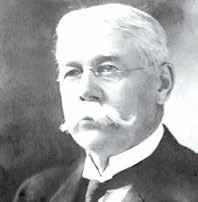
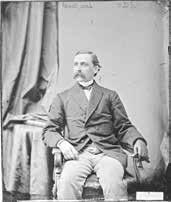
When he realized that his former unit was about to go into battle, he rejoined the regiment saying, “I’d rather die like a
and later was promoted to general. In 1880, he was elected to the U.S. Senate.
Born in Massachusetts, Francis Warren later represented Wyoming in the Senate. During the Civil War, he served with the 49th Massachusetts Infantry Regiment and earned the Medal of Honor during the Siege of Port Hudson, Louisiana in 1863. His citation reads: “Volunteered in response to a call, and took part in the movement that was made upon the enemy’s works under a heavy fire there from in advance of the general assault.”
the House of Representatives as a member of the California delegation from 1937 to 1937. As a graduate of the Naval Academy, Izac served first on a battleship and then on a troop transport, the USS President Lincoln, during World War I. On a return voyage from France in May 1918, they were spotted by the German submarine, U-90. The USS President Lincoln was sunk but most of the 700-man crew was able to abandon the ship before she slipped beneath the surface. Izac was taken prisoner of war by the enemy submarine and gleaned valuable information from the submariners as they did not know that he spoke German.
fool than live like a coward.” The Union suffered high casualties during the battle, but Quay was able to lead them while riding on a horse.
William Sewell from New Jersey earned the Medal of Honor at the Battle of Chancellorsville for remaining in command despite his wounds. He was wounded again during the Battle of Gettysburg
Henry du Pont was a senator from Delaware and earned the Medal of Honor during the Battle of Cedar Creek in 1864. The West Point graduate was cited for distinguished gallantry while encouraging his men when the Union lines had been broken. His courageousness was vital in checking the Confederate advance.
Born in Iowa, Edouard Izac served in
Izac first tried to escape when they reached Denmark but was unsuccessful and failed again to escape once he was transferred to a prison camp. A month later, he was being transferred by train but struck his head on the railroad ties while attempting his third escape. Izac paid dearly for this attempt and was held in solitary confinement for two weeks. On October 6, he joined several other Americans and finally succeeded in escaping. This time, they dressed as German guards after cutting the power to the camp. He and another American took a longer escape route to Switzerland to avoid detection and survived by eating raw vegetables. Izac swam across the Rhine River and finally was free. For his ordeal, Izac was awarded the Medal of
Izac was taken prisoner of war by the enemy submarine and gleaned valuable information from the submariners as they did not know that he spoke German.Adelbert Ames Matthew Quay Francis Warren
Honor and entered politics in the 1930s. Nine-term Hawaii Senator Daniel Inouye’s father was born in Japan and his mother’s parents were also Japanese immigrants. He was in high school when the Japanese attacked Pearl Harbor on December 7, 1941, and tended to injured civilians after witnessing the attack. Daniel worked for the Red Cross as a medical aide until he graduated high school. Due to his Japanese heritage, he was turned down from joining the army in 1942 but in March 1943 joined the recently established 442nd Regimental Combat Team. The regiment was comprised of second

generation Japanese-Americans called Nisei. They first saw combat in Italy in 1944 before being sent to fight the Germans in France. Daniel became the youngest officer in the regiment after receiving a battlefield commission for his actions in rescuing Americans from another regiment.
The 442nd Regiment was sent to Northern Italy in early 1945, and on April 21, Daniel’s unit was attacking a heavily defended ridge. He directed his platoon through heavy fire and captured an artillery post. However, their advance was stopped by three strategically placed machine guns. Inouye crawled up the slope
and threw grenades to destroy one of the emplacements. He stood up to destroy a second machine gun but was hit by a sniper’s bullet. Still, he pressed on until an exploding grenade shattered his right arm. He then directed his men in a successful attack that broke enemy resistance before receiving medical attention. The war ended on May 8, just a couple of weeks after the incident which cost him his arm.
In 2000, President Bill Clinton awarded the senator the Medal of Honor, which had been upgraded from the Distinguished Service Cross. Another nineteen members of the 442 nd Regiment were
awarded the Medal of Honor in the same ceremony.

These are just some of the battlefield heroes who later served in Congress. While their exploits and antics in politics may be well recorded, their battlefield achievements also deserve to be remembered.
Avi Heiligman is a weekly contributor to The Jewish Home. He welcomes your comments and suggestions for future columns and can be reached at aviheiligman@gmail.com.

PEACEFUL PRESENCE STUDIO
Men’s private yoga, Licensed Massage & Holistic Health Guidance
436 Central Ave, Cedarhurst Info. & free video training
www.peacefulpresence.com
516-371-3715
GERBER MOVING FULL SERVICE MOVING
Packing Moving Supplies
Local Long Distance
Licensed Insured
1000’S Of Happy Customers Call Shalom 347-276-7422
HANDYMAN AVAILABLE
For big or small jobs, Sheetrock, carpentry, painting, electrical, plumbing, install & repair appliances
Call Ephraim at 347-593-4691
VACUUM SALES AND REPAIR
All areas call Max Flam 718-444-4904
MANAGEMENT STAFF WILL ASSIST you with: * Obtaining Medicaid and Pooled Income Trust
* In-home Assessments, Individual and Family Counseling
* Securing reliable home care assistance
* Case and Care Management services
Dr. S. Sasson, DSW, LCSW (718) 544- 0870 or (646) 284-6242
HAIR COURSE:
Learn how to wash & style hair & wigs. Hair and wig cutting, wedding styling Private lessons or in a group Call Chaya 718-715-9009
ZEVIZZ WOODTURNING JUDAICA
Challah knifes, batei mezuzah, besamim holder, kiddish cups, havdalah candle holders, yad for sefer torah, pens, stenders, bowls and more 952-356-2228
LOOKING FOR PRIVATE PAY CLIENTS NPhomecare Service
Food prep meals, light house cleaning and laundry. Grocery shopping.
Hospital visit. Be Padiatist. Physical Therapist. Educational therapist
Maintains your Independence in the comfort of your own home
Tel: 718 912 6425
Tel: 917 972 1428
Email: npersaud2022@gmail.com
WOODMERE
Beautiful, brick, colonial boasting 5 bdr 3.5 Bth in pristine condition. Excellent location, near all! Move right in! RCUSA 516-512-9626

DON’T GET STUCK WITH A TWO STORY HOUSE YA KNOW, IT’S ONE STORY BEFORE YOU BUY IT BUT A SECOND STORY AFTER YOU OWN IT! Call Dov Herman
For An Accurate Unbiased Home Inspection Infrared - Termite Inspection Full Report All Included NYC 718-INSPECT Long Island 516-INSPECT www.nyinspect.com
WOODMERE
Charming Colonial on beautiful tree lined street in the heart of Old Woodmere. Home features 3 bedrooms, 1.5 baths, kitchen, dining area, living room, full basement. Relatively new heating system + hot water tank. Large & beautiful backyard. Great for entertaining. Close to all. $676K Mark Lipner Associate Broker Berkshire Hathaway Laffey International 516-298-8457 mlipner@bhhslaffey.com
CEDARHURST
For Sale by Owner
House in the heart of Cedarhurst (Close to Woodmere , Lirr & Cedarhurst Park) EIK Kosher Kitchen/ Dr/Lr/Family Room/Playroom
4 Bedrooms, 3 Full Baths
Basement: 2 Bedrooms, 1 Full Bath, Kitchenette, Separate Entrance
Asking $1.3m Whatsapp Text Only: 845-213-0002 No Brokers
WOODMERE - OLD WOODMERE
3 bedroom 2 full bathroomsSD# 14 Features LG living room with fireplace, den, large dining room, kitchen and dinette area, high ceilings, hardwood floors, primary bedroom plus sitting area plus 2 additional bedrooms, full basement, alarm, sprinkler, close to all. $759K Mark Lipner Associate
Broker Berkshire Hathaway Laffey International 516-298-845 mlipner@bhhslaffey.com
HEWLETT
Luxurious Exquisite 6 bedrooms, 6.5 bath home situated on approximate 1.8 acre property in prestigious Hewlett Bay Park. Formal Living room and dining room, library, chefs Eat-in Kitchen, extraordinary great room leads out to veranda. large Gunite built-in pool + pool house with full bath, large slate patio, impressive sprawling property, school district #14 Hewlett-Woodmere. Close to all. P.O.R. Mark Lipner Associate
Broker Berkshire Hathaway Laffey International 516-298-8457 mlipner@bhhslaffey.com
WOODMERE
Great Home on a Cul-De-Sac, SD #15, Features 4 Bedrooms, 3 New Full Bathrooms, Gas Heat, Central Air Conditioning, Renovated Gourmet
EIK w/2 Sinks, Granite Countertops, New Stainless Steel Appliances
Leading out to a New Deck, Elegant
Formal Dining Room, New Flooring, Moldings, and New Wood Bannister
Leading to the Bedrooms, Spacious Master Bedroom Suite w/Jacuzzi Tub, Sep Stall Shower, and a Large Walk-In Closet. Generously Sized Den Leading Out to a Magnificent Backyard With a New Pergola, Great Home for Entertaining, High Hats Throughout, New Front Walkway Leading to a Nice Front Porch, New Front Windows
Close to RR, Shopping, Houses of Worship. P.O.R. Mark Lipner Associate
Broker Berkshire Hathaway Laffey International 516-298-8457 mlipner@bhhslaffey.com
HEWLETT BAY PARK
Six bedroom home in highly desirable Hewlett Bay Park on 3/4 of an acre with an inground gunite pool and tennis court, en-Suite bathrooms and bedrooms on both floors, 1st floor Master Suite with steam shower and Jacuzzi tub, Eat-in Kitchen, with SS appliances, 2 sinks, 2 dishwashers, double oven, formal living room, formal dining room, den with fireplace. Close to railroad, shopping, and houses of worship. SD#14. Great house for entertaining. Park-like Property. P.O.R. Mark Lipner Associate Broker Berkshire Hathaway Laffey International 516-298-8457
mlipner@bhhslaffey.com
WOODMERE
Spacious 5 bedroom 4 bathroom split level in Saddle Ridge Estates Well maintained home home , renovated eat –in-kitchen , formal living room and dining room, den, central air conditioning, hardwood floors, high hats, master bedroom with a custom bathroom and Jacuzzi tub, close to all $995k Mark Lipner Associate
Broker Berkshire Hathaway Laffey International 516-298-8457 mlipner@bhhslaffey.com
WOODMERE: NEW TO THE MARKET
Well maintained 4 bedroom home on a cul-de-sac in Old Woodmere SD#14. Features central air conditioning, gas heat, eat -in -kitchen with stainless steel appliances, very spacious den, 2 car garage, hardwood floors, high hats, magnificent yard with an in-ground saltwater pool, close to the railroad, shopping and houses of worship. Call for a private showing. Mark Lipner Associate Broker Berkshire Hathaway Laffey International 516-298-8457 mlipner@bhhslaffey.com
HEWLETT BAY PARK
Prestigious Center-Hall Colonial in Hewlett Bay Park, Set Back on Private Property. This Stately Home Features a Grand Entry Foyer, Formal Living Room, Formal Dining Room, Chef’s Kitchen, Large Den, Master Bedroom suite with Sitting Room + 2 Baths (His & Hers) and Loft and Additional 3 Bedrooms + Bonus Rooms. Exquisitely Manicured Park-like property. Award Winning School District #14. Too Many Features To List. Will Not Last! P.O.R. Mark Lipner Associate Broker Berkshire Hathaway Laffey International 516-298-8457
mlipner@bhhslaffey.com
WOODMERE
Spectacular 5 bedroom, 5 bath renovated home in SD#14 with in-ground pool & pool house, lot size 111 x 107. Formal living room & dining room, magnificent kitchen with SS appli-ances, tremendous den with fireplace and 4 skylights, vaulted ceiling, LED lighting, master suite, new CAC, new roof. Outside totally redone with Stone and Stucco. Backyard with new pavers, park-like property, sandbox, great home for entertaining. Close to all. $1,489,000
OPEN HOUSE SUNDAY FEBRUARY 26
12-1:30PM • 562 SUNSET DR. Mark Lipner Associate Broker Berkshire Hathaway Laffey International 516-298-8457
mlipner@bhhslaffey.com
WOODMERE
New to the market move right in 8 bedrooms 3 full bathrooms on a lot size 57x112. prime location features eat in kitchen with 2 sinks, new stainless steel appliances, gas heat, hardwood floors, possible mother daughter with permits, close to the railroad, shopping and houses of worship. OPEN HOUSE SUNDAY, FEBRUARY 19 12:00-1:30PM
8 WOODMERE BLVD. N. Mark Lipner
Associate Broker Berkshire Hathaway Laffey International 516-2988457 mlipner@bhhslaffey.com
CAN’T AFFORD YOUR PROPERTY TAXES? MORTGAGE?
Must sell for any reason? Call for FREE Consultation. Call now 212-470-3856 Cash buyers available!
NORTH WOODMERE JUST LISTED
Move Right Into This Beautifully
Maintained and Updated Three Bedroom, 2.5 Baths Large Split Situated on an Oversized Park-like Lot Overlooking the Pond. Home Features naturally bright lit rooms with a Ground Level Den Leading to Patio, With Another Lower Level With Partially Finished Basement. Hardwood Floors Throughout Updated Kitchen With Granite Counters in School District 14 and Close to all Houses of Worship. $949k Mark Lipner Associate Broker Berkshire Hathaway Laffey International 516-298-8457 mlipner@bhhslaffey.com
LAWRENCE
Stunning One of a Kind Mid Century Modern 6 Bedroom, 6.5 Bath, Contemporary Ranch. Resort Style Home on Over an Acre of Property in Back Lawrence. Incredible Views, Regulation Size Tennis Court - Deco Turf. IG-Gunite Pool, Low Taxes, 5318 sq. ft. of Main Floor Living Space. Plus 5000 sq. ft. Basement With Very High Ceilings. Call Mark 516-298-8457 for more details Mark Lipner Associate Broker Berkshire Hathaway Laffey International 516-298-8457 mlipner@ bhhslaffey.com
Charming Colonial on beautiful tree lined street in the heart of Old Woodmere. Home features 3 bedrooms, 1.5 baths, kitchen, dining area, living room, full basement. Relatively new heating system + hot water tank. Large & beautiful backyard. Great for entertaining. Close to all. $676K OPEN HOUSE SUNDAY FEBRUARY 26 • BY APPOINTMENT
58 CENTRE ST. Mark Lipner Associate Broker Berkshire Hathaway Laffey International 516-298-8457 mlipner@ bhhslaffey.com
WOODMERE
Move Right In. Renovated 8 Bedroom
Colonial, Prime Location in SD#14 - Old Woodmere. Smart Home, Camera System, New CAC System, AG Pool, Large Eat-in Kitchen with Pantry. Finished Basement. Mark Lipner Associate Broker Berkshire Hathaway Laffey International 516-2988457 mlipner@bhhslaffey.com
CEDARHURST MOVE RIGHT IN. Totally Updated One Bedroom Townhouse Apartment on the First Floor. Featuring 1.5 Bathrooms, Central Air Conditioning, Washer/ Dryer in the Unit, Kitchen With SS Appliances, Hardwood Floors, and Recessed Lighting. Freshly Painted. Super on Premises. Underground Parking is $95/month. This spacious rental is managed by a responsible landlord. Great Courtyard. Close to the Railroad, Shopping, Restaurants, Post Office, Cedarhurst Park + Houses of Worship. NO BROKERS FEE Mark Lipner Associate Broker Berkshire Hathaway Laffey International 516-298-8457
mlipner@bhhslaffey.com
WOODMERE HOUSE RENTAL
Lovely Split Level on Quiet Residential Tree Lined Street. Huge Park-like Property. Four Bedrooms, Two Full Baths, deck & playroom. Close to all. Mark Lipner Associate Broker Berkshire Hathaway Laffey International 516-298-8457 mlipner@bhhslaffey.com

5 Towns FOR LEASE: OFFICE + STORAGE + PARKING LOT Bayview and Lawrence. Minyan Available immediately Call/Text/WA Owner: 516-206-1100
ROCKVILLE CENTRE
Flex Office Space / Light Warehousing 3750 S/F - Ready for move in. Competitively priced
Ideal Location / Walk To LIRR & busBank, Shopping, City Center. 917-822-0499
CEDARHURST
New to the market Nice 2 bedroom apartment in the heart of town. Spacious rooms, eat –in-kitchen, L/rD/r, 3 ac units. Laundry on premises, underground parking, storage, close to the railroad, shopping, schools, houses of worship & park $299k Mark Lipner Associate Broker Berkshire Hathaway Laffey International 516-298-8457 mlipner@bhhslaffey.com
LAWRENCE
One Bedroom Renovated Apartment In Prime Lawrence. Efficiency Kitchen, Renovated Bathroom. Sunken LR, Dining Room, Close to All, Transportation, Shopping, Worship. $275k Mark Lipner Associate Broker Berkshire Hathaway Laffey International 516-298-8457 mlipner@ bhhslaffey.com
CEDARHURST
Move Right In. Totally updated 2BR, 2 Bath, Apt. on the 1st Floor. Private Entrance, CAC, W/D in Unit, Kitchen with SS Appliances, Hardwood Floors, Recessed Lighting, Freshly Painted, Great Courtyard, Parking $95/Mo. Close to Railroad, Shopping, Restaurants, Cedarhurst Park + Houses of Worship NO BROKERS FEE Mark Lipner Associate Broker Berkshire Hathaway Laffey International 516-298-8457 mlipner@bhhslaffey.com
WOODSBURGH
Magnificent 2K Sq. Ft. Co-Op. 3Br/2Bth, Eik, Lr, Dr, W/D In Unit, Gar, 2 Stor Units, Elev, Near All $775K 516-846-1032 No Brokers
LAWRENCE
Spacious 2BR, 2 Full Bath Apt with an enclosed terrace in the heart of Lawrence. Well maintained & manicured building. New hardwood floors, updated Eat-in Kitchen with gas stove. warming draw, dishwasher & microwave. New windows on the enclosed terrace & one of the bedrooms. 3 New A/C Units & New Refrigerator. Close to shopping, transportation, library, schools, and houses of worship. $339K Mark Lipner Associate Broker Berkshire Hathaway Laffey International 516-298-8457 mlipner@bhhslaffey.com
WOODMERE
Beautiful & Spacious 2 Bedroom Apartment Across From The Golf Course. Elevator Building, Updated Kitchen, Gas Cooking, Granite Countertops, Washer/Dryer In Unit, High Ceilings, Great Closet Space, Storage in Basement, Close To RR, Shopping & Houses Of Worship.$349K
Mark Lipner Associate Broker Berkshire Hathaway Laffey International 516-298-8457 mlipner@bhhslaffey.com
LAWRENCE
Spacious 2BR, 2 Full Bath Apt with an enclosed terrace in the heart of Lawrence. Well maintained & manicured building. New hardwood floors, updated Eat-in Kitchen with gas stove. warming draw, dishwasher & microwave. New windows on the enclosed terrace & one of the bedrooms. 3 New A/C Units & New Refrigerator. Close to shopping, transportation, library, schools, and houses of worship. $339K OPEN
HOUSE SUNDAY FEBRUARY 19 2:003:30PM 284CENTRAL AVE B-5 Mark Lipner Associate Broker Berkshire Hathaway Laffey International 516298-8457 mlipner@bhhslaffey.com
HEWLETT
Hewlett 3 bedroom 2 bath co-op with central air conditioning, terrace, wash-er/dryer, hardwood floors, recessed lighting, magnificent kitchens, ss appliances, l/r, d/r, close to the railroad, shopping, and houses of worship. $300k Mark Lipner Associate Broker Berkshire Hathaway Laffey International 516-298-8457 mlipner@bhhslaffey.com
1 bedroom apartment, elevator building, eat-in kitchen, full bath, hardwood floors, plenty of closet space. Ceiling fan in bedroom & kitchen, laundry room in the basement. Close to the railroad, shopping, and houses of worship $168k Mark Lipner Associate Broker Berkshire Hathaway Laffey International 516-298-8457 mlipner@bhhslaffey.com
WOODMERE
Totally renovated bright and sunny 1 bedroom corner unit apartment with a washer/dryer. Features quartz countertops, ss appliances, recessed lighting, bathroom with chrome fixtures, close to the railroads, shopping and houses of worship. Call for details Mark Lipner Associate Broker Berkshire Hathaway Laffey International 516-298-8457 mlipner@bhhslaffey.com
HEWLETT
Totally renovated 1 and 2 Bedroom, Apartments with washer/dryer, kitchen with quartz countertops, stainless steel appliances. Recessed lighting, hardwood floors, storage in basement. Close to RR, shopping, and houses of worship. Mark Lipner
Associate Broker Berkshire Hathaway Laffey International 516-298-8457 mlipner@bhhslaffey.com




CEDARHURST
1, 2 and 3 bedroom apartments, totally renovated private entrance , central air conditioning, hardwood floors, washer/dryer, garage parking, dishwasher, recessed lighting, private playground, close to railroad, park, shopping and houses of worship.
Call for more details
Mark Lipner Associate Broker Berkshire Hathaway Laffey International 516-298-8457 mlipner@bhhslaffey.com
HEWLETT
Hewlett House 1 Bedroom Co-op. Unit Includes 1 Parking Spot + Storage Unit, W/D Outside of Unit. Close to Shopping, Schools, Houses of Worship, Restaurants + Parks. Prime Location in the Heart of Hewlett. $109k Mark Lipner Associate Broker Berkshire Hathaway Laffey International 516-298-8457 mlipner@bhhslaffey.com

WOODMERE
Move right in!! 2 Bedroom Apartment, Elevator Bldg in SD #14, Pre War Bldg, Pet Friendly, Laundry Room in Basement, Wood Floors, New Windows, Corner Apartment, Beautiful Renovated Kitchen w/SS Appliances, 3 A/C Units, Close to RR, Shopping & Houses of Worship. A must-see! $199k




CEDARHURST
1 bedroom 1 bathroom apartment, elevator building, eat-in kitchen, spacious rooms throughout, laundry room on-premises, garage parking, close to all
Mark Lipner Associate Broker Berkshire Hathaway Laffey International 516-298-8457 mlipner@bhhslaffey.com
STAFF NEEDED
Looking for a male para to do ABA therapy in Far Rockaway. $30 per hr. M-T 5:30-7:30 Sunday 9-4
Training and supervision provided. Intake@empoweraba.com 718-787-6337 #107
SEEKING ELA TEACHER
Immediate opening. ELA teaching position for Gr. 5. Mon.-Thurs., afternoon hours. Far Rockaway/5T area. Competitive salary, warm, supportive environment. All teaching materials provided. Teachersearch11@gmail.com.
BOOKKEEPER
Excellent growth potential, Frum environment, Excellent salary & benefits. Email resume to: resumetfs1@gmail.com
Large school in FR/5T area seeks an organized and conscientious individual to help maintain the campus. Applicant should be handy, tech savvy, be capable of managing a custodial staff and live locally. Great work environment, excellent pay. Please send resume to rabbiyehuda@gmail.com
A multi-tasker needed for general office work. The ideal candidate is someone who is detail-oriented, responsible, and can take ownership. Looking for someone who is eager to learn, and expand his/her skill set while possessing the ability to work independently and as part of a team. Experience with Excel required. Five Towns location. In-office position only, not remote. Please send resume to 5tpart.timecareer@gmail.com
MDS REGIONAL NURSE: 5 Towns area Nursing Home management office seeking a Regional/Corporate level MDS Nurse to work in our office. Must be an RN. Regional experience preferred. 2-3 years MDS experience with good computer skills required. Position is Full Time but Part Time can be considered. Great Shomer Shabbos environment with some remote options as well. Email: officejob2019@gmail.com
BRIGHT FUTURES
Has openings for providers. Work one on one with children towards their goals and earn great money doing what you love! Respite, sports, art, etc. We pay $50/hr for providers with a Bachelor’s and $25/ hr for providers with a HS diploma. Email info@brightfuturesny.com or text/call 347-970-9531
A YESHIVA IN QUEENS is looking for an experienced part/ full time secretary, 2-year-old morah, kindergarten morah, kindergarten morah assistant and Pre-1A English teacher for the 2022-2023 school year. Nice and timely pay. Please email resume to mshelt613@gmail.com or call/text 718-971-9799.
IMMEDIATE OPENING
ELA teaching position for Gr. 5. Mon.-Thurs., afternoon hours. Far Rockaway/5T area. Competitive salary, warm supportive environment. Teachersearch11@gmail.com
5 TOWNS BOYS YESHIVA SEEKING ELEM GEN ED TEACHERS
Excellent working environment and pay. Only lic/exp need apply. Email resume to yeshivalooking@gmail.com

LOOKING FOR A DRIVER

Business looking for someone that has a large van or sprinter that can work a full day on Wednesdays on a weekly basis throughout the year in Brooklyn. Please do not call if you do not have a large van or a sprinter 347.992.7411
SHULAMITH IN CEDARHURST, NY, is seeking faculty in all elementary divisions for the 202324 school year.Teachers must be professional, dynamic, creative, committed, compassionate, highly skilled and nurturing with relevant degrees and teaching experience. Special Education degrees and experience a plus. Additionally, we are looking for assistant teachers for all grade levels to work with students directly or indirectly; some substitute teaching involved. P/T - perfect for college students. Salaries are competitive and commensurate with experience. Please send resumes to tshapiro@shulamith.org
AIRPODS FOUND ON Central Avenue. If yours, please call 702-464-5944
PURIM COSTUME GEMACH
For all dates and information about the Bayswater & Far Rockaway Purim Costumes Gemach, please send an e-mail to BFRPurimCostumesGemach@gmail.com to be added to their email list.
USED CAR FOR SALE
2015 Subaru Outback, Limited, Fully loaded, 123k miles, one owner, no major accidents $10k, located in 5towns Call/text 718-627-0910
BUDGIES FOR SALE
Home breed, adorable, lovely, budgies for sale! For prices and special offers for a couple, contact Sipora Goykadosh at siporagoykadosh@gmail.com
The Zen philosopher Basho once said, “A flute without holes is not a flute. And a doughnut without a hole is a Danish.” Even today, Basho’s wisdom serves to remind us that appearances can be deceiving. Things are not always as they seem. And you can’t judge a book by its cover.
Today’s story takes us to the rolling hills of Central Kentucky, a verdant bluegrass paradise. Drive down the country roads surrounding Lexington, Paris, and Versailles, and you’ll see endless miles of white fences, gorgeous Southern-style mansions, and imposing barns. (Seriously, if you spend more on your house than your barn, you’re doing it wrong.) There’s even a local Map to the Stars to point out the most spectacular properties owned by billionaires, movie stars, and sheikhs. Every so often, though, especially as you get closer to Bardstown, you’ll pass a different kind of barn. These are typically seven-story monstrosities that look more like warehouses, with no horses in sight. They’re called “rickhouses,” and they’re where distillers like Jim Beam, Maker’s Mark, and Pappy Van Winkle raise Kentucky’s second most-famous crop – bourbon. And, of course, there’s a tax angle
behind those deceptive-looking “barns.” Bourbon whiskey starts out as a mash of grains containing at least 51% corn. The mash is boiled and distilled at no higher than 160 proof, then aged for at least two years in new charred oak barrels. That’s where the rickhouses come in – they hold those 53-gallon barrels as the whiskey ages. Beam’s newest facility in Bardstown holds more than 59,000 barrels, or 12 million bottles.
ficials had to let it burn for three days rather than risk contaminating the nearby Kentucky River with runoff.
And so, the most modern rickhouses are far more than just barns. They’re sophisticated bourbon incubators with carefully engineered ventilation, sprinkler systems, and constant electronic monitoring. Many of them are divided into the same sort of compartments that made the Titanic unsinkable.
what do you think they’re drinking? Not Negronis or mocktails. (As for the bourbon itself, why would you let it sit around long enough to depreciate?)
If there’s any tax hangover, it’s at the state level. Kentucky imposes a barrel tax of five cents per $100 of value on each barrel of bourbon aging each year. It’s essentially a property tax on the whiskey. The Bluegrass State is the only place in the world that taxes aging spirits, and it raises $40 million per year that goes to local school districts and other services. Naturally, distillers would like to see that whole regime poured down the drain.
Storing that much hooch in one place poses a different sort of risk than finding teenagers raiding your stash. What happens when lightning strikes your roof, storms flood your facility, or a random tornado skips across your property? In 2019, Beam lost 45,000 barrels of young bourbon, worth as much as $160 million, when a rickhouse caught fire and local of-
Congress has traditionally been generous to distillers, letting them depreciate rickhouses over seven years rather than the usual twenty for horse barns. That faster depreciation, in turn, frees up cash to build more facilities to supply a thirsty world. It makes perfect sense, really: when lawmakers retire to their smoke-filled rooms to draft the tax laws,
At the end of the day, horses add $3 billion per year to Kentucky’s economy. Bourbon adds $9 billion. Bourbon wins by way more than a nose. But breeders and distillers both get generous tax breaks to help share their passions with the rest of us, and that makes us all winners!

newest facility in Bardstown holds more than 59,000 barrels, or 12 million bottles.
 By Rivki D. Rosenwald Esq., LMFT, CLC, SDS
By Rivki D. Rosenwald Esq., LMFT, CLC, SDS
What are your 3 R’s?
When we were young, it used to be reading, ‘riting, and ‘rithmetic. Those were the important R’s in our lives.
But as we grow older, we recognize that there are much more important R’s for us.
-Resilience
-Responsibility
-Respect
-Relaxation
-Remembering
-Religion
-Relationships
-Ritual
-Rest
-Reality
The list can go on and on.
The point is to explore what are our priorities – what really matters to us and how do we make sure we are being true to those priorities in our lives.
Do we make healthy choices?
Do we get stuck in Rs that are not in service of our best interest and social emotional health?
-Remorse
-Revenge
-Rivalry
Many of us spend our time being Reactive rather than Responsive. Is this a healthy 3 R decision?
“R” we really being Responsible to ourselves when we do this?
And furthermore, do I respond to situations with loyalty to these values?
For instance:
-Reacting responsibly for myself and others I care for.
-Remembering what truly matters.
-Being true to my religion.
Maybe we are disregarding the really integral Resources and Remedies that are more productive for our own benefit, and those around us, when we don’t stop and think about the choices. we have in a given situation.
Each of us should look at the lists above, or come up with your own list, and think about which three Rs most resonate for you.
Do I live my life in service of these values?
-Advancing my relationships.
-Avoiding choosing ritual over someone’s feelings.
-Taking a rest before responding.
-Being resourceful.
-Increasing my resilience.
Why is all this important anyway?
Because sometimes we forget the bigger picture. We respond to the situation at hand and self-sabotage in the long run.
We react. We snap. We are impulsive. And we get stuck further away from
our priorities.
When we know what’s important to us, we can then stop and think before we respond. We can think: will this further my R’s?
If the answer is no, then how can I respond better?
So maybe it’s good to Really Review what Reality Resonates for you and Rack up the Results in your favor.
R u game?
R u on board?
R’nt you ready for a life you Relish more?
Reading, ‘Riting and ‘Rithmetic got you through those first years feeling accomplished. Wouldn’t it be nice to figure out what will get you through the next bunch of years feeling accomplished?!

